Strategic Sourcing and Management – Workshop 1 (Obtaining Value)

The Appleton Greene Corporate Training Program (CTP) for Strategic Sourcing and Management is provided by Dr. Bonhag Certified Learning Provider (CLP). Program Specifications: Monthly cost USD$2,500.00; Monthly Workshops 6 hours; Monthly Support 4 hours; Program Duration 12 months; Program orders subject to ongoing availability.
If you would like to view the Client Information Hub (CIH) for this program, please Click Here
Learning Provider Profile

Dr. Bonhag is an approved certified learning provider (CLP) at Appleton Greene and is a business leader and strategist with broad experience in the healthcare delivery, global pharmaceutical, and health insurance sectors. He has worked with premier companies, including Universal Health, Blue Cross & Blue Shield, ICON, Fresenius Medical Care, Innovage, Priority Health, Highmark, MidState Medical Center, and Mercy Healthcare.
He has personally led the selection and management of more than 30 transformational implementations involving strategic sourcing and managing those vendors to success. In some cases, an existing application can benefit the company; in other cases, developing a robust solution requires the external expertise of a developer vendor. It is crucial to select the correct strategy and to ensure that the resultant solution meets the Key Performance Indices (KPIs) and Return on Investment (ROI) for which the project was initiated.
As a seasoned operational leader, whether as a Chief Operating Officer for a 425-bed teaching hospital, Director of Managed Care supporting 350,000 members, or freelance Program manager assisting hospitals, health plans, or delivery systems, he has the experience to help you overcome the challenges of selecting the right vendor and solution.
He is an experienced trainer and mentor sought out by his previous clients to help them with program and project management and strategic sourcing for operational excellence. He has real-world experience with implementing new products and improving the operations. He draws on that experience from 30 companies to lead your team through the steps to be successful.
His formal education includes earning a Master of Business Administration in Finance and Information Systems from Duke University, a bachelor’s in mathematics and physics from Franklin & Marshall College, and a Doctorate from Fairleigh Dickinson University.
MOST Analysis
Mission Statement
One tactic in innovation is to find and leverage outside talent to boost the organization’s profitability while minimizing outsourcing risks. We will need external talent and resources to amplify our internal capacity. It will be essential to understand how other companies have developed the infrastructure required to obtain value for the company, not only for one project but for all their outsourcing projects. We will cover the following components:
• Key Performance Indicators (KPIs): Specify the essential KPIs relevant to sourcing and vendors in IT projects. Examples include return on investment, total cost of ownership, cost savings, project delivery time, quality of deliverables, vendor responsiveness, and customer satisfaction.
• Benchmarking and Industry Best Practices: Explore industry best practices in strategic sourcing and vendor management—examples of successful organizations effectively leveraging external talent and resources to drive innovation. Benchmarking against industry leaders can provide valuable insights.
• Risk Mitigation Strategies: Discuss strategies for mitigating outsourcing risks. Identify common challenges in outsourcing IT projects and propose risk management strategies. Mitigations could include contractual agreements, performance monitoring, and contingency planning.
• Case Studies: Present real-world case studies of organizations that have successfully obtained value through strategic sourcing and vendor management. Highlight the challenges faced, the strategies employed, and the outcomes achieved. The use of case studies and simulations will add to the learning.
• Talent Management Strategies: Explore practical ways to manage external talent, including consultant onboarding, skill assessment, and knowledge transfer. Discuss methods for integrating external resources seamlessly into existing teams and processes.
• Technology Platforms and Tools: Introduce relevant technologies and tools that facilitate vendor management and collaboration. These tools could include project management software, communication platforms, and performance analytics tools that support effective collaboration with external partners.
• Continuous Improvement Framework: Outline a framework for continuous improvement in vendor management processes. Emphasize learning from each project and updating strategies and procedures accordingly.
• Legal and Compliance Considerations: Learn how to address data protection, intellectual property rights, and regulatory compliance. Learn how to navigate these issues effectively.
• Scalability and Flexibility: Discuss how to build a vendor management infrastructure that is scalable and flexible as the organization changes. Consider business growth, changing project requirements, and technological advancements.
• Stakeholder Communication: Highlight the significance of effective communication with internal and external stakeholders. Discuss strategies for maintaining transparency, resolving conflicts, and fostering a collaborative environment.
By incorporating these elements, the “Obtaining the Value” portion will provide a more comprehensive guide for organizations looking to optimize their vendor selection and management processes for IT projects.
Objectives
01. Value Identification and Alignment: departmental SWOT analysis; strategy research & development. Time Allocated: 1 Month
02. Innovation: departmental SWOT analysis; strategy research & development. Time Allocated: 1 Month
03. Definitions: departmental SWOT analysis; strategy research & development. Time Allocated: 1 Month
04. Can We Do This Internally?: departmental SWOT analysis; strategy research & development. Time Allocated: 1 Month
05. Let’s Look at External: departmental SWOT analysis; strategy research & development. Time Allocated: 1 Month
06. Mission and Objectives: departmental SWOT analysis; strategy research & development. Time Allocated: 1 Month
07. Establish Authority to Proceed: departmental SWOT analysis; strategy research & development. 1 Month
08. Talent Management Strategies: departmental SWOT analysis; strategy research & development. Time Allocated: 1 Month
09. Technology/Tools to Help: departmental SWOT analysis; strategy research & development. Time Allocated: 1 Month
10. Legal & Compliance Considerations: departmental SWOT analysis; strategy research & development. Time Allocated: 1 Month
11. Change Management and Stakeholder Communications: departmental SWOT analysis; strategy research & development. Time Allocated: 1 Month
12. Scalability and Overview: departmental SWOT analysis; strategy research & development. Time Allocated: 1 Month
Strategies
01. Value Identification and Alignment: Each individual department head to undertake departmental SWOT analysis; strategy research & development.
02. Innovation: Each individual department head to undertake departmental SWOT analysis; strategy research & development.
03. Definitions: Each individual department head to undertake departmental SWOT analysis; strategy research & development.
04. Can We Do This Internally?: Each individual department head to undertake departmental SWOT analysis; strategy research & development.
05. Let’s Look at External: Each individual department head to undertake departmental SWOT analysis; strategy research & development.
06. Mission and Objectives: Each individual department head to undertake departmental SWOT analysis; strategy research & development.
07. Establish Authority to Proceed: Each individual department head to undertake departmental SWOT analysis; strategy research & development.
08. Talent Management Strategies: Each individual department head to undertake departmental SWOT analysis; strategy research & development.
09. Technology/Tools to Help: Each individual department head to undertake departmental SWOT analysis; strategy research & development.
10. Legal & Compliance Considerations: Each individual department head to undertake departmental SWOT analysis; strategy research & development.
11. Change Management and Stakeholder Communications: Each individual department head to undertake departmental SWOT analysis; strategy research & development.
12. Scalability and Overview: Each individual department head to undertake departmental SWOT analysis; strategy research & development.
Tasks
01. Create a task on your calendar, to be completed within the next month, to analyze Value Identification and Alignment.
02. Create a task on your calendar, to be completed within the next month, to analyze Innovation.
03. Create a task on your calendar, to be completed within the next month, to analyze Definitions.
04. Create a task on your calendar, to be completed within the next month, to analyze Can We Do This Internally?.
05. Create a task on your calendar, to be completed within the next month, to analyze Let’s Look at External.
06. Create a task on your calendar, to be completed within the next month, to analyze Mission and Objectives.
07. Create a task on your calendar, to be completed within the next month, to analyze Establish Authority to Proceed.
08. Create a task on your calendar, to be completed within the next month, to analyze Talent Management Strategies.
09. Create a task on your calendar, to be completed within the next month, to analyze Technology/Tools to Help.
10. Create a task on your calendar, to be completed within the next month, to analyze Legal & Compliance Considerations.
11. Create a task on your calendar, to be completed within the next month, to analyze Change Management and Stakeholder Communications.
12. Create a task on your calendar, to be completed within the next month, to analyze Scalability and Overview.
Introduction
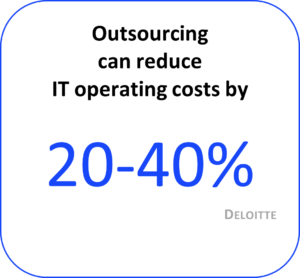
In today’s rapidly evolving business landscape, organizations face numerous challenges in effectively managing their sourcing and vendor relationships. With increasing pressure to reduce costs, enhance efficiency, and innovate, the need for a structured approach to strategic sourcing has never been greater. Many organizations struggle with defining clear value propositions for their projects, aligning their sourcing strategies with broader business goals, and managing the risks associated with vendor relationships. These pain points can lead to inefficiencies, increased costs, and missed opportunities, ultimately impacting an organization’s competitiveness and success. As business professionals, project managers, and individuals involved in strategic sourcing and vendor management, your roles are crucial in addressing these challenges and driving success.
Strategic sourcing has been shown to significantly impact organizational efficiency and cost-effectiveness. According to Deloitte, internal IT projects can be 20-30% more expensive than external sourcing. Additionally, outsourcing can reduce IT operating costs by 20-40% on average, highlighting the importance of strategic sourcing in today’s competitive market. These metrics underscore the critical need for a structured approach to sourcing that aligns with an organization’s broader goals and delivers measurable value, emphasizing the significant role you play in this process.
The primary pain point we address with this training is the lack of a cohesive and strategic sourcing and vendor management approach. Many organizations find it difficult to establish clear objectives, measure performance, and mitigate risks in their sourcing initiatives. This often results in projects that fail to deliver the expected benefits, strain resources, and erode stakeholder confidence. Without a solid foundation, even the most promising strategic sourcing initiatives can falter, leading to suboptimal outcomes and diminished returns on investment. However, with our workshop’s comprehensive and practical approach, you can confidently overcome these challenges and not just achieve but sustainably succeed in your sourcing and vendor management initiatives.
Workshop 1, “Obtaining Value,” is a unique opportunity for you to address the challenges you face in your roles as business professionals, project managers, and individuals involved in strategic sourcing and vendor management. It equips you with the knowledge and tools needed to define and achieve project value from the outset. This workshop is the critical first step in our comprehensive 12-workshop series, setting the stage for successful strategic sourcing and vendor management. By defining the project’s value early in the process, Workshop 1 ensures you can align resources, set realistic expectations, and establish measurable goals. This foundational step is crucial for navigating the complexities of strategic sourcing and achieving sustainable success in your respective roles. Participating in this workshop will enhance your understanding of strategic sourcing and empower you to drive value in your projects and contribute to your organization’s success.
Through theoretical insights and practical, interactive elements, Workshop 1 equips participants with the skills to manage their sourcing initiatives effectively. Attendees will learn to identify and define key performance indicators (KPIs), benchmark against industry best practices, and develop risk mitigation strategies. The workshop also covers essential topics such as talent management, technology platforms, legal and compliance considerations, continuous improvement frameworks, and stakeholder communication.
By starting with Workshop 1, participants will understand the importance of defining value in strategic sourcing and how to manage the process effectively. This knowledge will serve as a solid foundation for the subsequent workshops, each building on the principles and practices established in Workshop 1. Ultimately, this workshop will help organizations create a strategic, value-driven approach to sourcing that delivers lasting benefits and positions them for long-term success in the marketplace. Join us on this journey to master strategic sourcing and vendor management and take the first step toward achieving your organization’s goals.
Workshop 1, “Obtaining Value,” is an essential starting point for any strategic sourcing initiative. By defining the project’s value at the outset, organizations can align resources, set realistic expectations, and establish measurable goals. This foundational step ensures that the organization is well-prepared to navigate the complexities of strategic sourcing and vendor management, ultimately leading to successful IT project implementations. As the first step in the 12-workshop series, Workshop 1 provides the knowledge and tools necessary to achieve the desired outcomes and deliver lasting value to the organization.
By participating in this workshop, you will understand the importance of defining value in strategic sourcing and how to manage the process effectively. You will be equipped with the skills and knowledge to ensure that your organization remains competitive and forward-thinking in today’s rapidly evolving market. Join us to embark on this strategic sourcing and vendor management journey and set the stage for your organization’s success. By leveraging the insights and strategies gained from this workshop, you can position your organization for long-term success and create a sustainable competitive advantage in the marketplace.

The Importance of Defining Value
Defining value at the outset of a strategic sourcing initiative ensures that the organization clearly understands its goals. This clarity helps align resources, set realistic expectations, and establish measurable goals. The primary objective of any initiative, whether developing new products or enhancing existing processes, is to deliver value to the organization. This value can take various forms, including increased profitability, improved operational efficiency, enhanced customer satisfaction, and competitive advantage.
The importance of defining value lies in its ability to guide decision-making throughout the project lifecycle. When an organization clearly understands the value it seeks to achieve, it can make more informed choices about resource allocation, vendor selection, and project priorities. This focus on value ensures that every aspect of the initiative is aligned with the organization’s strategic objectives, thereby maximizing the likelihood of success.
One of the first steps in defining value is to identify the key performance indicators (KPIs) that will be used to measure the project’s success. KPIs provide a tangible way to assess progress and determine whether the project delivers the expected benefits. Common KPIs in strategic sourcing include return on investment (ROI), total cost of ownership (TCO), cost savings, project delivery time, quality of deliverables, vendor responsiveness, and customer satisfaction. By establishing these KPIs at the beginning of the project, organizations can set clear benchmarks for success and track their progress over time.
For example, consider a company embarking on an IT outsourcing project. The company might define its value by reducing IT operating costs, improving system uptime, and enhancing customer service response times. The organization can measure its success in achieving the desired outcomes by setting specific KPIs related to these goals. This approach provides a clear direction for the project and helps communicate the project’s objectives and progress to stakeholders.
Another critical aspect of defining value is understanding and mitigating potential risks. Every strategic sourcing initiative carries inherent risks related to vendor performance, technological challenges, or market dynamics. By identifying these risks early in the process, organizations can develop strategies to address them, reducing the likelihood of project delays or failures. Effective risk management ensures the project stays on track and delivers the intended value.
Defining value also involves exploring industry best practices and benchmarking against successful organizations. Learning from others who have undertaken similar initiatives can provide valuable insights and guidance. Benchmarking allows organizations to set realistic expectations and adopt practices shown to deliver results. For instance, a company looking to implement lean production techniques might benchmark its processes against industry leaders who have successfully adopted these practices. By studying their approaches and learning from their experiences, the company can identify best practices that apply to its operations and avoid common pitfalls.
Moreover, incorporating case studies and real-world examples of organizations that have successfully obtained value through strategic sourcing can provide practical insights and inspiration. These examples highlight the challenges faced, the strategies employed, and the outcomes achieved, offering a roadmap for other organizations to follow. For example, a case study on a multinational corporation that successfully outsourced its IT infrastructure management might highlight the steps taken to ensure a smooth transition, the challenges encountered, and the benefits realized. By learning from these experiences, other organizations can gain valuable insights into managing similar initiatives effectively.
In addition to these strategic considerations, defining value at the outset of a project fosters alignment and engagement among stakeholders. When stakeholders clearly understand the project’s objectives and the value it aims to deliver, they are more likely to support the initiative and contribute to its success. Clear communication of the project’s value helps build trust, resolve conflicts, and foster a collaborative environment.
In conclusion, defining value is critical in any strategic sourcing initiative. It provides a clear direction for the project, helps set measurable goals, mitigates risks, and ensures alignment with the organization’s strategic objectives. By focusing on value from the outset, organizations can enhance their ability to achieve successful outcomes and deliver lasting benefits.
Alignment with Organizational Goals
Defining the project’s value involves aligning the initiative with the organization’s strategic goals. This alignment ensures that the resources invested in the project contribute directly to achieving the organization’s broader objectives. By clearly articulating the expected outcomes, stakeholders can better understand the project’s importance and role in its success, inspiring and motivating them to contribute.
For instance, a company looking to expand its market share might focus on strategic sourcing initiatives that help reduce production costs or improve product quality. By defining these goals clearly, the organization can ensure that the selected vendors are aligned with its broader strategy, thereby enhancing the likelihood of achieving the desired outcomes. Furthermore, aligning the project’s goals with the overall strategic plan can help prioritize resources and efforts, ensuring that the initiative receives top management’s necessary support and attention.
Aligning with organizational goals begins with a comprehensive understanding of the company’s mission, vision, and strategic priorities. This involves engaging key stakeholders, including senior management, department heads, and frontline employees, to gather insights and ensure the initiative supports the overarching business objectives. By involving these stakeholders early in the process, the organization can build a shared understanding of the project’s importance and foster a sense of ownership and commitment across the team.
Once the strategic goals are identified, it is crucial to translate these high-level objectives into specific, measurable targets for the project. This involves setting key performance indicators (KPIs) that align with the organization’s broader goals. For example, suppose the organization’s strategic goal is to enhance customer satisfaction. In that case, the project’s KPIs might include improved service delivery times, increased customer retention rates, and higher customer satisfaction scores. By linking the project’s success metrics to the organization’s strategic goals, stakeholders can see a direct connection between the initiative and the company’s long-term success, instilling confidence and clarity about the project’s direction.
Communication plays a vital role in aligning the project with organizational goals. Clear and consistent communication ensures that all stakeholders understand the project’s objectives, how it aligns with the broader strategy, and their roles and responsibilities in achieving these goals. This can be achieved through regular updates, progress reports, and stakeholder meetings, where the project’s alignment with organizational goals is reinforced. Effective communication helps maintain stakeholder engagement and support, ensuring the project remains a priority throughout its lifecycle.
Moreover, aligning the project with organizational goals involves continuous monitoring and evaluation. This includes regularly assessing the project’s progress against its KPIs and making necessary adjustments to stay on track. By continuously aligning the project’s activities with the organization’s strategic priorities, the project team can ensure that resources are being used effectively and that the initiative remains focused on delivering value to the organization.
For example, consider a company aiming to lead in sustainable practices. A strategic sourcing initiative aligned with this goal might focus on identifying and partnering with vendors who share the company’s commitment to sustainability. The project might include specific targets such as reducing the supply chain’s carbon footprint, increasing the use of recyclable materials, and ensuring compliance with environmental regulations. By aligning the project’s objectives with the company’s sustainability goals, the organization can make significant strides toward its strategic vision while delivering tangible value through the sourcing initiative.
Additionally, aligning the project with organizational goals can help secure the resources and support from top management. When senior leaders see a clear link between the project and the company’s strategic objectives, they are more likely to provide the funding, personnel, and other resources needed to ensure success. This support is crucial for overcoming challenges and ensuring the project remains a priority within the organization.
Finally, aligning the project with organizational goals helps build a cohesive and motivated team. When team members understand how their work contributes to the company’s broader objectives, they are more likely to be engaged and committed to the project’s success. This sense of purpose can drive higher performance levels, collaboration, and innovation, ultimately leading to better project outcomes.
In conclusion, aligning a strategic sourcing initiative with organizational goals is essential for ensuring the project delivers meaningful value to the organization. By clearly articulating the project’s objectives, setting measurable targets, and maintaining continuous communication and evaluation, organizations can ensure that their initiatives support their long-term strategic priorities. This alignment enhances the likelihood of project success and fosters a sense of shared purpose and commitment across the organization, driving sustainable growth and competitive advantage.
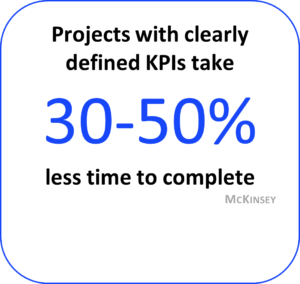
Establishing Key Performance Indicators (KPIs)
One critical component of defining value is identifying the key performance indicators (KPIs) that will be used to measure the project’s success. KPIs provide a tangible way to assess progress and determine whether the project delivers the expected benefits. Common KPIs in strategic sourcing include return on investment (ROI), total cost of ownership (TCO), cost savings, project delivery time, quality of deliverables, vendor responsiveness, and customer satisfaction.
Defining KPIs is crucial for measuring project success. For example, metrics such as cost savings, supplier performance, and procurement cycle time are essential. A study by McKinsey found that projects with clearly defined KPIs take 30-50% less time to complete than those without. This highlights the significant impact that well-established KPIs can have on the efficiency and effectiveness of strategic sourcing initiatives.
For instance, in an IT outsourcing project, KPIs might include metrics such as reducing IT operating costs, improving system uptime, or speeding up technical support response times. By establishing these KPIs at the beginning of the project, organizations can set clear benchmarks for success and track their progress over time. Additionally, regularly reviewing these KPIs allows the organization to make necessary adjustments to the project plan, ensuring it remains on track to meet its objectives.
Establishing KPIs begins with thoroughly understanding the project’s goals and desired specific outcomes. This involves engaging with key stakeholders to identify what success looks like and translating these expectations into measurable indicators. Each KPI should be specific, measurable, achievable, relevant, and time-bound (SMART), providing clear and actionable insights into the project’s performance.
Once the KPIs are defined, it is essential to implement a robust monitoring and reporting system to track these metrics consistently. This system should include regular data collection, analysis, and reporting mechanisms that provide real-time insights into the project’s progress. For instance, dashboards and performance reports can be used to visualize the data, making it easier for stakeholders to understand and interpret the KPIs.
Moreover, KPIs should be periodically reviewed and updated to reflect changes in project scope, objectives, or external factors. This continuous evaluation helps identify trends, anticipate challenges, and proactively adjust the project plan. For example, if a KPI indicates that project delivery time is slipping, the organization can investigate the cause and implement corrective actions to get back on track.
In summary, establishing KPIs is a fundamental aspect of strategic sourcing initiatives. They provide a clear framework for measuring success and facilitate informed decision-making and continuous improvement. By regularly monitoring and reviewing KPIs, organizations can ensure that their projects deliver the intended value and contribute to their overall strategic goals. This disciplined approach to performance measurement underscores the importance of KPIs in driving efficiency and achieving strategic objectives in sourcing projects.
Risk Mitigation
Proactive risk management is not just a good practice; it’s a shield that ensures project success and instills a sense of security and confidence. A report by PwC found that 57% of companies outsource IT to mitigate risks related to data security and regulatory compliance. Identifying and addressing potential risks early can avoid costly delays and ensure smoother project execution, providing a sense of security and confidence in the project’s success and reassuring the audience of the project’s resilience.
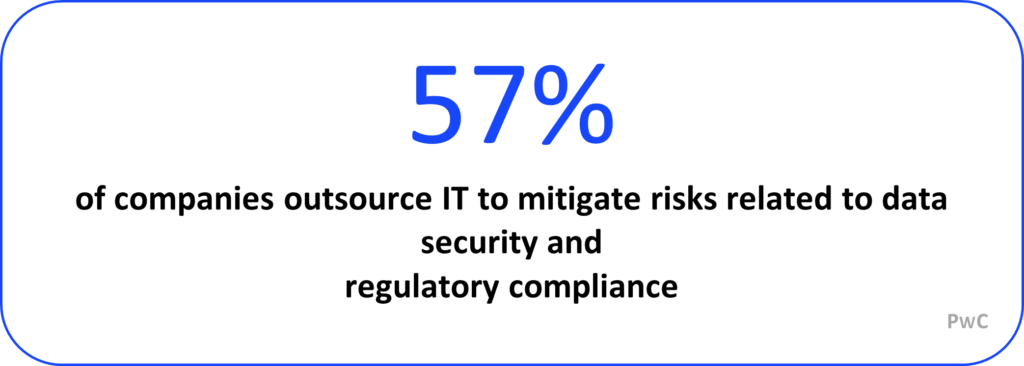
Defining the project’s value also involves identifying potential risks and developing mitigation strategies. By understanding possible challenges and obstacles early on, organizations can take proactive measures to address them, reducing the likelihood of project delays or failures. Effective risk management ensures the project stays on track and delivers the intended value. It also instills a sense of preparedness, making the audience feel ready to tackle any challenges and reinforcing their confidence in the project’s success.
The process of risk mitigation begins with a thorough risk assessment. This involves identifying all potential risks that could impact the project, categorizing them by severity and likelihood, and prioritizing them based on their likely impact. By conducting a comprehensive risk assessment, organizations can ensure they know all possible threats and can plan accordingly.
For example, a company outsourcing its customer service operations might identify risks such as potential communication barriers, differences in time zones, and variations in cultural norms. By recognizing these risks early, the organization can implement mitigation strategies. This could include providing language training for customer service representatives to ensure clear and effective communication, establishing overlapping working hours to facilitate real-time interactions, and offering cultural sensitivity training to bridge cultural gaps.
In addition to proactive measures, contingency plans for potential disruptions are vital to risk mitigation. These plans outline specific actions to respond to various risk scenarios, ensuring the organization can react quickly and effectively to unforeseen challenges. For instance, if a natural disaster disrupts a key vendor’s operations, a contingency plan might include activating backup vendors or reallocating resources to maintain service levels.
Regular risk monitoring and review are also essential. As the project progresses, new risks may emerge, and existing risks may evolve. Organizations can adapt their plans to address new threats and ensure ongoing project resilience by monitoring the risk landscape and reviewing risk mitigation strategies. This iterative approach to risk management helps maintain project momentum and safeguards the project’s value.
Moreover, fostering a risk-aware culture within the organization can enhance risk mitigation efforts. Encouraging team members to identify and report potential risks and providing them with the tools and training to manage them can create a proactive environment where risks are addressed promptly and effectively.
In summary, risk mitigation is critical to defining a project’s value. Organizations can minimize the impact of risks on their projects by identifying potential risks, developing proactive strategies, creating contingency plans, and continuously monitoring the risk landscape. This ensures the project stays on track, delivers the intended value, and contributes to the organization’s strategic objectives. The data from PwC underscores the importance of outsourcing as a risk mitigation strategy, particularly in managing data security and regulatory compliance challenges.
Benchmarking and Industry Best Practices
Benchmarking against industry standards can set realistic performance targets. According to a Gartner report, 72% of companies outsource to access specialized skills, which drives innovation and the adoption of best practices. Benchmarking can lead to significant performance improvements and competitive advantages.

Exploring industry best practices and benchmarking against successful organizations can provide valuable insights and guidance. Learning from others who have undertaken similar initiatives can help identify potential pitfalls and proven strategies for success. Benchmarking allows organizations to set realistic expectations and adopt practices shown to deliver results.
Benchmarking, comparing an organization’s processes and performance metrics to industry standards and best practices, is crucial in reducing the trial-and-error period for new initiatives. Organizations can gain a competitive edge by adopting practices that have been effective elsewhere. The data from Gartner further underscores this, revealing that most companies leverage outsourcing to gain access to specialized skills, foster innovation, and adopt best practices. This insight underscores the practical value of benchmarking in achieving competitive advantages.
For instance, a manufacturing company looking to implement lean production techniques might benchmark its processes against industry leaders who have successfully adopted these practices. By studying their approaches and learning from their experiences, the company can identify best practices applicable to its operations and avoid common pitfalls. For example, it might know about specific methods for reducing waste, optimizing supply chains, or improving workflow efficiency that industry leaders have validated.
Furthermore, engaging with industry associations and attending conferences can provide opportunities to learn from peers and stay updated on the latest trends and innovations in strategic sourcing. These forums offer platforms for knowledge exchange, where professionals can share their experiences, discuss challenges, and explore new ideas. By participating in these events, organizations can gain insights into emerging trends, technological advancements, and regulatory changes that could impact their strategic sourcing efforts.
Competitive benchmarking, an essential aspect, involves studying competitors to understand their performance and identify areas for improvement or innovation. This process can drive organizations to adopt more effective practices, improve their offerings, and enhance their market position. The Gartner report further supports this, showing that accessing specialized skills through outsourcing can significantly drive innovation, thereby underscoring the value of competitive benchmarking in the business context.
Organizations can also engage in collaborative benchmarking, where they work with other companies to share data and best practices. This collaborative approach can foster a culture of continuous improvement and innovation as organizations learn from each other and implement changes that drive better results.
Moreover, benchmarking can be supported using various tools and methodologies, such as performance scorecards, balanced scorecards, and key performance indicators (KPIs). These tools help track performance against benchmarks and identify gaps that must be addressed. Regularly reviewing and updating benchmarks ensures that organizations remain competitive and strive for excellence.
In conclusion, benchmarking and industry best practices are essential to strategic sourcing initiatives. They provide a roadmap for success by offering proven strategies and insights from successful organizations. By learning from others and continuously improving their processes, organizations can enhance their performance, achieve better outcomes, and maintain a competitive edge in the market. The insights from Gartner highlight that a strategic approach to outsourcing and benchmarking is crucial for driving innovation and achieving sustained competitive advantages.

Case Study
Let’s look at one multinational company embedding this workshop’s tenets: IBM.
IBM’s approach to strategic sourcing is structured and data-driven. It focuses on defining project value propositions, aligning sourcing strategies with broader business goals, and effectively managing vendor relationships to reduce costs, enhance efficiency, and drive innovation. IBM’s methods are exemplary in achieving significant value from strategic sourcing.
IBM places a strong emphasis on defining clear value propositions for its projects. Using metrics such as Return on Investment (ROI), Total Cost of Ownership (TCO), cost savings, and quality of deliverables, IBM measures project success and aligns these metrics with organizational goals. This approach ensures competitive advantage and operational excellence, setting a solid foundation for every sourcing initiative. Benchmarking against industry standards and adopting best practices is critical to IBM’s strategy. IBM learns from successful organizations, applies proven techniques, and continuously improves its sourcing processes. This benchmarking allows IBM to set realistic performance targets and adopt practices shown to deliver results, enhancing overall performance.
IBM identifies potential risks early and develops comprehensive mitigation strategies. By managing risks related to vendor performance, technological challenges, and market dynamics, IBM avoids costly delays and ensures project success. This proactive approach to risk management is integral to maintaining project timelines and budgets. Effective management of external talent is another cornerstone of IBM’s strategic sourcing. IBM uses comprehensive onboarding, skill assessment, and knowledge transfer to integrate external resources seamlessly into existing teams. This strategy maximizes the contributions of external talent and ensures smooth project execution, enhancing overall project outcomes.
IBM utilizes advanced project management software, communication platforms, and performance analytics tools to facilitate vendor management and collaboration. These technologies enhance project quality and innovation by streamlining processes, improving coordination, and providing real-time insights into project progress. Navigating legal and compliance issues is crucial for IBM. They ensure data protection, intellectual property rights, and regulatory compliance, addressing these aspects proactively to avoid legal complications and protect organizational interests. This diligent approach helps maintain project integrity and stakeholder trust.
IBM fosters a culture of continuous improvement by learning from each project and updating strategies accordingly. This iterative approach ensures IBM remains agile and responsive to changing market conditions and technological advancements, driving ongoing success and value creation. Clear and transparent communication with stakeholders is vital for IBM. They maintain open lines of communication, involve stakeholders in decision-making, address concerns promptly, and foster collaboration. This strategy ensures stakeholder engagement and support, contributing significantly to project success.
By employing strategic sourcing, IBM has effectively addressed various challenges and ensured a robust and efficient supply chain. Their structured, data-driven approach has led to significant cost savings, improved operational efficiency, enhanced supplier relationships, and driven innovation. IBM’s strategic sourcing and vendor management success is a model for other organizations aiming to achieve similar outcomes.
Talent Management
Effective talent management can maximize project outcomes. Outsourcing offers access to specialized expertise, with 60% of companies outsourcing to improve scalability and flexibility (Accenture). Proper onboarding and integration of external talent are crucial for leveraging these benefits.

Managing external talent effectively is vital to obtaining value through strategic sourcing. This includes onboarding consultants, assessing their skills, facilitating knowledge transfer, and integrating external resources seamlessly into existing teams. Effective talent management ensures that external resources can contribute to the project’s success without disrupting the organization’s operations.
For instance, a company hiring external consultants to implement a new enterprise resource planning (ERP) system might develop a comprehensive onboarding program that includes training on the company’s processes, systems, and culture. By ensuring that the consultants are well-integrated into the team, the company can maximize their contributions and ensure the project’s success. The onboarding process should be structured to provide consultants with all the necessary information and tools to perform their tasks effectively. This includes access to company systems, detailed process documentation, and introductions to key team members.
Assessing the skills of external talent is another crucial step in talent management. Organizations must ensure their consultants or contractors possess the required expertise and experience. This can be achieved through a rigorous selection process that includes interviews, skill assessments, and reference checks. Once hired, periodic performance reviews should be conducted to ensure that external talent meets project expectations and delivers value.
Facilitating knowledge transfer between internal and external team members is essential for maintaining continuity and enhancing the organization’s capabilities. This can be achieved through regular training sessions, collaborative workshops, and detailed documentation. By fostering an environment of continuous learning, organizations can ensure that internal teams are well-equipped to manage the project and maintain the system after the consultants have completed their work.
Integrating external resources into existing teams involves creating a cohesive working environment where internal and external team members can collaborate effectively. This can be facilitated by establishing clear communication channels, setting up regular team meetings, and encouraging open and transparent communication. By fostering a collaborative culture, organizations can ensure that all team members are aligned with the project’s goals and are working towards a common objective.
Ongoing communication and collaboration between internal and external team members can foster a cohesive working environment, enabling the project to progress smoothly and efficiently. Regular status updates, feedback sessions, and collaborative problem-solving meetings can help address any issues and ensure the project stays on track. This collaborative approach enhances the project’s success and builds strong relationships between internal and external team members.
Additionally, organizations should consider implementing retention strategies for critical external talent. This could include offering competitive compensation, opportunities for professional development, and the potential for long-term engagements. By investing in retaining high-performing external resources, organizations can ensure continuity and stability in their projects.
In conclusion, effective talent management is crucial for the success of strategic sourcing initiatives. By focusing on onboarding, skill assessment, knowledge transfer, and integration, organizations can ensure that external talent contributes positively to their projects. Through ongoing communication and collaboration, companies can create a cohesive and productive working environment that drives project success and delivers lasting value. Accenture’s insights underscore the importance of leveraging specialized expertise through outsourcing to enhance scalability and flexibility, maximizing project outcomes.
Technology Platforms and Tools
Leveraging technology is critical for managing complex projects. According to Forrester Research, companies using advanced project management and collaboration tools report a 35% increase in project quality and innovation. This highlights the importance of integrating the right technologies in strategic sourcing initiatives.
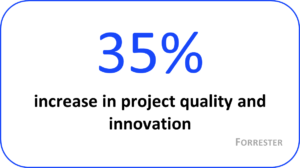
Technology platforms and tools facilitating vendor management and collaboration are essential for successful strategic sourcing. Project management software, communication platforms, and performance analytics tools can support effective collaboration with external partners, streamline processes, and provide real-time insights into project progress.
Given the rapid pace of technological advancement, organizations must utilize existing tools effectively and stay updated on new tools and innovations in the market. This ensures they can continuously improve their processes and maintain a competitive edge. Organizations should regularly review and assess their technology stack to identify opportunities for enhancing efficiency and productivity.
For example, a company implementing a new supply chain management system might use project management software to track the progress of the implementation, communication platforms to facilitate collaboration between internal and external stakeholders, and performance analytics tools to monitor key metrics and identify areas for improvement. By leveraging these technologies, organizations can enhance their ability to manage complex projects, ensuring they are completed on time and within budget.
Discovering new and emerging technologies can provide significant advantages over well-known tools. For instance, artificial intelligence (AI) and machine learning (ML) tools can offer advanced analytics and predictive insights, helping organizations make more informed decisions. Similarly, blockchain technology can enhance transparency and security in supply chain management, providing a tamper-proof record of transactions and interactions.
Staying updated on the market availability of new tools involves engaging with industry forums, attending conferences, and participating in webinars. These platforms provide valuable opportunities to learn about the latest developments, exchange ideas with peers, and discover innovative solutions that can be integrated into existing workflows. Organizations should encourage their teams to actively participate in these events to stay informed and gain insights into emerging trends and technologies.
Utilizing the right tools effectively requires a strategic approach. Organizations should start by clearly defining their needs and objectives and then evaluate different tools to determine which best aligns with their goals. This involves considering factors such as ease of use, integration capabilities, scalability, and cost. Pilot testing new tools before full-scale implementation can also help identify potential issues and ensure the tool meets the organization’s requirements.
Moreover, continuous training and development for team members are essential to maximize the benefits of these technologies. Regular training sessions can help employees stay proficient with existing tools and become adept at using new ones. Providing resources such as online tutorials, user manuals, and access to expert support can further enhance their ability to utilize these tools effectively.
In conclusion, utilizing technology platforms and tools is crucial for successful strategic sourcing. Organizations can effectively leverage existing tools, stay updated on new technologies, and continuously improve their technology stack, enhancing collaboration, streamlining processes, and achieving better project outcomes. The Forrester Research findings underscore the importance of investing in the right tools to boost project quality and innovation. Ensuring that teams are well-equipped to use these technologies can significantly contribute to the success of strategic sourcing initiatives.
Legal and Compliance Considerations
Navigating legal and compliance issues is crucial for protecting organizational interests. Ensuring data protection and regulatory compliance can mitigate risks. For example, compliance with GDPR and other regulations can prevent legal issues and ensure project integrity.
Addressing legal and compliance considerations is another crucial aspect of defining value. Ensuring data protection, intellectual property rights, and regulatory compliance helps mitigate risks and protect the organization’s interests. Navigating these issues effectively is essential for maintaining the integrity and success of the project.
Legal and compliance considerations start with thoroughly understanding the regulatory landscape applicable to the organization and the project. This includes identifying relevant laws, regulations, and industry standards that must be adhered to. For instance, if a project involves handling personal data, complying with data protection regulations such as the General Data Protection Regulation (GDPR) in Europe or the California Consumer Privacy Act (CCPA) in the United States is essential. These regulations set stringent data handling, storage, and sharing requirements to protect individuals’ privacy and rights.
In addition to data protection, intellectual property (IP) rights must be safeguarded. This involves ensuring that the organization owns all software, technologies, and processes or is appropriately licensed in the project. Contracts with vendors should include clauses that address IP rights, ensuring that the organization retains ownership of any custom developments and that any third-party software used is legally licensed. By addressing IP considerations upfront, organizations can prevent disputes and potential legal challenges that could disrupt the project.
Regulatory compliance extends beyond data protection and IP rights. Depending on the nature of the project, other regulations may be considered, such as industry-specific standards, environmental regulations, or labor laws. For instance, a company outsourcing its manufacturing operations must ensure that the vendor complies with local labor laws and environmental standards. This helps avoid legal penalties and supports corporate social responsibility initiatives.
For example, a company outsourcing its payroll processing might need to ensure that the vendor complies with data protection regulations such as GDPR. By addressing these considerations upfront, the company can avoid potential legal issues and ensure the smooth execution of the project. Additionally, working closely with legal and compliance teams throughout the project can help identify and address potential risks, ensuring that the organization remains compliant with all relevant laws and regulations.
Engaging legal and compliance teams early in the project planning phase is critical. These teams can conduct thorough due diligence on potential vendors, reviewing their compliance history and capabilities. They can also draft and review contracts to address all legal and regulatory requirements, including data protection clauses, IP rights, and service level agreements (SLAs). Regular audits and assessments throughout the project can help monitor compliance and address any issues promptly.
Furthermore, continuous education and training for employees on legal and compliance matters are essential. This ensures that everyone involved in the project understands the regulatory requirements and follows best practices to maintain compliance. Resources such as compliance checklists, guidelines, and access to legal experts can help employees adhere to legal standards.
In conclusion, addressing legal and compliance considerations is fundamental to the success of strategic sourcing initiatives. By ensuring data protection, safeguarding IP rights, and adhering to regulatory requirements, organizations can mitigate risks, protect their interests, and maintain the integrity of their projects. Proactive engagement with legal and compliance teams and continuous compliance monitoring are vital to navigating these complex issues effectively. The insights from GDPR compliance illustrate the importance of adhering to data protection regulations to avoid legal complications and ensure project integrity.
Continuous Improvement
Continuous improvement ensures agility and responsiveness to market changes. A company that conducts post-implementation reviews can identify lessons learned and areas for improvement, leading to better outcomes in future projects. This iterative approach is essential for maintaining competitiveness.
Establishing a framework for continuous improvement in vendor management processes is vital for long-term success. By learning from each project and updating strategies and procedures accordingly, organizations can enhance their ability to obtain value from future initiatives. Continuous improvement ensures that the organization remains agile and responsive to changing market conditions and technological advancements.
A continuous improvement framework involves several key steps. First, organizations need to establish clear metrics and benchmarks to measure the performance of their vendor management processes. These metrics might include vendor performance ratings, cost savings, delivery times, and quality of deliverables. By regularly monitoring these metrics, organizations can identify areas for improvement.
For example, a company that has successfully implemented a new procurement system might conduct a post-implementation review to identify lessons learned and areas for improvement. This review could involve gathering feedback from all stakeholders, including project managers, vendors, and end-users, to understand what worked well and what did not. The insights gained from this review can then be used to refine the vendor selection criteria, improve communication protocols, and enhance contract management practices. By applying these insights to future projects, the company can continuously refine its vendor management processes and achieve better outcomes.
Moreover, fostering a culture of continuous improvement within the organization can encourage employees to seek and implement innovative solutions, driving ongoing success. This culture can be cultivated by promoting open communication, encouraging feedback, and recognizing and rewarding innovative ideas. For instance, regular team meetings can be held to discuss potential improvements and share best practices. A dedicated team or task force focused on process improvement can also help drive these initiatives forward.
Technology also plays a crucial role in continuous improvement. Utilizing advanced analytics and reporting tools can provide deeper insights into vendor performance and highlight areas for improvement. For example, data analytics can help identify patterns and trends in vendor performance, allowing organizations to address issues proactively before they become significant problems. Furthermore, automated workflows and digital platforms can streamline vendor management processes, reducing manual effort and increasing efficiency.
Training and development are also essential components of a continuous improvement framework. Providing ongoing training for employees on best practices in vendor management and new technologies can enhance their skills and knowledge, enabling them to contribute more effectively to the improvement process. Additionally, encouraging employees to attend industry conferences and participate in professional networks can expose them to new ideas and innovations that can be applied within the organization.
In conclusion, establishing a framework for continuous improvement in vendor management processes is essential for long-term success. By regularly reviewing and updating strategies, fostering a culture of continuous improvement, leveraging technology, and investing in employee development, organizations can enhance their ability to manage vendors effectively and achieve better outcomes in future projects. This proactive approach ensures the organization remains agile and responsive to changing market conditions and technological advancements, driving ongoing success and value creation. Conducting post-implementation reviews and acting on the lessons learned is crucial for sustaining competitiveness and improving future project outcomes.
Interactive Elements
Workshop 1, “Obtaining Value,” is designed to provide theoretical knowledge and engage participants through various interactive elements. These interactive components are integral to the workshop, as they enhance learning, encourage active participation, and ensure that attendees can apply the concepts in real-world scenarios.
One of Workshop 1’s key interactive elements is the inclusion of hands-on exercises. These exercises are tailored to simulate real-life strategic sourcing challenges, allowing participants to apply the principles they have learned in a controlled environment. For example, attendees might be asked to develop a strategic sourcing plan for a hypothetical project, including defining KPIs, identifying potential risks, and outlining risk mitigation strategies. These practical exercises help reinforce learning and ensure participants can translate theory into practice.
Group discussions are another crucial interactive component of the workshop. These discussions allow participants to share their experiences, insights, and best practices with their peers. Experienced instructors facilitate these sessions to encourage collaboration and knowledge sharing among attendees. Participants can discuss common challenges, brainstorm solutions, and gain perspectives on strategic sourcing issues. This collaborative approach fosters a deeper understanding of the material and helps build a supportive learning community.
Analyzing real-world case studies is a powerful way to illustrate the concepts covered in the workshop. Participants are presented with detailed case studies of organizations successfully implementing strategic sourcing initiatives. They work in groups to analyze these cases, identify critical success factors, and discuss how similar strategies can be applied to their organizations. This interactive analysis helps participants connect theoretical knowledge with practical application, making the learning experience more relevant and impactful.
Scenario-based practical exercises simulate interactions between different stakeholders in a strategic sourcing project. Participants are given specific scenarios, such as handling vendor negotiations or addressing compliance issues, and they must develop strategies to navigate these challenges effectively. This immersive experience helps attendees build problem-solving and decision-making skills for effective vendor management and stakeholder engagement.
The workshop has dedicated Q&A sessions where participants can ask questions and seek clarification on specific topics. These interactive sessions allow attendees to engage directly with the instructors and fellow participants. This open dialogue ensures that any doubts or concerns are addressed promptly, enhancing the learning experience.
In summary, Workshop 1’s interactive elements are designed to create an engaging and dynamic learning environment. The workshop ensures participants actively participate in learning by incorporating hands-on exercises, group discussions, case study analysis, scenario-based practical exercises, and interactive Q&A sessions. It can apply the concepts in their professional contexts.
Stakeholder Communication
Effective stakeholder communication is vital for project success. Transparent communication helps build trust and resolve conflicts. According to Deloitte, 59% of companies outsource to focus on core business activities, underscoring the need for clear communication to align stakeholder interests.
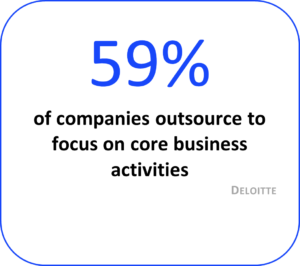
Effective communication with internal and external stakeholders is critical for the success of any strategic sourcing initiative. Clear and transparent communication helps build trust, resolve conflicts, and foster a collaborative environment. Keeping stakeholders informed about the project’s progress and involving them in decision-making ensures their support and engagement.
Stakeholder communication starts with identifying all relevant stakeholders, including internal team members, external vendors, customers, and regulatory bodies. Understanding their interests, expectations, and concerns is essential for developing a comprehensive communication strategy. This strategy should outline the key messages, communication channels, and frequency of updates tailored to each stakeholder group.
For instance, a company implementing a new customer relationship management (CRM) system might establish regular communication channels with key stakeholders, including project status updates, feedback sessions, and decision-making meetings. By maintaining open lines of communication, the company can ensure that all stakeholders are aligned and engaged throughout the project. Regular updates provide transparency and inform stakeholders about milestones, progress, and potential challenges. This transparency helps build trust and demonstrates the organization’s commitment to the project’s success.
Involving stakeholders in decision-making processes is another crucial aspect of effective communication. By seeking input and feedback from stakeholders, organizations can make more informed decisions, considering diverse perspectives. This collaborative approach improves the quality of decisions and fosters a sense of ownership and commitment among stakeholders. For example, involving end-users in a new CRM system’s design and testing phases can ensure that the final product meets their needs and expectations.
Additionally, promptly addressing stakeholder concerns and feedback can help mitigate potential issues and ensure the project stays on track. Organizations should establish mechanisms for collecting and responding to feedback, such as surveys, suggestion boxes, or dedicated communication platforms. By actively listening to stakeholders and addressing their concerns, organizations can prevent minor issues from escalating into major problems.
Effective communication also involves using appropriate tools and technologies to facilitate interactions. Project management software, collaboration platforms, and video conferencing tools can enhance stakeholder communication and collaboration, especially in geographically dispersed teams. These tools enable real-time updates, document sharing, and virtual meetings, making coordinating efforts easier and keeping everyone on the same page.
Moreover, creating a communication plan with clearly defined roles and responsibilities ensures that communication efforts are organized and efficient. Assigning specific team members to manage stakeholder communication can help maintain consistency and ensure that all stakeholders receive timely and accurate information. This plan should also include contingency strategies for managing communication during crises or unexpected changes in the project.
In conclusion, effective stakeholder communication is a cornerstone of successful strategic sourcing initiatives. By maintaining clear and transparent communication, involving stakeholders in decision-making, addressing concerns promptly, and leveraging appropriate tools, organizations can build trust, foster collaboration, and ensure the smooth execution of their projects. This proactive approach to communication helps align stakeholders’ interests, enhances project outcomes, and supports long-term success. The findings from Deloitte highlight the critical role of communication in aligning stakeholder interests and ensuring that outsourced activities contribute effectively to core business objectives.
The Role of Workshop 1 in Strategic Sourcing
Workshop 1, “Obtaining Value,” is the cornerstone of the strategic sourcing process. It provides the foundation for the subsequent workshops by ensuring the organization understands the project’s value and how to achieve it. The critical components of Workshop 1 include an introduction to strategic sourcing, defining key performance indicators (KPIs), benchmarking and best practices, risk mitigation strategies, talent management, technology platforms and tools, legal and compliance considerations, a continuous improvement framework, and stakeholder communication.
The workshop begins with an overview of strategic sourcing and its importance in today’s rapidly evolving market. Participants learn about the key concepts, benefits, and challenges of strategic sourcing, setting the stage for the following detailed discussions. Understanding the fundamentals of strategic sourcing helps participants appreciate the broader context and its critical role in achieving organizational success.
Participants are guided through the process of identifying and defining the KPIs that will be used to measure the project’s success. This includes understanding the different types of KPIs, their relevance to the project’s goals, and how to establish realistic and measurable targets. By setting clear and achievable KPIs, organizations can create a roadmap for success and ensure all stakeholders are aligned with the project’s objectives.
The workshop explores industry best practices and benchmarking techniques to provide participants with insights into successful strategies employed by other organizations. This includes reviewing case studies and real-world examples to highlight practical strategic sourcing and vendor management approaches. By learning from the experiences of others, participants can identify best practices that can be adapted to their organizations, improving their chances of success.
Participants learn about the common risks associated with strategic sourcing initiatives and the strategies to mitigate them. This includes understanding the potential challenges and developing proactive measures to address them, ensuring the project’s success. By identifying and addressing risks early in the process, organizations can avoid potential pitfalls and ensure a smoother project execution.
The workshop covers practical ways to manage external talent, including onboarding consultants, assessing their skills, facilitating knowledge transfer, and integrating them into existing teams. Effective talent management ensures that external resources contribute positively to the project. Organizations can maximize the contributions of external talent by fostering a collaborative environment and ensuring that all team members are aligned with the project’s goals.
Participants are introduced to relevant technologies and tools for vendor management and collaboration. These include project management software, communication platforms, and performance analytics tools that support effective collaboration with external partners. By leveraging these technologies, organizations can enhance their ability to manage complex projects and ensure they are completed on time and within budget.
The workshop addresses the legal and compliance considerations organizations need to navigate in strategic sourcing initiatives. This includes understanding data protection, intellectual property rights, regulatory compliance, and ensuring the project adheres to all relevant laws and regulations. By addressing these considerations upfront, organizations can avoid potential legal issues and ensure the smooth execution of the project.
Participants learn about establishing a framework for continuous improvement in vendor management processes. This includes understanding the importance of learning from each project and updating strategies and procedures to enhance future initiatives. By fostering a culture of continuous improvement, organizations can ensure that they remain agile and responsive to changing market conditions and technological advancements.
The workshop emphasizes the significance of effective communication with internal and external stakeholders. Participants learn strategies for maintaining transparency, resolving conflicts, and fostering a collaborative environment to ensure the project’s success. Organizations can ensure all stakeholders are aligned and engaged throughout the project by maintaining open communication lines and promptly addressing stakeholder concerns.
Conclusion
Workshop 1, “Obtaining Value,” is an essential starting point for any strategic sourcing initiative. By defining the project’s value at the outset, organizations can align resources, set realistic expectations, and establish measurable goals. This foundational step ensures that the organization is well-prepared to navigate the complexities of strategic sourcing and vendor management, ultimately leading to successful IT project implementations. As the first step in the 12-workshop series, Workshop 1 provides the knowledge and tools necessary to achieve the desired outcomes and deliver lasting value to the organization.
Defining value early in the strategic sourcing process is crucial for several reasons. It creates a clear vision of what the organization aims to achieve, which helps guide decision-making and prioritize activities. This clarity is vital for aligning all stakeholders, from top management to operational teams, ensuring everyone works towards common objectives. A well-defined value proposition also aids resource allocation, providing time, budget, and efforts directed toward activities that deliver the highest return on investment.
One of Workshop 1’s significant benefits is its comprehensive approach to identifying and defining Key Performance Indicators (KPIs). KPIs are instrumental in measuring the success of strategic sourcing initiatives. By setting clear and achievable KPIs, organizations can track their progress and make informed decisions to steer the project in the right direction. This proactive approach to performance measurement enhances transparency and enables timely interventions to address any deviations from the planned course.
Another critical component of Workshop 1 is emphasizing benchmarking and best practices. Learning from the experiences of other organizations can provide valuable insights and help avoid common pitfalls. Benchmarking against industry standards allows organizations to set realistic performance targets and adopt practices proven to deliver results. This continuous learning and adaptation process is essential for competitiveness in a rapidly evolving market.
Risk mitigation strategies covered in Workshop 1 are also vital for the success of strategic sourcing initiatives. Every project comes with its set of risks, be they related to vendor performance, technological challenges, or market dynamics. By identifying potential risks early and developing strategies to mitigate them, organizations can avoid costly delays and ensure smoother project execution. This proactive risk management approach helps maintain project timelines and budgets, enhancing overall project success.
Talent management is another area in which Workshop 1 provides significant value. Effective management of external talent is crucial for leveraging the full potential of strategic sourcing. This includes onboarding consultants, assessing their skills, facilitating knowledge transfer, and integrating them into existing teams. By fostering a collaborative environment and ensuring alignment with the project’s goals, organizations can maximize the contributions of external resources. This improves project outcomes and builds a more resilient and adaptable workforce.
Another highlight of Workshop 1 is the integration of technology platforms and tools. In today’s digital age, leveraging the right technologies is essential for effective vendor management and collaboration. The workshop introduces participants to various project management software, communication platforms, and performance analytics tools that can support complex projects. By adopting these technologies, organizations can enhance efficiency, improve stakeholder coordination, and ensure projects are completed on time and within budget.
Workshop 1 also thoroughly addresses legal and compliance considerations. Navigating the legal landscape is critical for avoiding potential issues derailing a project. This includes understanding data protection laws, intellectual property rights, and regulatory compliance. By addressing these aspects upfront, organizations can protect their interests and ensure the smooth execution of their projects. Proactive legal and compliance management is essential for building stakeholder trust and maintaining the project’s integrity.
Continuous improvement is a central theme in Workshop 1, emphasizing learning from each project and updating strategies accordingly. By fostering a culture of continuous improvement, organizations can remain agile and responsive to changing market conditions and technological advancements. This iterative approach to process improvement ensures that the organization is constantly evolving and adapting to new challenges and opportunities.
Effective stakeholder communication is the final pillar of Workshop 1. Clear and transparent communication helps build trust, resolve conflicts, and foster a collaborative environment. Keeping stakeholders informed about the project’s progress and involving them in decision-making ensures their support and engagement. Organizations can ensure all stakeholders are aligned and engaged throughout the project by maintaining open communication lines and promptly addressing concerns.
By participating in this workshop, you will understand the importance of defining value in strategic sourcing and how to manage the process effectively. You will be equipped with the skills and knowledge to ensure that your organization remains competitive and forward-thinking in today’s rapidly evolving market. Join us to embark on this strategic sourcing and vendor management journey and set the stage for your organization’s success. By leveraging the insights and strategies gained from this workshop, you can position your organization for long-term success and create a sustainable competitive advantage in the marketplace.
The knowledge and tools provided in Workshop 1 are theoretical concepts and practical strategies that can be implemented immediately. This workshop lays the groundwork for the remaining workshops in the series, each building on the previous one to create a cohesive and comprehensive approach to strategic sourcing and vendor management. By mastering the principles and practices outlined in Workshop 1, participants will be well-prepared to tackle the more advanced topics covered in subsequent workshops.
Furthermore, the workshop’s collaborative nature fosters a learning environment where participants can share their experiences and learn from each other. This peer-to-peer interaction can provide additional insights and perspectives, enriching the learning experience. The workshop also includes hands-on exercises and real-world case studies, allowing participants to apply what they have learned in a practical context.
In conclusion, Workshop 1, “Obtaining Value,” is a critical first step in strategic sourcing. It provides the foundational knowledge and tools needed to define and achieve the project’s value, ensuring the organization is well-prepared for the challenges and opportunities. By focusing on critical areas such as KPIs, benchmarking, risk mitigation, talent management, technology integration, legal compliance, continuous improvement, and stakeholder communication, the workshop equips participants with the skills and strategies needed for successful strategic sourcing initiatives.
This workshop is more than just an introduction; it is a comprehensive guide to establishing a solid foundation for strategic sourcing. The principles and practices covered in Workshop 1 will be a reference point throughout the strategic sourcing journey, helping organizations stay focused on their goals and continuously improve their processes. By investing in this workshop, organizations are committed to excellence in strategic sourcing and vendor management, paving the way for long-term success and sustainable growth.
The importance of starting with a clear definition of value cannot be overstated. It sets the tone for the strategic sourcing initiative, ensuring all subsequent activities align with the organization’s goals and objectives. This alignment is crucial for maximizing the return on investment and achieving the desired outcomes. By participating in Workshop 1, you are taking the first step towards a more strategic and value-driven approach to sourcing and vendor management.
In today’s competitive business environment, the ability to effectively manage strategic sourcing initiatives can be a significant differentiator. Organizations that excel in this area can achieve cost savings, improve operational efficiency, enhance supplier relationships, and drive innovation. Workshop 1 provides the essential knowledge and tools needed to excel in strategic sourcing, making it a valuable investment for any organization looking to enhance its sourcing capabilities.
Ultimately, the success of a strategic sourcing initiative depends on the foundation laid in the early stages. Workshop 1 ensures this foundation is solid, providing the clarity, alignment, and direction needed for success. Participating in this workshop will give you valuable insights and strategies and set your organization on a path to sustained success and competitive advantage.
Join us for Workshop 1, “Obtaining Value,” and take the first step towards mastering strategic sourcing and vendor management. Equip yourself with the knowledge and tools needed to define and achieve value, navigate the sourcing complexities, and drive your organization’s long-term success. This workshop invests in your organization’s future, providing the skills and strategies needed to thrive in today’s dynamic business environment. Don’t miss this opportunity to set the stage for your organization’s success and create a sustainable competitive advantage in the marketplace.
Executive Summary
Workshop’s Framework
This workshop on obtaining value in strategic sourcing offers a comprehensive, cohesive learning journey that builds on each chapter’s insights and principles, forming a robust framework. This integrated approach ensures that participants develop a deep understanding of strategic sourcing from value identification to scalability, applying practical exercises to reinforce learning.
Image too detailed
Chapter 1: Value Identification and Alignment
Value identification and alignment are crucial components of strategic sourcing in IT projects. This chapter explores the concept of value within the context of strategic sourcing, highlighting both tangible and intangible benefits. Tangible value includes cost savings, revenue growth, efficiency improvements, and return on investment (ROI), while intangible value encompasses customer satisfaction, brand reputation, innovation, and employee morale.
Understanding value is essential as it sets the stage for identifying opportunities, creating value, and measuring success. The chapter emphasizes the importance of aligning value with organizational goals to ensure sourcing activities contribute to the company’s strategic direction. This alignment involves engaging stakeholders, establishing clear metrics and KPIs, and developing risk management strategies.
Engaging stakeholders is critical to ensure that all relevant perspectives are considered in the value identification process. Stakeholders, including internal teams, suppliers, and customers, can provide insights into what constitutes value for different parts of the organization. Their engagement fosters buy-in and alignment across the organization, which is crucial for the success of strategic sourcing initiatives.
Establishing clear metrics and KPIs is another essential step in aligning value with organizational goals. KPIs provide a measurable way to track progress and assess the impact of sourcing initiatives. Common KPIs in strategic sourcing include cost savings, procurement cycle times, supplier performance, and compliance rates. These metrics help ensure the sourcing activities deliver the expected benefits and align with the organization’s strategic goals.
Developing risk management strategies is also crucial for protecting the identified value. This involves identifying potential risks, assessing their impact, and developing mitigation plans. Effective risk management helps organizations anticipate and address challenges that could undermine the value of their sourcing initiatives.
The chapter also covers identifying value opportunities through market analysis, internal needs assessments, and gap analysis. Market analysis helps organizations understand industry trends, competitive dynamics, and customer preferences, which can reveal new value-creation opportunities. Internal needs assessments identify gaps in the current capabilities and processes, while gap analysis compares current performance with desired outcomes, highlighting areas for improvement.
Recognizing these opportunities helps maximize the benefits of sourcing initiatives. Organizations can leverage advanced technologies like AI, machine learning, and blockchain to enhance their sourcing processes and create value. For instance, AI can be used for predictive analytics to optimize procurement decisions, while blockchain can improve transparency and traceability in the supply chain.
Fostering innovation is another strategy for value creation. Organizations can develop new solutions and approaches that drive competitive advantage by encouraging creative thinking and experimentation. Enhancing collaboration both internally and with external partners is also critical for value creation. Effective collaboration can lead to more innovative solutions, faster problem-solving, and improved outcomes.
Optimizing processes is another important strategy for creating value. Streamlining procurement processes, automating routine tasks, and implementing best practices can improve efficiency and reduce costs. Finally, measuring impact involves continuously monitoring and evaluating the outcomes of sourcing initiatives. Regular reviews and adjustments ensure that the initiatives remain aligned with organizational goals and continue to deliver significant value.
By focusing on these aspects, organizations can ensure their strategic sourcing initiatives deliver significant value and support their broader goals. Effective value identification and alignment set the foundation for successful sourcing strategies that enhance organizational performance and competitiveness.
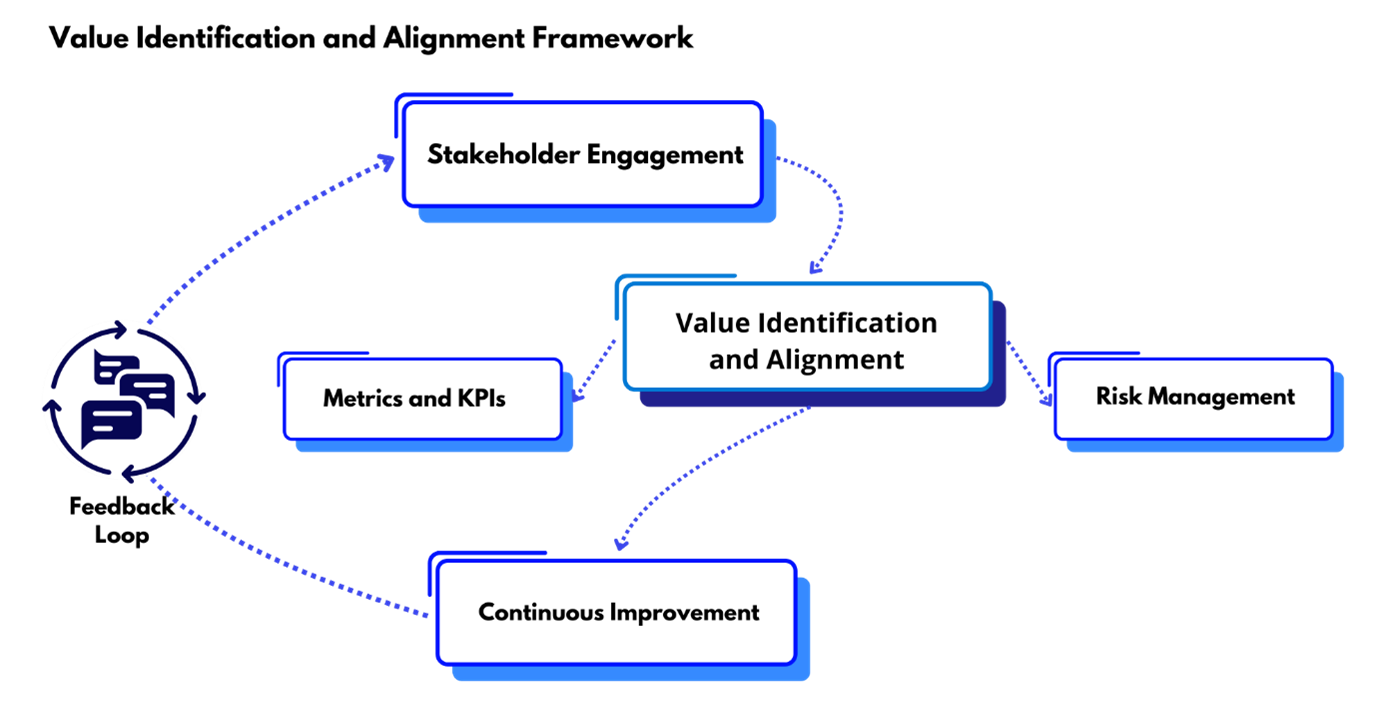

Chapter 2: Innovation
Innovation is a driving force behind successful strategic sourcing initiatives. This chapter delves into why organizations should drive innovation, including staying competitive, meeting customer needs, expanding market reach, and improving efficiency. Innovation is crucial for maintaining relevance in a rapidly evolving business environment.
The chapter addresses innovation-related concerns, such as resource allocation, risk of failure, resistance to change, market adoption, competitive pressures, and intellectual property protection. By understanding these challenges, organizations can develop strategies to overcome them and foster a culture of innovation.
Resource Allocation: Effective innovation requires significant resources, including time, money, and talent. Organizations must prioritize and allocate resources wisely to support innovative projects without disrupting other critical operations. This involves setting aside budgets for research and development (R&D), investing in new technologies, and fostering an environment where employees can dedicate time to innovative pursuits.
Risk of Failure: Innovation inherently involves risk. Not all innovative ideas will succeed; failure can lead to wasted resources and lost opportunities. Organizations must develop a risk management strategy that allows experimentation while minimizing potential negative impacts. This includes creating safe spaces for testing new ideas, learning from failures, and iterating quickly to refine and improve solutions.
Resistance to Change: Innovation often requires changing established processes and mindsets, which can be met with resistance from employees and stakeholders. Overcoming this resistance involves effective change management practices, such as clear communication, training programs, and involving employees in innovation. By addressing concerns and demonstrating the benefits of innovation, organizations can build support and enthusiasm for new initiatives.
Market Adoption: For innovation to be successful, it must be embraced by the market. Organizations need to conduct thorough market analysis to understand customer needs and preferences. This involves gathering customer insights through surveys, focus groups, and social media engagement. Organizations can increase the likelihood of successful adoption and market penetration by aligning innovative solutions with market demands.
Competitive Pressures: In a competitive landscape, staying ahead requires continuous innovation. Organizations must keep an eye on industry trends and competitor activities to identify opportunities for differentiation. By proactively seeking out and implementing innovative solutions, organizations can maintain a competitive edge and capture new market share.
Intellectual Property Protection: Protecting intellectual property (IP) is essential for safeguarding innovative ideas and maintaining a competitive advantage. Organizations should implement robust IP protection strategies, including patents, trademarks, and copyrights. This ensures that innovations are legally protected and can be commercialized without the risk of infringement.

Practical steps for implementing innovation include market analysis, customer insights, technology assessment, and strategic planning. Market analysis helps identify emerging trends and opportunities, while customer insights ensure that innovations are aligned with customer needs. Technology assessment involves evaluating new technologies for potential adoption and integration. Strategic planning ensures that innovation efforts are aligned with overall business objectives and resource allocation.
The chapter emphasizes the importance of aligning innovation efforts with business objectives and leveraging industry best practices. It also highlights the role of leadership in setting the tone for innovation and creating an environment that encourages creativity and experimentation.
Leadership plays a pivotal role in driving innovation. Leaders must champion innovative thinking, allocate resources, and create a culture that supports experimentation. This involves allowing employees to explore new ideas, offering incentives for creative solutions, and recognizing and rewarding successful innovations. Leaders should also facilitate collaboration across departments and external partners to foster a diverse and inclusive innovation ecosystem.
In conclusion, innovation is essential for the success of strategic sourcing initiatives. By addressing challenges such as resource allocation, risk of failure, resistance to change, market adoption, competitive pressures, and intellectual property protection, organizations can develop effective strategies for fostering a culture of innovation. Practical steps like market analysis, customer insights, technology assessment, and strategic planning are crucial for implementing innovation successfully. Leadership is critical in setting the tone for innovation, creating an environment that encourages creativity and experimentation, and ensuring that innovation efforts are aligned with business objectives and industry best practices.

Chapter 3: Definitions
Clear and consistent definitions are essential for effective communication and decision-making in strategic sourcing. This chapter defines critical terms such as sourcing, strategic sourcing, best practices, continuous improvement, risk, scalability, COTS (Commercial Off-The-Shelf), ROI, and KPIs. Understanding these terms ensures clarity, alignment, and precision in communication and collaboration.
Sourcing refers to identifying, evaluating, and selecting suppliers to meet the organization’s procurement needs. It involves market research, supplier evaluation, negotiation, and contracting. Sourcing aims to find the best suppliers to provide goods or services of the right quality, price, and time.
Strategic sourcing, on the other hand, involves a more comprehensive and proactive approach to procurement and supply chain management. It focuses on long-term supplier relationships, cost reduction, risk management, and value creation. Strategic sourcing includes category management, supplier relationship management, and continuous improvement initiatives.
Best practices are efficient methods and processes widely recognized as superior to others in an industry. Adopting best practices helps organizations achieve higher efficiency, quality, and performance. These practices are typically based on extensive research, benchmarking, and industry standards.
Continuous improvement involves ongoing efforts to enhance processes, products, or services. It is a systematic approach to identifying and implementing incremental changes that lead to better performance. Continuous improvement relies on methodologies like Lean, Six Sigma, and Total Quality Management (TQM).
Risk in the context of strategic sourcing refers to potential adverse outcomes that could impact the project’s success. These risks include supplier failure, price volatility, regulatory changes, and geopolitical instability. Effective risk management involves identifying, assessing, and mitigating these risks to minimize their impact.
Scalability is increasing capacity to meet growing demand without compromising performance or efficiency. In strategic sourcing, scalability ensures that the supply chain can adapt to changes in demand, whether it is increasing production volumes or expanding to new markets. Scalable solutions are essential for supporting business growth and maintaining competitive advantage.
COTS (Commercial Off-The-Shelf) products are ready-made solutions available for immediate use. These products are designed to meet standard requirements and do not require extensive customization. COTS solutions are cost-effective and reduce the time to implement new systems or processes, making them a popular choice for many organizations.
ROI (Return on Investment) measures the efficiency of an investment by comparing the gains from the investment to its cost. In strategic sourcing, ROI helps evaluate the financial benefits of sourcing initiatives, such as cost savings, revenue growth, and efficiency improvements. Calculating ROI provides a clear picture of the value generated by the investment and helps justify sourcing decisions.
KPIs (Key Performance Indicators) reflect performance and progress towards achieving specific objectives. In strategic sourcing, KPIs can include cost savings, supplier performance, procurement cycle time, quality of deliverables, and customer satisfaction. KPIs provide a measurable way to assess the effectiveness of sourcing initiatives and ensure alignment with organizational goals.
Understanding these terms ensures clarity, alignment, and precision in communication and collaboration. It enables all stakeholders to speak the same language and have a shared understanding of critical concepts. This shared understanding is crucial for effective decision-making and successful project execution. Clear definitions also help set expectations, measure performance, and identify improvement areas.
In conclusion, clear and consistent definitions are fundamental to the success of strategic sourcing initiatives. Organizations can enhance their communication, collaboration, and decision-making processes by understanding key terms like sourcing, strategic sourcing, best practices, continuous improvement, risk, scalability, COTS, ROI, and KPIs. This chapter provides the foundational knowledge to align sourcing activities with organizational goals and achieve desired outcomes.

Chapter 4: Can We Do This Internally?
This chapter explores the considerations for deciding whether to develop a product internally or externally. Internal development offers greater control and fosters innovation but requires adequate resources, expertise, and time. The chapter outlines the internal development process, including idea generation, concept development, design and prototyping, testing, production, marketing, and post-launch evaluation.
Idea Generation is the first step in internal development, where potential solutions to a problem or opportunities for innovation are identified. This can involve brainstorming sessions, market research, customer feedback, and competitive analysis. The goal is to generate a wide range of ideas that can be evaluated and refined.
Concept Development follows idea generation, where the best ideas are developed into detailed concepts. This involves defining the product’s features, functionality, and design. Concept development also includes assessing the ideas’ feasibility and alignment with the organization’s strategic goals.
Design and Prototyping is the next phase, where the detailed design of the product is created, and prototypes are developed. Prototyping allows the team to test and refine the product before moving into full-scale production. This stage is crucial for identifying potential issues and making necessary adjustments.
Testing involves rigorous evaluation of the prototypes to ensure they meet the required specifications and performance standards. This can include functional testing, user testing, and stress testing. Testing helps identify any flaws or areas for improvement, ensuring the final product is high quality.
Production is the phase where the product is manufactured at scale. This requires setting up production processes, sourcing materials, and managing the supply chain. Efficient production processes are essential for meeting quality standards and ensuring timely delivery.
Marketing is crucial for the successful launch of the product. It involves developing a marketing strategy, creating promotional materials, and executing marketing campaigns. Effective marketing helps generate awareness and demand for the product.
Post-launch evaluation involves assessing the product’s performance after it has been launched. This includes gathering customer feedback, monitoring sales and usage data, and identifying areas for improvement. Post-launch evaluation helps ensure the product meets customer needs and performs well in the market.
Key factors to consider in internal development include resource availability, cost analysis, time-to-market, risk management, scalability, regulatory compliance, and strategic partnerships.
Resource Availability is critical for internal development. Organizations must have the necessary human, financial, and technical resources to undertake the project. This includes skilled personnel, adequate funding, and the right technology and infrastructure.
Cost Analysis involves evaluating the financial implications of internal development. This includes direct costs, such as materials and labor, and indirect costs, such as overhead and opportunity costs. A thorough cost analysis helps ensure that the project is financially viable.
Time-to-market is another critical consideration. Internal development can be time-consuming, and organizations must assess whether they can deliver the product within the desired timeframe. Delays can lead to missed market opportunities and reduced competitiveness.
Risk Management involves identifying and mitigating potential risks associated with internal development. This includes technical risks, market risks, and operational risks. Effective risk management helps ensure the project stays on track and achieves its objectives.
Scalability refers to the ability to scale production and operations as demand for the product grows. Organizations must ensure their internal processes can handle increased volumes without compromising quality or efficiency.
Regulatory Compliance is crucial for ensuring the product meets all relevant laws and regulations. This includes industry standards, safety requirements, and environmental regulations. Compliance helps avoid legal issues and ensures the product can be marketed and sold legally.
Strategic Partnerships can enhance internal development by providing additional resources, expertise, and market access. Collaborating with other organizations can help overcome resource limitations and accelerate development.
The chapter stresses the need for a thorough internal evaluation to ensure the proposed solution aligns with strategic goals, resource availability, and the potential for successful execution. This careful assessment helps organizations decide whether to develop a product internally or seek external solutions.
Comparison Table: Internal vs. External Sourcing
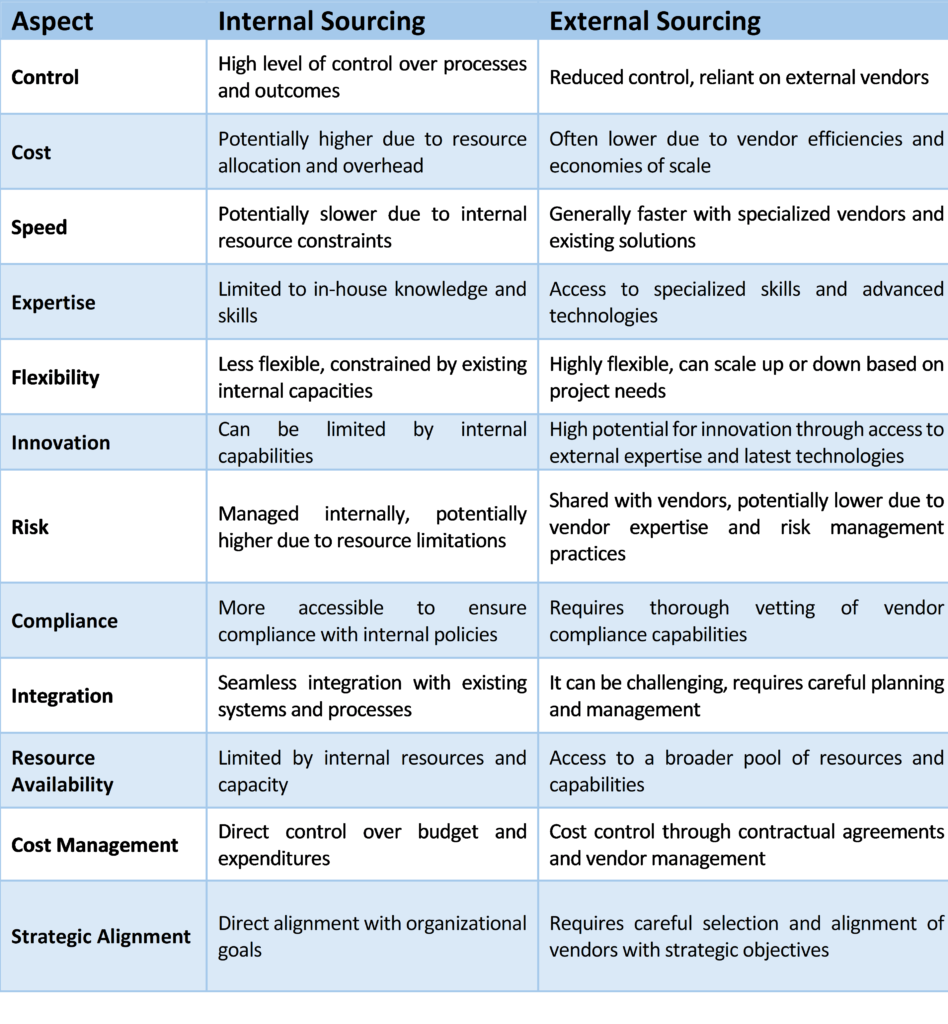

Chapter 5: Let’s Look at External
Several steps are crucial for managing the process effectively when using external resources for strategic initiatives. This chapter covers defining project objectives, identifying external resources, developing a project plan, establishing communication channels, setting expectations, and monitoring progress. It also addresses risk management, stakeholder engagement, and continuous evaluation.
Defining clear and achievable project objectives is the first step. These objectives should align with the organization’s strategic goals and provide a clear direction for the project. Objectives must be specific, measurable, achievable, relevant, and time-bound (SMART). Clear objectives help ensure that all stakeholders are on the same page and that the project has a well-defined purpose.
Identifying external resources involves finding the right partners, suppliers, or service providers to contribute to the project. This process includes researching potential vendors, evaluating their capabilities, and selecting those that align with the project’s needs. Expert, experience, reputation, and financial stability should be considered when choosing external resources.
Developing a comprehensive project plan is crucial for effectively managing external resources. The plan should outline the scope, timeline, budget, deliverables, and critical milestones and detail the roles and responsibilities of all parties involved. A well-structured project plan serves as a roadmap for the project and helps ensure all tasks are completed on time and within budget.
Establishing effective communication channels is essential for collaboration between internal and external teams. This includes setting up regular meetings, progress reports, and feedback loops. Clear and open communication helps prevent misunderstandings, keeps everyone informed, and fosters a collaborative working environment.
Setting expectations is another crucial step. This involves defining what is expected from the external resources regarding quality, timelines, and deliverables. Clear expectations help all parties understand their roles and responsibilities and are committed to achieving the project’s objectives.
Monitoring progress is crucial for ensuring that the project stays on track. This involves tracking key performance indicators (KPIs), conducting regular progress reviews, and addressing issues. Monitoring progress helps identify potential problems early and allows for timely corrective actions.
Risk management is an essential aspect of using external resources. This involves identifying potential risks, assessing their impact, and developing mitigation strategies. Risks include delays, cost overruns, quality issues, and compliance challenges. Effective risk management helps the project overcome obstacles and achieve its goals.
Stakeholder engagement is vital for gaining support and buy-in for the project. This involves identifying all stakeholders, understanding their interests and concerns, and keeping them informed and involved throughout the project. Engaged stakeholders are more likely to support and contribute to the project’s success.
Continuous evaluation is essential for learning and improvement. This involves regularly reviewing the project’s progress, evaluating external resources’ performance, and identifying improvement areas. Continuous evaluation helps ensure that the project is on track and that any issues are addressed promptly.
The chapter highlights the importance of fit-for-purpose evaluation, cost-benefit analysis, integration and compatibility assessment, customization options, vendor reliability, data security, training, and user adoption. Fit-for-purpose evaluation ensures the external resources are well-suited to the project’s needs. Cost-benefit analysis helps determine the financial viability of using external resources. Integration and compatibility assessment ensures that external resources seamlessly integrate into existing systems and processes. Customization options allow for tailoring solutions to meet specific needs. Vendor reliability ensures that the external resources are dependable and capable of delivering on their promises. Data security protects sensitive information. Training ensures that users are well-prepared to use the new systems or processes. User adoption ensures that the new solutions are accepted and utilized effectively.
By following these steps, organizations can maximize the likelihood of success for their strategic initiatives and achieve desired outcomes. Effective management of external resources requires careful planning, clear communication, and continuous monitoring. By leveraging external expertise and resources, organizations can enhance their capabilities, achieve strategic goals, and drive business success.

Chapter 6: Mission and Objectives
This chapter focuses on the importance of having a clear mission and objectives for strategic sourcing initiatives. A well-defined mission provides direction and purpose, while clear objectives ensure that all efforts are aligned with the organization’s strategic goals. Establishing a solid mission and clear objectives is fundamental for guiding strategic sourcing activities and ensuring their success.
The Mission serves as a concise statement that articulates the overarching purpose of the strategic sourcing initiative. It should reflect the organization’s core values, strategic vision, and long-term goals. A well-crafted mission statement inspires and motivates stakeholders by clearly understanding what the organization aims to achieve through its sourcing efforts. For instance, a mission statement for a strategic sourcing initiative might be, “To optimize procurement processes, drive cost efficiencies, and foster innovation to support sustainable business growth.”
Setting Objectives involves translating the mission into specific, actionable goals. These objectives should be SMART: Specific, Measurable, Achievable, Relevant, and Time-bound. SMART objectives provide a clear roadmap for the initiative and facilitate progress tracking and assessment. For example, an objective could be, “Reduce procurement costs by 15% over the next 12 months through strategic vendor partnerships and process improvements.”
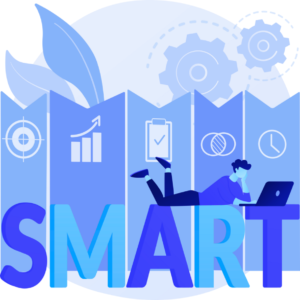 Specific objectives outline what needs to be achieved, leaving no room for ambiguity. Measurable objectives include quantifiable criteria to track progress and determine success. Achievable objectives are realistic and attainable within the given constraints and resources. Relevant objectives align with the broader organizational goals and add value to the strategic vision. Time-bound objectives have a defined timeline for completion, creating a sense of urgency and focus.
Specific objectives outline what needs to be achieved, leaving no room for ambiguity. Measurable objectives include quantifiable criteria to track progress and determine success. Achievable objectives are realistic and attainable within the given constraints and resources. Relevant objectives align with the broader organizational goals and add value to the strategic vision. Time-bound objectives have a defined timeline for completion, creating a sense of urgency and focus.
Stakeholder Alignment is critical to the success of the mission and objectives. Engaging key stakeholders early in the process helps ensure that their perspectives and expectations are considered. This alignment fosters a sense of ownership and commitment as stakeholders understand how their contributions impact the initiative’s overall success. Regular communication and stakeholder collaboration keep them informed and engaged, ensuring ongoing support and alignment.
Regular Review of Objectives is essential to ensure they remain relevant and achievable. The business environment is dynamic, and market conditions, organizational priorities, or external factors may necessitate objective adjustments. Regular reviews enable organizations to adapt their strategies and maintain focus on their goals. This iterative process of setting, reviewing, and refining objectives ensures continuous alignment with the mission and strategic vision.
Performance Metrics are vital for tracking progress and assessing the effectiveness of the strategic sourcing initiative. Metrics such as cost savings, procurement cycle time, supplier performance, and compliance rates provide tangible evidence of progress. By regularly monitoring these metrics, organizations can identify areas for improvement and make data-driven decisions. Performance metrics also facilitate accountability, as they provide a clear basis for evaluating the success of the initiative.
Examples of effective missions and objectives illustrate how these elements can guide strategic sourcing initiatives. For instance, a mission to “Enhance supplier relationships to drive innovation and quality improvement” can be supported by objectives like “Develop and implement a supplier performance management system within six months” and “Increase the number of collaborative innovation projects with key suppliers by 25% in the next year.”
In conclusion, a clear mission and well-defined objectives are foundational to the success of strategic sourcing initiatives. Organizations can ensure their sourcing efforts are focused, effective, and aligned with broader business goals by establishing a solid mission, setting SMART objectives, aligning stakeholders, regularly reviewing goals, and using performance metrics to track progress. This structured approach enhances the efficiency and effectiveness of sourcing activities and drives sustainable business growth and competitive advantage.

Chapter 7: Establish Authority to Proceed
Gaining the authority to proceed with strategic sourcing initiatives involves developing a solid proposal that clearly outlines the project’s value, objectives, and expected outcomes. This chapter covers the critical elements of a successful proposal, including executive summaries, project plans, team qualifications, integration capabilities, data security, scalability, cost breakdowns, and compliance documentation.
Executive Summaries provide a high-level overview of the project, highlighting its importance and value to the organization. This summary should be concise yet comprehensive, offering decision-makers a clear understanding of the project’s purpose and expected benefits. It should capture stakeholders’ attention and underscore the initiative’s strategic significance.
Project Plans detail the steps required to achieve the project’s objectives. This includes timelines, milestones, deliverables, and resource allocation. A well-structured project plan serves as a roadmap, guiding execution and ensuring all team members understand their roles and responsibilities. It also helps identify potential bottlenecks and plan for contingencies.
Team Qualifications highlight the project team’s skills, experience, and expertise. Demonstrating that the team has the necessary capabilities to execute the project successfully is crucial for gaining stakeholder confidence. This section should include profiles of key team members, outlining their relevant experience and past successes in similar projects.
Integration Capabilities addresses how the new initiative will fit the existing organizational framework. This includes ensuring compatibility with current systems, processes, and workflows. Effective integration is essential for minimizing disruptions and ensuring a smooth transition. This section should outline any necessary changes or adaptations required for successful integration.
Data Security is a critical consideration, especially for projects involving sensitive information. The proposal should detail measures for protecting data integrity, confidentiality, and availability. This includes outlining data security protocols, compliance with relevant regulations, and strategies for mitigating potential security risks.
Scalability addresses the project’s ability to grow and adapt to changing demands. A scalable solution can accommodate increased volumes and additional functionalities without significant rework. This section should explain how the project can be scaled up in the future and the steps needed to ensure scalability.
Cost Breakdowns provide a detailed analysis of the project’s financial aspects, including initial investment, ongoing operational costs, and potential savings. This section should include a cost-benefit analysis highlighting the project’s financial advantages. Transparent and thorough cost breakdowns help secure financial approval and demonstrate the project’s economic viability.
Compliance Documentation ensures the project adheres to all relevant laws, regulations, and industry standards. This includes data protection regulations, environmental guidelines, and other applicable compliance requirements. Providing comprehensive compliance documentation helps mitigate legal risks and gain regulatory approval.
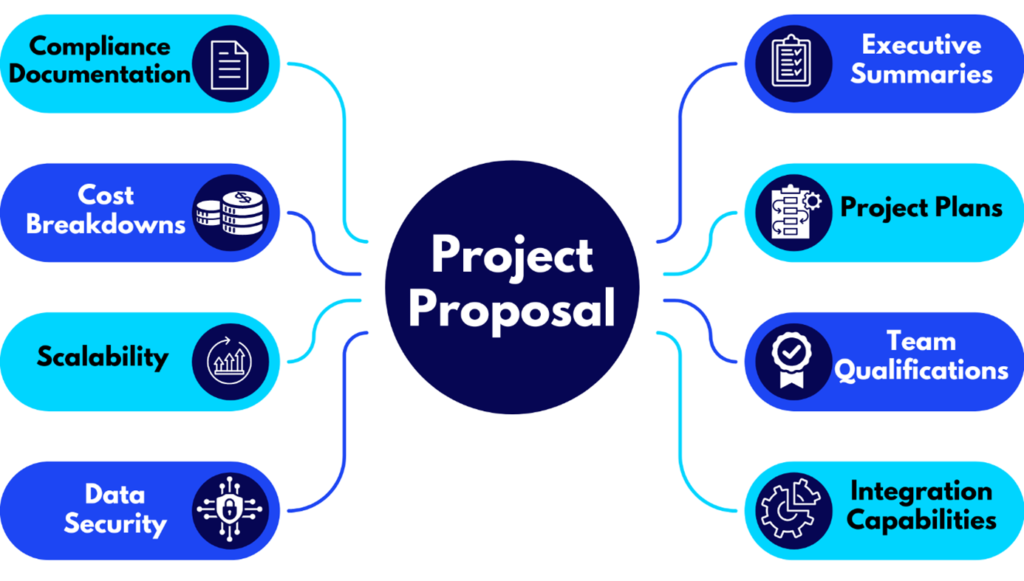
Engaging stakeholders is crucial throughout the proposal development process. Involving key stakeholders from the outset ensures that their insights and concerns are considered, fostering a sense of ownership and support for the project. Regular communication with stakeholders helps build trust and secure their buy-in.
Another critical component is addressing potential risks. The proposal should identify potential risks and outline strategies for mitigating them, including technical, financial, and operational risks. By demonstrating a thorough understanding of potential challenges and presenting clear mitigation plans, the proposal can build confidence in the project’s feasibility.
Securing necessary approvals involves presenting the proposal to decision-makers and stakeholders for endorsement. This requires clear, persuasive communication highlighting the project’s strategic value and alignment with organizational goals. The proposal should be supported by robust data and compelling arguments that justify the investment and effort required.
In conclusion, establishing authority to proceed with strategic sourcing initiatives requires a well-crafted proposal that outlines the project’s value, objectives, and expected outcomes. Organizations can present a compelling case by including executive summaries, detailed project plans, team qualifications, integration capabilities, data security measures, scalability, cost breakdowns, and compliance documentation. Engaging stakeholders, addressing potential risks, and securing necessary approvals are essential steps in gaining the support and authority needed to move forward with strategic sourcing initiatives. This comprehensive approach ensures the project is well-planned, aligned with strategic goals, and positioned for successful execution.

Chapter 8: Talent Management Strategies
The success of strategic sourcing initiatives hinges on effective talent management. This chapter delves into the strategies for selecting and onboarding consultants, assessing and developing skills, facilitating knowledge transfer, and managing time efficiently. It underscores the importance of integrating external talent into existing teams and processes to maximize their contributions.
The process of selecting and onboarding consultants is a crucial part of strategic sourcing initiatives. The selection process involves identifying the right external talent that aligns with the project’s requirements and organizational culture. This includes evaluating potential consultants based on their expertise, experience, and track record of success. A rigorous selection process might include interviews, skill assessments, and reference checks to ensure the chosen consultants possess the necessary qualifications and fit well within the team.
Onboarding is the next critical step, where consultants are introduced to the organization’s processes, systems, and culture. A comprehensive onboarding program ensures that consultants understand their roles and responsibilities and are equipped with the necessary tools and information to succeed. This includes providing access to essential resources, conducting orientation sessions, and facilitating introductions to key team members. Effective onboarding helps accelerate the integration of external talent, enabling them to contribute more quickly and effectively.
Assessing and Developing Skills: Regular skill assessment is essential to ensure that the team, including external consultants, possesses the capabilities to achieve project goals. This involves conducting performance evaluations, identifying skill gaps, and providing opportunities for professional development. Training programs, workshops, and mentoring can help develop the skills of both internal and external team members, enhancing their ability to contribute to the project’s success.
Facilitating Knowledge Transfer: Knowledge transfer is crucial for maintaining continuity and leveraging the expertise of external consultants. This involves creating mechanisms for sharing information and best practices between internal and external team members. Documentation of processes, regular knowledge-sharing sessions, and collaborative platforms can facilitate effective knowledge transfer. Ensuring that internal teams acquire the necessary knowledge and skills from consultants helps sustain the project’s success even after the consultants’ engagement ends.
Managing Time Efficiently: Time management is critical in strategic sourcing initiatives. Effective time management involves setting clear deadlines, prioritizing tasks, and ensuring all team members adhere to the project timeline. Project management tools and techniques can help track progress, manage workloads, and ensure timely task completion. Efficient time management minimizes delays and ensures that the project stays on track.
Integrating External Talent into Existing Teams and Processes: Successful integration of external talent requires creating a cohesive working environment where internal and external team members can collaborate effectively. Establishing clear communication channels, setting shared goals, and fostering a culture of teamwork and collaboration are essential. Regular team meetings, feedback sessions, and collaborative problem-solving activities can help build strong relationships and ensure alignment with project objectives.
Implementing Agile Processes: Agile methodologies can enhance flexibility, responsiveness, and collaboration in strategic sourcing initiatives. Agile processes involve iterative planning, continuous feedback, and adaptive project management. Organizations can adopt agile practices to respond more effectively to changes, manage uncertainties, and improve project outcomes. Agile methodologies encourage a collaborative approach, where team members, including external consultants, work closely together to achieve common goals.
Fostering a Collaborative Environment: A collaborative environment encourages open communication, mutual respect, and shared responsibility. This involves creating a culture where team members feel valued and empowered to contribute their ideas and expertise. Encouraging collaboration through team-building activities, recognition programs, and inclusive decision-making processes helps build a strong, cohesive team. A collaborative environment enhances creativity, innovation, and overall project performance.
In conclusion, effective talent management is crucial for the success of strategic sourcing initiatives. By focusing on selecting and onboarding the right consultants, assessing and developing skills, facilitating knowledge transfer, managing time efficiently, integrating external talent into existing teams, implementing agile processes, and fostering a collaborative environment, organizations can ensure that external resources contribute positively to their projects. These strategies support long-term success by maximizing the contributions of external talent and enhancing the overall effectiveness of strategic sourcing initiatives.

Chapter 9: Technology/Tools to Help
Leveraging technology platforms and tools is essential for managing complex strategic sourcing projects. This chapter covers project management software, communication platforms, performance analytics, and collaboration tools. It emphasizes the importance of continuously staying updated on new technologies and innovations to improve processes.
Project Management Software: These tools are crucial for planning, executing, and monitoring project activities. Project management software such as Microsoft Project, Asana, and Trello helps define project tasks, assign responsibilities, set deadlines, and track progress. These tools provide a centralized platform for managing resources, timelines, and deliverables, ensuring all team members are aligned and informed. They also offer features like Gantt charts, Kanban boards, and task dependencies, which help visualize project timelines and manage workflows effectively.
Communication Platforms: Effective communication is vital for the success of strategic sourcing initiatives. Tools like Slack, Microsoft Teams, and Zoom facilitate real-time communication and collaboration among team members, regardless of location. These platforms offer instant messaging, video conferencing, file sharing, and integration with other tools, enabling seamless communication and collaboration. By using these platforms, organizations can ensure that all stakeholders are informed and engaged, which helps resolve issues quickly and maintain project momentum.
Performance Analytics Tools: Analytics tools are essential for measuring and analyzing project performance. Tools like Tableau, Power BI, and Google Analytics provide insights into various project metrics, such as cost savings, supplier performance, and procurement cycle times. These tools help identify trends, spot inefficiencies, and make data-driven decisions. By leveraging performance analytics, organizations can continuously monitor project progress, evaluate the effectiveness of their sourcing strategies, and make necessary adjustments to achieve better outcomes.
Collaboration Tools: Collaboration tools enhance teamwork and coordination among project members. Tools like Google Workspace, SharePoint, and Dropbox enable team members to share documents, collaborate on files, and access information from anywhere. These tools support version control, real-time editing, and secure sharing, which are crucial for maintaining data integrity and ensuring all team members access the latest information. Practical collaboration tools help foster a collaborative environment, enhance productivity, and drive project success.
The chapter also highlights the role of technology in enhancing collaboration, streamlining processes, and providing real-time insights into project progress. Organizations can effectively utilize technology to ensure successful project execution and better outcomes.
Enhancing Collaboration: Technology facilitates seamless collaboration among team members, suppliers, and stakeholders. Collaboration tools and communication platforms help in breaking down silos, enabling cross-functional teams to work together effectively. Enhanced collaboration leads to better problem-solving, increased innovation, and improved project outcomes. By leveraging technology, organizations can create a collaborative environment that supports the successful execution of strategic sourcing initiatives.
Streamlining Processes: Technology helps automate and optimize various sourcing processes, such as procurement, contract management, and supplier evaluation. Automation tools like robotic process automation (RPA) can handle repetitive tasks, reduce manual errors, and increase efficiency. Workflow automation tools like Zapier and Nintex help streamline processes, ensure consistency, and reduce cycle times. By streamlining processes, organizations can achieve greater operational efficiency and focus on strategic activities that add value.
Providing Real-Time Insights: Technology enables organizations to gain real-time visibility into project progress and performance. Dashboards and reporting tools provide up-to-date information on key metrics, helping project managers make informed decisions. Real-time insights enable proactive management of issues, timely interventions, and continuous improvement. By leveraging real-time data, organizations can ensure that their strategic sourcing projects stay on track and achieve desired outcomes.
Staying Updated on New Technologies: The technology landscape constantly evolves, and staying updated on new tools and innovations is crucial for maintaining a competitive edge. Organizations should regularly review and assess their technology stack, attend industry conferences, participate in webinars, and engage with technology vendors to stay informed about the latest developments. Organizations can continuously improve their processes, enhance their capabilities, and drive better results by adopting new technologies.
In conclusion, leveraging technology platforms and tools is essential for managing complex strategic sourcing projects. Organizations can enhance collaboration, streamline processes, and gain real-time insights into project progress by utilizing project management software, communication platforms, performance analytics tools, and collaboration tools. Staying updated on new technologies and innovations is crucial for continuous improvement and better outcomes. By embracing technology, organizations can ensure successful project execution and drive the success of their strategic sourcing initiatives.

Chapter 10: Legal & Compliance Considerations
Navigating legal and compliance issues is crucial for protecting organizational interests in strategic sourcing initiatives. This chapter covers data protection, intellectual property rights, regulatory compliance, and other legal considerations. It emphasizes the importance of addressing these issues upfront to avoid potential legal challenges and ensure smooth project execution.
Data Protection: Ensuring the security and privacy of data is a fundamental concern in strategic sourcing. Organizations must comply with data protection regulations such as the General Data Protection Regulation (GDPR) in Europe or the California Consumer Privacy Act (CCPA) in the United States. These regulations impose stringent data handling, storage, and sharing requirements to protect individuals’ privacy and rights. Failure to comply can result in severe penalties and damage an organization’s reputation. Implementing robust data protection measures, including encryption, access controls, and regular audits, is essential for compliance and risk mitigation.
Intellectual Property Rights: Protecting intellectual property (IP) safeguards the organization’s innovations and competitive edge. This involves ensuring that the organization owns all software, technologies, and processes or is appropriately licensed in the project. Contracts with vendors should include clauses that address IP rights, ensuring that the organization retains ownership of any custom developments and that any third-party software used is legally licensed. By addressing IP considerations upfront, organizations can prevent disputes and potential legal challenges that could disrupt the project.
Regulatory Compliance: Adherence to industry-specific regulations and standards is critical for the legality and credibility of strategic sourcing initiatives. This may include environmental regulations, labor laws, and industry-specific standards. For instance, a company outsourcing its manufacturing operations must ensure that the vendor complies with local labor laws and environmental standards. Regulatory compliance helps avoid legal penalties and supports corporate social responsibility initiatives. Keeping abreast of regulatory changes and implementing necessary adjustments is crucial for maintaining compliance.
The chapter also highlights the role of legal and compliance teams in conducting due diligence, drafting contracts, and monitoring compliance throughout the project lifecycle. Due Diligence: Conducting thorough due diligence on potential vendors is essential to assess their compliance history and capabilities. This includes reviewing their policies, procedures, and past performance to meet legal and regulatory standards.
Drafting Contracts: Legal and compliance teams are critical in drafting comprehensive contracts that clearly outline all parties’ responsibilities, rights, and obligations. Contracts should include specific clauses related to data protection, IP rights, regulatory compliance, confidentiality, and dispute resolution. Well-drafted agreements serve as a legal safeguard and help prevent misunderstandings and conflicts.
Monitoring Compliance: Continuous monitoring of compliance throughout the project lifecycle ensures that all activities adhere to the agreed-upon standards and regulations. Regular audits, compliance checks, and performance reviews help identify any deviations and address them promptly.
Organizations can proactively mitigate risks and protect their interests by proactively managing legal and compliance issues. Addressing these considerations upfront ensures that strategic sourcing initiatives proceed smoothly, free from legal hurdles, and aligned with organizational goals. Proactive legal and compliance management safeguards the organization’s interests and enhances its reputation and trustworthiness in the market.

Chapter 11: Change Management and Stakeholder Communications
Effective change management and stakeholder communication are critical for the success of strategic sourcing initiatives. This chapter covers change management methodologies, communication plans, feedback mechanisms, and strategies for maintaining transparency and resolving conflicts.
Change Management Methodologies: Implementing change within an organization requires a structured approach. Standard methodologies include Kotter’s 8-Step Process, ADKAR (Awareness, Desire, Knowledge, Ability, Reinforcement), and Lewin’s Change Management Model. These frameworks guide organizations through the phases of change, from preparing for the shift to implementing and sustaining it. Kotter’s model, for instance, emphasizes creating a sense of urgency, building a guiding coalition, developing a vision and strategy, and consolidating gains to produce more change. ADKAR focuses on individual change and helps manage the people aspect of change by addressing their needs and resistance.
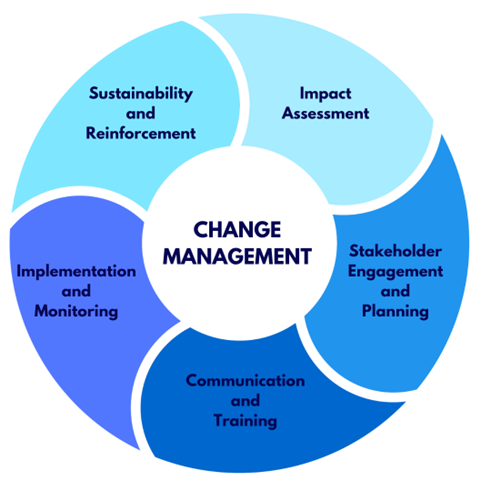
Communication Plans: A robust communication plan ensures that all stakeholders are informed and engaged throughout the change process. The plan should outline the key messages, communication channels, and frequency of updates. It should also identify the target audience for each message, ensuring that communication is tailored to their specific needs and concerns. Regular updates, newsletters, and town hall meetings can help keep stakeholders informed and involved. Clear and consistent communication helps prevent misinformation and reduces anxiety associated with change.
Feedback Mechanisms: Establishing feedback mechanisms allows stakeholders to voice their concerns, ask questions, and provide input. This can include surveys, suggestion boxes, focus groups, and one-on-one meetings. Feedback mechanisms enable organizations to gauge their stakeholders’ sentiments and promptly address issues. By actively listening to stakeholders, organizations can make informed decisions and adjustments, fostering a sense of involvement and ownership.
Strategies for Maintaining Transparency and Resolving Conflicts: Transparency is crucial for building trust and credibility. Organizations should be open about the reasons for the change, the expected benefits, and the potential challenges. This involves sharing both positive and negative news honestly and promptly. Transparency helps manage expectations and reduces resistance to change.
Conflicts are inevitable during change but can be managed effectively through proactive strategies. Conflict resolution techniques such as mediation, negotiation, and open dialogue can help address disagreements and find mutually acceptable solutions. Encouraging a culture of openness, where stakeholders feel comfortable expressing their concerns, is critical to resolving conflicts constructively.
The chapter emphasizes the importance of engaging stakeholders, addressing concerns, and fostering a collaborative environment. Engaging Stakeholders: Stakeholder engagement involves identifying all individuals and groups affected by the change and actively involving them in the process. This can be achieved through regular updates, interactive workshops, and stakeholder meetings. Engaging stakeholders helps build support for the change and ensures their perspectives are considered in decision-making.
Addressing Concerns: Addressing stakeholders’ concerns promptly and effectively is essential. This involves acknowledging their fears and uncertainties, providing clear and accurate information, and offering support. By addressing concerns, organizations can reduce resistance and increase acceptance of change.
Fostering a Collaborative Environment: Collaboration is vital for successful change implementation. Creating an environment where stakeholders can work together towards common goals encourages cooperation and innovation. This can be facilitated through team-building activities, joint problem-solving sessions, and collaborative platforms that enable real-time communication and collaboration.
Maintaining Clear and Transparent Communication: Clear and transparent communication is the cornerstone of effective change management. Organizations should ensure that all communication is straightforward, consistent, and accessible. This helps prevent misunderstandings and ensures all stakeholders align with the change objectives.
In conclusion, effective change management and stakeholder communication are critical for the success of strategic sourcing initiatives. Organizations can navigate the complexities of change by adopting structured change management methodologies, developing robust communication plans, establishing feedback mechanisms, and maintaining transparency. They can also engage stakeholders, address their concerns, and foster a collaborative environment to support successful project execution further. Organizations can build trust, ensure stakeholder alignment, and achieve strategic sourcing goals through clear and transparent communication.

Chapter 12: Scalability and Overview
Scalability is a crucial consideration for strategic sourcing initiatives. This chapter covers computer system scalability, business process scalability, and adapting to changing needs and technologies. It emphasizes the importance of designing solutions that can grow and evolve within the organization.
Computer System Scalability: It is crucial to ensure that IT infrastructure can scale to meet increased demand. Scalable systems can handle growing volumes of data, users, and transactions without compromising performance. This involves choosing technologies that support horizontal and vertical scaling, cloud computing solutions that offer flexibility, and modular architectures that allow for easy expansion. Effective scalability in computer systems ensures that organizations can maintain high performance and reliability as they grow.
Business Process Scalability: Beyond technology, business processes must also be scalable. This involves designing workflows and procedures that can be efficiently expanded or modified. Scalable business processes are adaptable and can accommodate increased workloads, new products or services, and changes in market conditions. Key strategies include automating repetitive tasks, standardizing processes, and implementing continuous improvement practices. Organizations can improve efficiency and maintain high service levels as they expand by ensuring scalable business processes.
Adapting to Changing Needs and Technologies: The business environment is dynamic, with constant changes in market demands, regulatory requirements, and technological advancements. Organizations need to be agile and able to adapt quickly to these changes. This involves staying updated on emerging technologies, investing in employee training, and fostering a culture of innovation. Regularly reviewing and updating strategic sourcing practices ensures the organization remains competitive and responsive to new opportunities and challenges.
Overview of the Workshop: This chapter also provides an overview, summarizing the key concepts and strategies covered. The workshop has addressed value identification and alignment, innovation, precise definitions, internal and external sourcing considerations, mission and objectives, establishing authority to proceed, talent management strategies, leveraging technology, legal and compliance considerations, change management, and stakeholder communication. Each element is critical to successful strategic sourcing and ensures that the initiatives are effective and aligned with organizational goals.
Focusing on scalability allows organizations to ensure that their strategic sourcing initiatives remain practical and relevant in a rapidly changing business environment. Scalability allows for sustainable growth, efficient resource utilization, and the ability to seize new opportunities. It also ensures that the organization maintains high-performance standards and adapts to evolving market conditions. This chapter underscores the importance of designing technological and business process solutions that can scale, thus supporting long-term success and resilience in strategic sourcing initiatives.
Curriculum
Strategic Sourcing and Management – Workshop 1 – Obtaining Value
- Value Identification and Alignment
- Innovation
- Definitions
- Can We Do This Internally?
- Let’s Look at External
- Mission and Objectives
- Establish Authority to Proceed
- Talent Management Strategies
- Technology/Tools to Help
- Legal & Compliance Considerations
- Change Management and Stakeholder Communications
- Scalability and Overview
Distance Learning
Introduction
Welcome to Appleton Greene and thank you for enrolling on the Strategic Sourcing and Management corporate training program. You will be learning through our unique facilitation via distance-learning method, which will enable you to practically implement everything that you learn academically. The methods and materials used in your program have been designed and developed to ensure that you derive the maximum benefits and enjoyment possible. We hope that you find the program challenging and fun to do. However, if you have never been a distance-learner before, you may be experiencing some trepidation at the task before you. So we will get you started by giving you some basic information and guidance on how you can make the best use of the modules, how you should manage the materials and what you should be doing as you work through them. This guide is designed to point you in the right direction and help you to become an effective distance-learner. Take a few hours or so to study this guide and your guide to tutorial support for students, while making notes, before you start to study in earnest.
Study environment
You will need to locate a quiet and private place to study, preferably a room where you can easily be isolated from external disturbances or distractions. Make sure the room is well-lit and incorporates a relaxed, pleasant feel. If you can spoil yourself within your study environment, you will have much more of a chance to ensure that you are always in the right frame of mind when you do devote time to study. For example, a nice fire, the ability to play soft soothing background music, soft but effective lighting, perhaps a nice view if possible and a good size desk with a comfortable chair. Make sure that your family know when you are studying and understand your study rules. Your study environment is very important. The ideal situation, if at all possible, is to have a separate study, which can be devoted to you. If this is not possible then you will need to pay a lot more attention to developing and managing your study schedule, because it will affect other people as well as yourself. The better your study environment, the more productive you will be.
Study tools & rules
Try and make sure that your study tools are sufficient and in good working order. You will need to have access to a computer, scanner and printer, with access to the internet. You will need a very comfortable chair, which supports your lower back, and you will need a good filing system. It can be very frustrating if you are spending valuable study time trying to fix study tools that are unreliable, or unsuitable for the task. Make sure that your study tools are up to date. You will also need to consider some study rules. Some of these rules will apply to you and will be intended to help you to be more disciplined about when and how you study. This distance-learning guide will help you and after you have read it you can put some thought into what your study rules should be. You will also need to negotiate some study rules for your family, friends or anyone who lives with you. They too will need to be disciplined in order to ensure that they can support you while you study. It is important to ensure that your family and friends are an integral part of your study team. Having their support and encouragement can prove to be a crucial contribution to your successful completion of the program. Involve them in as much as you can.
Successful distance-learning
Distance-learners are freed from the necessity of attending regular classes or workshops, since they can study in their own way, at their own pace and for their own purposes. But unlike traditional internal training courses, it is the student’s responsibility, with a distance-learning program, to ensure that they manage their own study contribution. This requires strong self-discipline and self-motivation skills and there must be a clear will to succeed. Those students who are used to managing themselves, are good at managing others and who enjoy working in isolation, are more likely to be good distance-learners. It is also important to be aware of the main reasons why you are studying and of the main objectives that you are hoping to achieve as a result. You will need to remind yourself of these objectives at times when you need to motivate yourself. Never lose sight of your long-term goals and your short-term objectives. There is nobody available here to pamper you, or to look after you, or to spoon-feed you with information, so you will need to find ways to encourage and appreciate yourself while you are studying. Make sure that you chart your study progress, so that you can be sure of your achievements and re-evaluate your goals and objectives regularly.
Self-assessment
Appleton Greene training programs are in all cases post-graduate programs. Consequently, you should already have obtained a business-related degree and be an experienced learner. You should therefore already be aware of your study strengths and weaknesses. For example, which time of the day are you at your most productive? Are you a lark or an owl? What study methods do you respond to the most? Are you a consistent learner? How do you discipline yourself? How do you ensure that you enjoy yourself while studying? It is important to understand yourself as a learner and so some self-assessment early on will be necessary if you are to apply yourself correctly. Perform a SWOT analysis on yourself as a student. List your internal strengths and weaknesses as a student and your external opportunities and threats. This will help you later on when you are creating a study plan. You can then incorporate features within your study plan that can ensure that you are playing to your strengths, while compensating for your weaknesses. You can also ensure that you make the most of your opportunities, while avoiding the potential threats to your success.
Accepting responsibility as a student
Training programs invariably require a significant investment, both in terms of what they cost and in the time that you need to contribute to study and the responsibility for successful completion of training programs rests entirely with the student. This is never more apparent than when a student is learning via distance-learning. Accepting responsibility as a student is an important step towards ensuring that you can successfully complete your training program. It is easy to instantly blame other people or factors when things go wrong. But the fact of the matter is that if a failure is your failure, then you have the power to do something about it, it is entirely in your own hands. If it is always someone else’s failure, then you are powerless to do anything about it. All students study in entirely different ways, this is because we are all individuals and what is right for one student, is not necessarily right for another. In order to succeed, you will have to accept personal responsibility for finding a way to plan, implement and manage a personal study plan that works for you. If you do not succeed, you only have yourself to blame.
Planning
By far the most critical contribution to stress, is the feeling of not being in control. In the absence of planning we tend to be reactive and can stumble from pillar to post in the hope that things will turn out fine in the end. Invariably they don’t! In order to be in control, we need to have firm ideas about how and when we want to do things. We also need to consider as many possible eventualities as we can, so that we are prepared for them when they happen. Prescriptive Change, is far easier to manage and control, than Emergent Change. The same is true with distance-learning. It is much easier and much more enjoyable, if you feel that you are in control and that things are going to plan. Even when things do go wrong, you are prepared for them and can act accordingly without any unnecessary stress. It is important therefore that you do take time to plan your studies properly.
Management
Once you have developed a clear study plan, it is of equal importance to ensure that you manage the implementation of it. Most of us usually enjoy planning, but it is usually during implementation when things go wrong. Targets are not met and we do not understand why. Sometimes we do not even know if targets are being met. It is not enough for us to conclude that the study plan just failed. If it is failing, you will need to understand what you can do about it. Similarly if your study plan is succeeding, it is still important to understand why, so that you can improve upon your success. You therefore need to have guidelines for self-assessment so that you can be consistent with performance improvement throughout the program. If you manage things correctly, then your performance should constantly improve throughout the program.
Study objectives & tasks
The first place to start is developing your program objectives. These should feature your reasons for undertaking the training program in order of priority. Keep them succinct and to the point in order to avoid confusion. Do not just write the first things that come into your head because they are likely to be too similar to each other. Make a list of possible departmental headings, such as: Customer Service; E-business; Finance; Globalization; Human Resources; Technology; Legal; Management; Marketing and Production. Then brainstorm for ideas by listing as many things that you want to achieve under each heading and later re-arrange these things in order of priority. Finally, select the top item from each department heading and choose these as your program objectives. Try and restrict yourself to five because it will enable you to focus clearly. It is likely that the other things that you listed will be achieved if each of the top objectives are achieved. If this does not prove to be the case, then simply work through the process again.
Study forecast
As a guide, the Appleton Greene Strategic Sourcing and Management corporate training program should take 12-18 months to complete, depending upon your availability and current commitments. The reason why there is such a variance in time estimates is because every student is an individual, with differing productivity levels and different commitments. These differentiations are then exaggerated by the fact that this is a distance-learning program, which incorporates the practical integration of academic theory as an as a part of the training program. Consequently all of the project studies are real, which means that important decisions and compromises need to be made. You will want to get things right and will need to be patient with your expectations in order to ensure that they are. We would always recommend that you are prudent with your own task and time forecasts, but you still need to develop them and have a clear indication of what are realistic expectations in your case. With reference to your time planning: consider the time that you can realistically dedicate towards study with the program every week; calculate how long it should take you to complete the program, using the guidelines featured here; then break the program down into logical modules and allocate a suitable proportion of time to each of them, these will be your milestones; you can create a time plan by using a spreadsheet on your computer, or a personal organizer such as MS Outlook, you could also use a financial forecasting software; break your time forecasts down into manageable chunks of time, the more specific you can be, the more productive and accurate your time management will be; finally, use formulas where possible to do your time calculations for you, because this will help later on when your forecasts need to change in line with actual performance. With reference to your task planning: refer to your list of tasks that need to be undertaken in order to achieve your program objectives; with reference to your time plan, calculate when each task should be implemented; remember that you are not estimating when your objectives will be achieved, but when you will need to focus upon implementing the corresponding tasks; you also need to ensure that each task is implemented in conjunction with the associated training modules which are relevant; then break each single task down into a list of specific to do’s, say approximately ten to do’s for each task and enter these into your study plan; once again you could use MS Outlook to incorporate both your time and task planning and this could constitute your study plan; you could also use a project management software like MS Project. You should now have a clear and realistic forecast detailing when you can expect to be able to do something about undertaking the tasks to achieve your program objectives.
Performance management
It is one thing to develop your study forecast, it is quite another to monitor your progress. Ultimately it is less important whether you achieve your original study forecast and more important that you update it so that it constantly remains realistic in line with your performance. As you begin to work through the program, you will begin to have more of an idea about your own personal performance and productivity levels as a distance-learner. Once you have completed your first study module, you should re-evaluate your study forecast for both time and tasks, so that they reflect your actual performance level achieved. In order to achieve this you must first time yourself while training by using an alarm clock. Set the alarm for hourly intervals and make a note of how far you have come within that time. You can then make a note of your actual performance on your study plan and then compare your performance against your forecast. Then consider the reasons that have contributed towards your performance level, whether they are positive or negative and make a considered adjustment to your future forecasts as a result. Given time, you should start achieving your forecasts regularly.
With reference to time management: time yourself while you are studying and make a note of the actual time taken in your study plan; consider your successes with time-efficiency and the reasons for the success in each case and take this into consideration when reviewing future time planning; consider your failures with time-efficiency and the reasons for the failures in each case and take this into consideration when reviewing future time planning; re-evaluate your study forecast in relation to time planning for the remainder of your training program to ensure that you continue to be realistic about your time expectations. You need to be consistent with your time management, otherwise you will never complete your studies. This will either be because you are not contributing enough time to your studies, or you will become less efficient with the time that you do allocate to your studies. Remember, if you are not in control of your studies, they can just become yet another cause of stress for you.
With reference to your task management: time yourself while you are studying and make a note of the actual tasks that you have undertaken in your study plan; consider your successes with task-efficiency and the reasons for the success in each case; take this into consideration when reviewing future task planning; consider your failures with task-efficiency and the reasons for the failures in each case and take this into consideration when reviewing future task planning; re-evaluate your study forecast in relation to task planning for the remainder of your training program to ensure that you continue to be realistic about your task expectations. You need to be consistent with your task management, otherwise you will never know whether you are achieving your program objectives or not.
Keeping in touch
You will have access to qualified and experienced professors and tutors who are responsible for providing tutorial support for your particular training program. So don’t be shy about letting them know how you are getting on. We keep electronic records of all tutorial support emails so that professors and tutors can review previous correspondence before considering an individual response. It also means that there is a record of all communications between you and your professors and tutors and this helps to avoid any unnecessary duplication, misunderstanding, or misinterpretation. If you have a problem relating to the program, share it with them via email. It is likely that they have come across the same problem before and are usually able to make helpful suggestions and steer you in the right direction. To learn more about when and how to use tutorial support, please refer to the Tutorial Support section of this student information guide. This will help you to ensure that you are making the most of tutorial support that is available to you and will ultimately contribute towards your success and enjoyment with your training program.
Work colleagues and family
You should certainly discuss your program study progress with your colleagues, friends and your family. Appleton Greene training programs are very practical. They require you to seek information from other people, to plan, develop and implement processes with other people and to achieve feedback from other people in relation to viability and productivity. You will therefore have plenty of opportunities to test your ideas and enlist the views of others. People tend to be sympathetic towards distance-learners, so don’t bottle it all up in yourself. Get out there and share it! It is also likely that your family and colleagues are going to benefit from your labors with the program, so they are likely to be much more interested in being involved than you might think. Be bold about delegating work to those who might benefit themselves. This is a great way to achieve understanding and commitment from people who you may later rely upon for process implementation. Share your experiences with your friends and family.
Making it relevant
The key to successful learning is to make it relevant to your own individual circumstances. At all times you should be trying to make bridges between the content of the program and your own situation. Whether you achieve this through quiet reflection or through interactive discussion with your colleagues, client partners or your family, remember that it is the most important and rewarding aspect of translating your studies into real self-improvement. You should be clear about how you want the program to benefit you. This involves setting clear study objectives in relation to the content of the course in terms of understanding, concepts, completing research or reviewing activities and relating the content of the modules to your own situation. Your objectives may understandably change as you work through the program, in which case you should enter the revised objectives on your study plan so that you have a permanent reminder of what you are trying to achieve, when and why.
Distance-learning check-list
Prepare your study environment, your study tools and rules.
Undertake detailed self-assessment in terms of your ability as a learner.
Create a format for your study plan.
Consider your study objectives and tasks.
Create a study forecast.
Assess your study performance.
Re-evaluate your study forecast.
Be consistent when managing your study plan.
Use your Appleton Greene Certified Learning Provider (CLP) for tutorial support.
Make sure you keep in touch with those around you.

Tutorial Support
Programs
Appleton Greene uses standard and bespoke corporate training programs as vessels to transfer business process improvement knowledge into the heart of our clients’ organizations. Each individual program focuses upon the implementation of a specific business process, which enables clients to easily quantify their return on investment. There are hundreds of established Appleton Greene corporate training products now available to clients within customer services, e-business, finance, globalization, human resources, information technology, legal, management, marketing and production. It does not matter whether a client’s employees are located within one office, or an unlimited number of international offices, we can still bring them together to learn and implement specific business processes collectively. Our approach to global localization enables us to provide clients with a truly international service with that all important personal touch. Appleton Greene corporate training programs can be provided virtually or locally and they are all unique in that they individually focus upon a specific business function. They are implemented over a sustainable period of time and professional support is consistently provided by qualified learning providers and specialist consultants.
Support available
You will have a designated Certified Learning Provider (CLP) and an Accredited Consultant and we encourage you to communicate with them as much as possible. In all cases tutorial support is provided online because we can then keep a record of all communications to ensure that tutorial support remains consistent. You would also be forwarding your work to the tutorial support unit for evaluation and assessment. You will receive individual feedback on all of the work that you undertake on a one-to-one basis, together with specific recommendations for anything that may need to be changed in order to achieve a pass with merit or a pass with distinction and you then have as many opportunities as you may need to re-submit project studies until they meet with the required standard. Consequently the only reason that you should really fail (CLP) is if you do not do the work. It makes no difference to us whether a student takes 12 months or 18 months to complete the program, what matters is that in all cases the same quality standard will have been achieved.
Support Process
Please forward all of your future emails to the designated (CLP) Tutorial Support Unit email address that has been provided and please do not duplicate or copy your emails to other AGC email accounts as this will just cause unnecessary administration. Please note that emails are always answered as quickly as possible but you will need to allow a period of up to 20 business days for responses to general tutorial support emails during busy periods, because emails are answered strictly within the order in which they are received. You will also need to allow a period of up to 30 business days for the evaluation and assessment of project studies. This does not include weekends or public holidays. Please therefore kindly allow for this within your time planning. All communications are managed online via email because it enables tutorial service support managers to review other communications which have been received before responding and it ensures that there is a copy of all communications retained on file for future reference. All communications will be stored within your personal (CLP) study file here at Appleton Greene throughout your designated study period. If you need any assistance or clarification at any time, please do not hesitate to contact us by forwarding an email and remember that we are here to help. If you have any questions, please list and number your questions succinctly and you can then be sure of receiving specific answers to each and every query.
Time Management
It takes approximately 1 Year to complete the Strategic Sourcing and Management corporate training program, incorporating 12 x 6-hour monthly workshops. Each student will also need to contribute approximately 4 hours per week over 1 Year of their personal time. Students can study from home or work at their own pace and are responsible for managing their own study plan. There are no formal examinations and students are evaluated and assessed based upon their project study submissions, together with the quality of their internal analysis and supporting documents. They can contribute more time towards study when they have the time to do so and can contribute less time when they are busy. All students tend to be in full time employment while studying and the Strategic Sourcing and Management program is purposely designed to accommodate this, so there is plenty of flexibility in terms of time management. It makes no difference to us at Appleton Greene, whether individuals take 12-18 months to complete this program. What matters is that in all cases the same standard of quality will have been achieved with the standard and bespoke programs that have been developed.
Distance Learning Guide
The distance learning guide should be your first port of call when starting your training program. It will help you when you are planning how and when to study, how to create the right environment and how to establish the right frame of mind. If you can lay the foundations properly during the planning stage, then it will contribute to your enjoyment and productivity while training later. The guide helps to change your lifestyle in order to accommodate time for study and to cultivate good study habits. It helps you to chart your progress so that you can measure your performance and achieve your goals. It explains the tools that you will need for study and how to make them work. It also explains how to translate academic theory into practical reality. Spend some time now working through your distance learning guide and make sure that you have firm foundations in place so that you can make the most of your distance learning program. There is no requirement for you to attend training workshops or classes at Appleton Greene offices. The entire program is undertaken online, program course manuals and project studies are administered via the Appleton Greene web site and via email, so you are able to study at your own pace and in the comfort of your own home or office as long as you have a computer and access to the internet.
How To Study
The how to study guide provides students with a clear understanding of the Appleton Greene facilitation via distance learning training methods and enables students to obtain a clear overview of the training program content. It enables students to understand the step-by-step training methods used by Appleton Greene and how course manuals are integrated with project studies. It explains the research and development that is required and the need to provide evidence and references to support your statements. It also enables students to understand precisely what will be required of them in order to achieve a pass with merit and a pass with distinction for individual project studies and provides useful guidance on how to be innovative and creative when developing your Unique Program Proposition (UPP).
Tutorial Support
Tutorial support for the Appleton Greene Strategic Sourcing and Management corporate training program is provided online either through the Appleton Greene Client Support Portal (CSP), or via email. All tutorial support requests are facilitated by a designated Program Administration Manager (PAM). They are responsible for deciding which professor or tutor is the most appropriate option relating to the support required and then the tutorial support request is forwarded onto them. Once the professor or tutor has completed the tutorial support request and answered any questions that have been asked, this communication is then returned to the student via email by the designated Program Administration Manager (PAM). This enables all tutorial support, between students, professors and tutors, to be facilitated by the designated Program Administration Manager (PAM) efficiently and securely through the email account. You will therefore need to allow a period of up to 20 business days for responses to general support queries and up to 30 business days for the evaluation and assessment of project studies, because all tutorial support requests are answered strictly within the order in which they are received. This does not include weekends or public holidays. Consequently you need to put some thought into the management of your tutorial support procedure in order to ensure that your study plan is feasible and to obtain the maximum possible benefit from tutorial support during your period of study. Please retain copies of your tutorial support emails for future reference. Please ensure that ALL of your tutorial support emails are set out using the format as suggested within your guide to tutorial support. Your tutorial support emails need to be referenced clearly to the specific part of the course manual or project study which you are working on at any given time. You also need to list and number any questions that you would like to ask, up to a maximum of five questions within each tutorial support email. Remember the more specific you can be with your questions the more specific your answers will be too and this will help you to avoid any unnecessary misunderstanding, misinterpretation, or duplication. The guide to tutorial support is intended to help you to understand how and when to use support in order to ensure that you get the most out of your training program. Appleton Greene training programs are designed to enable you to do things for yourself. They provide you with a structure or a framework and we use tutorial support to facilitate students while they practically implement what they learn. In other words, we are enabling students to do things for themselves. The benefits of distance learning via facilitation are considerable and are much more sustainable in the long-term than traditional short-term knowledge sharing programs. Consequently you should learn how and when to use tutorial support so that you can maximize the benefits from your learning experience with Appleton Greene. This guide describes the purpose of each training function and how to use them and how to use tutorial support in relation to each aspect of the training program. It also provides useful tips and guidance with regard to best practice.
Tutorial Support Tips
Students are often unsure about how and when to use tutorial support with Appleton Greene. This Tip List will help you to understand more about how to achieve the most from using tutorial support. Refer to it regularly to ensure that you are continuing to use the service properly. Tutorial support is critical to the success of your training experience, but it is important to understand when and how to use it in order to maximize the benefit that you receive. It is no coincidence that those students who succeed are those that learn how to be positive, proactive and productive when using tutorial support.
Be positive and friendly with your tutorial support emails
Remember that if you forward an email to the tutorial support unit, you are dealing with real people. “Do unto others as you would expect others to do unto you”. If you are positive, complimentary and generally friendly in your emails, you will generate a similar response in return. This will be more enjoyable, productive and rewarding for you in the long-term.
Think about the impression that you want to create
Every time that you communicate, you create an impression, which can be either positive or negative, so put some thought into the impression that you want to create. Remember that copies of all tutorial support emails are stored electronically and tutors will always refer to prior correspondence before responding to any current emails. Over a period of time, a general opinion will be arrived at in relation to your character, attitude and ability. Try to manage your own frustrations, mood swings and temperament professionally, without involving the tutorial support team. Demonstrating frustration or a lack of patience is a weakness and will be interpreted as such. The good thing about communicating in writing, is that you will have the time to consider your content carefully, you can review it and proof-read it before sending your email to Appleton Greene and this should help you to communicate more professionally, consistently and to avoid any unnecessary knee-jerk reactions to individual situations as and when they may arise. Please also remember that the CLP Tutorial Support Unit will not just be responsible for evaluating and assessing the quality of your work, they will also be responsible for providing recommendations to other learning providers and to client contacts within the Appleton Greene global client network, so do be in control of your own emotions and try to create a good impression.
Remember that quality is preferred to quantity
Please remember that when you send an email to the tutorial support team, you are not using Twitter or Text Messaging. Try not to forward an email every time that you have a thought. This will not prove to be productive either for you or for the tutorial support team. Take time to prepare your communications properly, as if you were writing a professional letter to a business colleague and make a list of queries that you are likely to have and then incorporate them within one email, say once every month, so that the tutorial support team can understand more about context, application and your methodology for study. Get yourself into a consistent routine with your tutorial support requests and use the tutorial support template provided with ALL of your emails. The (CLP) Tutorial Support Unit will not spoon-feed you with information. They need to be able to evaluate and assess your tutorial support requests carefully and professionally.
Be specific about your questions in order to receive specific answers
Try not to write essays by thinking as you are writing tutorial support emails. The tutorial support unit can be unclear about what in fact you are asking, or what you are looking to achieve. Be specific about asking questions that you want answers to. Number your questions. You will then receive specific answers to each and every question. This is the main purpose of tutorial support via email.
Keep a record of your tutorial support emails
It is important that you keep a record of all tutorial support emails that are forwarded to you. You can then refer to them when necessary and it avoids any unnecessary duplication, misunderstanding, or misinterpretation.
Individual training workshops or telephone support
Please be advised that Appleton Greene does not provide separate or individual tutorial support meetings, workshops, or provide telephone support for individual students. Appleton Greene is an equal opportunities learning and service provider and we are therefore understandably bound to treat all students equally. We cannot therefore broker special financial or study arrangements with individual students regardless of the circumstances. All tutorial support is provided online and this enables Appleton Greene to keep a record of all communications between students, professors and tutors on file for future reference, in accordance with our quality management procedure and your terms and conditions of enrolment. All tutorial support is provided online via email because it enables us to have time to consider support content carefully, it ensures that you receive a considered and detailed response to your queries. You can number questions that you would like to ask, which relate to things that you do not understand or where clarification may be required. You can then be sure of receiving specific answers to each individual query. You will also then have a record of these communications and of all tutorial support, which has been provided to you. This makes tutorial support administration more productive by avoiding any unnecessary duplication, misunderstanding, or misinterpretation.
Tutorial Support Email Format
You should use this tutorial support format if you need to request clarification or assistance while studying with your training program. Please note that ALL of your tutorial support request emails should use the same format. You should therefore set up a standard email template, which you can then use as and when you need to. Emails that are forwarded to Appleton Greene, which do not use the following format, may be rejected and returned to you by the (CLP) Program Administration Manager. A detailed response will then be forwarded to you via email usually within 20 business days of receipt for general support queries and 30 business days for the evaluation and assessment of project studies. This does not include weekends or public holidays. Your tutorial support request, together with the corresponding TSU reply, will then be saved and stored within your electronic TSU file at Appleton Greene for future reference.
Subject line of your email
Please insert: Appleton Greene (CLP) Tutorial Support Request: (Your Full Name) (Date), within the subject line of your email.
Main body of your email
Please insert:
1. Appleton Greene Certified Learning Provider (CLP) Tutorial Support Request
2. Your Full Name
3. Date of TS request
4. Preferred email address
5. Backup email address
6. Course manual page name or number (reference)
7. Project study page name or number (reference)
Subject of enquiry
Please insert a maximum of 50 words (please be succinct)
Briefly outline the subject matter of your inquiry, or what your questions relate to.
Question 1
Maximum of 50 words (please be succinct)
Maximum of 50 words (please be succinct)
Question 3
Maximum of 50 words (please be succinct)
Question 4
Maximum of 50 words (please be succinct)
Question 5
Maximum of 50 words (please be succinct)
Please note that a maximum of 5 questions is permitted with each individual tutorial support request email.
Procedure
* List the questions that you want to ask first, then re-arrange them in order of priority. Make sure that you reference them, where necessary, to the course manuals or project studies.
* Make sure that you are specific about your questions and number them. Try to plan the content within your emails to make sure that it is relevant.
* Make sure that your tutorial support emails are set out correctly, using the Tutorial Support Email Format provided here.
* Save a copy of your email and incorporate the date sent after the subject title. Keep your tutorial support emails within the same file and in date order for easy reference.
* Allow up to 20 business days for a response to general tutorial support emails and up to 30 business days for the evaluation and assessment of project studies, because detailed individual responses will be made in all cases and tutorial support emails are answered strictly within the order in which they are received.
* Emails can and do get lost. So if you have not received a reply within the appropriate time, forward another copy or a reminder to the tutorial support unit to be sure that it has been received but do not forward reminders unless the appropriate time has elapsed.
* When you receive a reply, save it immediately featuring the date of receipt after the subject heading for easy reference. In most cases the tutorial support unit replies to your questions individually, so you will have a record of the questions that you asked as well as the answers offered. With project studies however, separate emails are usually forwarded by the tutorial support unit, so do keep a record of your own original emails as well.
* Remember to be positive and friendly in your emails. You are dealing with real people who will respond to the same things that you respond to.
* Try not to repeat questions that have already been asked in previous emails. If this happens the tutorial support unit will probably just refer you to the appropriate answers that have already been provided within previous emails.
* If you lose your tutorial support email records you can write to Appleton Greene to receive a copy of your tutorial support file, but a separate administration charge may be levied for this service.

How To Study
Your Certified Learning Provider (CLP) and Accredited Consultant can help you to plan a task list for getting started so that you can be clear about your direction and your priorities in relation to your training program. It is also a good way to introduce yourself to the tutorial support team.
Planning your study environment
Your study conditions are of great importance and will have a direct effect on how much you enjoy your training program. Consider how much space you will have, whether it is comfortable and private and whether you are likely to be disturbed. The study tools and facilities at your disposal are also important to the success of your distance-learning experience. Your tutorial support unit can help with useful tips and guidance, regardless of your starting position. It is important to get this right before you start working on your training program.
Planning your program objectives
It is important that you have a clear list of study objectives, in order of priority, before you start working on your training program. Your tutorial support unit can offer assistance here to ensure that your study objectives have been afforded due consideration and priority.
Planning how and when to study
Distance-learners are freed from the necessity of attending regular classes, since they can study in their own way, at their own pace and for their own purposes. This approach is designed to let you study efficiently away from the traditional classroom environment. It is important however, that you plan how and when to study, so that you are making the most of your natural attributes, strengths and opportunities. Your tutorial support unit can offer assistance and useful tips to ensure that you are playing to your strengths.
Planning your study tasks
You should have a clear understanding of the study tasks that you should be undertaking and the priority associated with each task. These tasks should also be integrated with your program objectives. The distance learning guide and the guide to tutorial support for students should help you here, but if you need any clarification or assistance, please contact your tutorial support unit.
Planning your time
You will need to allocate specific times during your calendar when you intend to study if you are to have a realistic chance of completing your program on time. You are responsible for planning and managing your own study time, so it is important that you are successful with this. Your tutorial support unit can help you with this if your time plan is not working.
Keeping in touch
Consistency is the key here. If you communicate too frequently in short bursts, or too infrequently with no pattern, then your management ability with your studies will be questioned, both by you and by your tutorial support unit. It is obvious when a student is in control and when one is not and this will depend how able you are at sticking with your study plan. Inconsistency invariably leads to in-completion.
Charting your progress
Your tutorial support team can help you to chart your own study progress. Refer to your distance learning guide for further details.
Making it work
To succeed, all that you will need to do is apply yourself to undertaking your training program and interpreting it correctly. Success or failure lies in your hands and your hands alone, so be sure that you have a strategy for making it work. Your Certified Learning Provider (CLP) and Accredited Consultant can guide you through the process of program planning, development and implementation.
Reading methods
Interpretation is often unique to the individual but it can be improved and even quantified by implementing consistent interpretation methods. Interpretation can be affected by outside interference such as family members, TV, or the Internet, or simply by other thoughts which are demanding priority in our minds. One thing that can improve our productivity is using recognized reading methods. This helps us to focus and to be more structured when reading information for reasons of importance, rather than relaxation.
Speed reading
When reading through course manuals for the first time, subconsciously set your reading speed to be just fast enough that you cannot dwell on individual words or tables. With practice, you should be able to read an A4 sheet of paper in one minute. You will not achieve much in the way of a detailed understanding, but your brain will retain a useful overview. This overview will be important later on and will enable you to keep individual issues in perspective with a more generic picture because speed reading appeals to the memory part of the brain. Do not worry about what you do or do not remember at this stage.
Content reading
Once you have speed read everything, you can then start work in earnest. You now need to read a particular section of your course manual thoroughly, by making detailed notes while you read. This process is called Content Reading and it will help to consolidate your understanding and interpretation of the information that has been provided.
Making structured notes on the course manuals
When you are content reading, you should be making detailed notes, which are both structured and informative. Make these notes in a MS Word document on your computer, because you can then amend and update these as and when you deem it to be necessary. List your notes under three headings: 1. Interpretation – 2. Questions – 3. Tasks. The purpose of the 1st section is to clarify your interpretation by writing it down. The purpose of the 2nd section is to list any questions that the issue raises for you. The purpose of the 3rd section is to list any tasks that you should undertake as a result. Anyone who has graduated with a business-related degree should already be familiar with this process.
Organizing structured notes separately
You should then transfer your notes to a separate study notebook, preferably one that enables easy referencing, such as a MS Word Document, a MS Excel Spreadsheet, a MS Access Database, or a personal organizer on your cell phone. Transferring your notes allows you to have the opportunity of cross-checking and verifying them, which assists considerably with understanding and interpretation. You will also find that the better you are at doing this, the more chance you will have of ensuring that you achieve your study objectives.
Question your understanding
Do challenge your understanding. Explain things to yourself in your own words by writing things down.
Clarifying your understanding
If you are at all unsure, forward an email to your tutorial support unit and they will help to clarify your understanding.
Question your interpretation
Do challenge your interpretation. Qualify your interpretation by writing it down.
Clarifying your interpretation
If you are at all unsure, forward an email to your tutorial support unit and they will help to clarify your interpretation.
Qualification Requirements
The student will need to successfully complete the project study and all of the exercises relating to the Strategic Sourcing and Management corporate training program, achieving a pass with merit or distinction in each case, in order to qualify as an Accredited Strategic Sourcing and Management Specialist (APTS). All monthly workshops need to be tried and tested within your company. These project studies can be completed in your own time and at your own pace and in the comfort of your own home or office. There are no formal examinations, assessment is based upon the successful completion of the project studies. They are called project studies because, unlike case studies, these projects are not theoretical, they incorporate real program processes that need to be properly researched and developed. The project studies assist us in measuring your understanding and interpretation of the training program and enable us to assess qualification merits. All of the project studies are based entirely upon the content within the training program and they enable you to integrate what you have learnt into your corporate training practice.
Strategic Sourcing and Management – Grading Contribution
Project Study – Grading Contribution
Customer Service – 10%
E-business – 05%
Finance – 10%
Globalization – 10%
Human Resources – 10%
Information Technology – 10%
Legal – 05%
Management – 10%
Marketing – 10%
Production – 10%
Education – 05%
Logistics – 05%
TOTAL GRADING – 100%
Qualification grades
A mark of 90% = Pass with Distinction.
A mark of 75% = Pass with Merit.
A mark of less than 75% = Fail.
If you fail to achieve a mark of 75% with a project study, you will receive detailed feedback from the Certified Learning Provider (CLP) and/or Accredited Consultant, together with a list of tasks which you will need to complete, in order to ensure that your project study meets with the minimum quality standard that is required by Appleton Greene. You can then re-submit your project study for further evaluation and assessment. Indeed you can re-submit as many drafts of your project studies as you need to, until such a time as they eventually meet with the required standard by Appleton Greene, so you need not worry about this, it is all part of the learning process.
When marking project studies, Appleton Greene is looking for sufficient evidence of the following:
Pass with merit
A satisfactory level of program understanding
A satisfactory level of program interpretation
A satisfactory level of project study content presentation
A satisfactory level of Unique Program Proposition (UPP) quality
A satisfactory level of the practical integration of academic theory
Pass with distinction
An exceptional level of program understanding
An exceptional level of program interpretation
An exceptional level of project study content presentation
An exceptional level of Unique Program Proposition (UPP) quality
An exceptional level of the practical integration of academic theory
Preliminary Analysis
Introduction to Defining Requirements
Article: ” Determine user requirements now to avoid problems later” – Link
This article discusses why precise requirements are crucial for the success of IT projects and provides tips for defining them effectively.
Study: “Challenges in Requirements Engineering: A Literature Review” – Link
This study reviews common challenges in requirements engineering and offers insights into overcoming them.
Stakeholder Identification and Analysis
Guide: “Stakeholder Analysis: Winning Support for Your Projects” – Link
This guide explains how to identify and analyze stakeholders, ensuring their needs and expectations are considered in project planning.
Tool: “Stakeholder Mapping and Analysis Template” – Link
A practical template to help you map and analyze project stakeholders.
Business Process Analysis
Article: ” Business Process Analysis: A step-by-step approach” – Link
A step-by-step guide on conducting business process analysis.
Scalability and Flexibility
White Paper: “Building Scalable IT Solutions” – Link
A white paper on designing IT solutions that scale with business growth.
Article: “Ensuring Flexibility in IT Projects” – Link
An article discussing the importance of flexibility in IT project planning and execution.

Assignment – Preparation for Workshop 2
Objective:
Prepare for Workshop 2 using the CaseComplete tool to identify and articulate key elements such as actors, requirements, stakeholders, and other crucial factors within your organization.
The CaseComplete tool is a project management application that helps streamline project planning and documentation. It aids in identifying and managing project requirements, stakeholders, timelines, and deliverables. With comprehensive documentation and progress tracking features, it enhances communication and collaboration, ensuring all stakeholders are aligned and informed throughout the project lifecycle. This tool is handy for IT projects requiring detailed documentation and precise stakeholder management.
Assignment Instructions:
• Download and Explore the CaseComplete Tool:
Visit the official CaseComplete website (www.casecomplete.com) and download the tool’s free version with the example provided. Ensure you familiarize yourself with its features and functionalities.
• Actor/Stakeholder Analysis:
Identify the critical actors in the example. What are their roles?
• Identify Key Requirements:
Using the CaseComplete tool, identify the requirements for the example project. What are they?
• Articulation of Requirements and Stakeholders:
Reflect on how the identified requirements and stakeholders should be articulated within your organization. Think about:
Communication Strategies: How will you communicate these requirements and stakeholders’ roles to ensure clarity and buy-in?
Documentation: How will you document these elements for transparency and future reference?
Integration: How will these requirements and stakeholders be integrated into your project planning and execution processes?
Course Manuals 1-12
Course Manual 1: Value Identification and Alignment
Any initiative’s primary goal is to provide value to the company, whether by developing new goods or improving how things are done. Finding and utilizing outside talent while reducing outsourcing risks is a proven innovation strategy. We will require outside expertise and resources to increase our internal capabilities for that plan. It will be crucial to comprehend how other businesses have built the infrastructure needed to provide value for the company—not just on a single project but on all their outsourcing endeavors. This understanding will reassure you of the potential benefits and instill confidence in your decision-making.
As we discuss Value to the organization, it is helpful to see how value is defined. Here are the usual elements:
Key Performance Indicators (KPIs)
Defining the organization’s essential KPIs when launching a new initiative is crucial. Whether it is growth through a new product or dramatic operational improvement, these outcome specifications will assist in aligning resources and provide a clear direction to meet the need. Examples include return on investment, total cost of ownership, cost savings, project delivery time, quality of deliverables, vendor responsiveness, and customer satisfaction.
Benchmarking and Industry Best Practices:
As we undertake a new initiative, it is wise to explore industry best practices. There are valuable lessons to learn from others moving in similar directions. For example, existing software that has already been developed might be the missing ingredient that you need. Industry groups can oversee already developed software or the creative approaches others use. Benchmarking or comparison with industry leaders can provide valuable insights.
Risk Mitigation Strategies:
Discuss strategies for mitigating risks, both internal and outsourcing. Identify common challenges in innovative undertakings to ensure the best outcome and the desired delivery of the KPIs. Outsourcing raises additional challenges, and we will help overcome them. Mitigations could include contractual agreements, performance monitoring, and contingency planning.
Talent Management Strategies:
Aligning the assigned people to the initiative is essential to its success. We will discuss various methods for determining people’s skills and assigning them to the correct tasks, whether they be internal or external. Operations such as consultant onboarding, skill assessment, and knowledge transfer will be discussed. We will also discuss methods for integrating and building resources seamlessly into teams and processes.
Technology Platforms and Tools:
To work as a team and accomplish the assigned goals, we will discuss various relevant technologies and tools that facilitate development, project management, and collaboration. We will review existing and available tools, such as project management software, communication platforms, and performance analytics tools, that support effective collaboration with external partners.
Continuous Improvement Framework:
We must ensure that the project’s outcome is established so that it will be continuously improved. This culture must be instilled in the organization in concert with the new initiative. This culture will apply to the strategic sourcing approach and the initiative itself.
Legal and Compliance Considerations:
Over the last few years, legal and compliance issues have been raised internationally. Each application or product must address the concerns in its own country. Still, increasingly, it must address international concerns (if the product or initiative is to be used outside your country). To navigate these issues effectively, we will address data protection, intellectual property rights, and regulatory compliance.
Scalability and Flexibility:
While building a solution that meets the organization’s needs is necessary, what happens when the demand for this service doubles? As we develop our proposed solution, we must know its future growth. We will help you consider business growth, changing project requirements, and technological advancements.
Stakeholder Communication:
One of the main strengths of any innovation is its transparency. We will assist in developing communication/transparency plans that effectively communicate with internal and external stakeholders. We will discuss strategies for maintaining transparency, resolving conflicts, and fostering a collaborative environment.
As you embark on implementing a new initiative for your organization, you must understand why the organization is doing it. In essence, we need to know what the initiative’s value is. Thus, the “Obtaining the Value” portion will provide a comprehensive guide or checklist for the initiative’s success. The outcome of this course is that we provide an approach for organizations to optimize their vendor selection and management processes for IT projects.
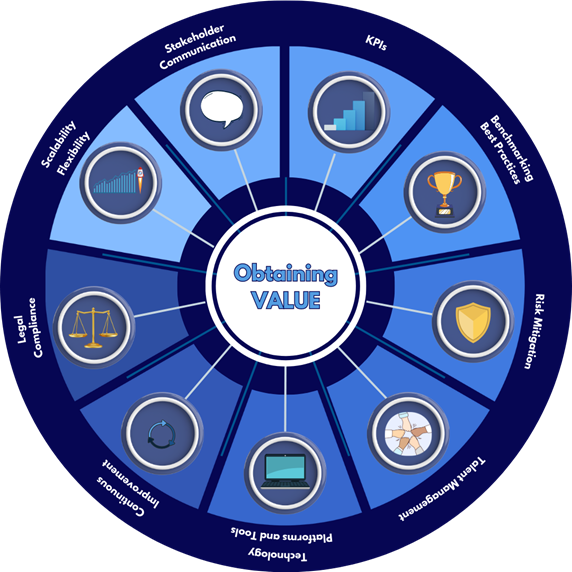
Value Identification and Alignment
Value identification and alignment are critical components of strategic sourcing in IT projects. This chapter explores the concept of value within the context of strategic sourcing, highlighting both tangible and intangible benefits. Tangible value includes cost savings, revenue growth, efficiency improvements, and return on investment (ROI). Intangible value encompasses customer satisfaction, brand reputation, innovation, and employee morale.
Understanding value is essential as it sets the stage for identifying opportunities, creating value, and measuring success. The chapter emphasizes the importance of aligning value with organizational goals to ensure sourcing activities contribute to the company’s strategic direction. This alignment involves engaging stakeholders, establishing clear metrics and key performance indicators (KPIs), and developing risk management strategies.
Understanding Value in Strategic Sourcing
Value in IT projects refers to the benefits that the organization gains from implementing technology solutions and services. These benefits can be diverse and multifaceted, impacting various aspects of the business. Value can be broadly categorized into two types: tangible and intangible.
Tangible Value:
Cost Savings: Reduction in expenses through efficient procurement processes, better negotiation, and economies of scale.
Revenue Growth: Increase sales or market share by deploying innovative technologies and improved service delivery.
Efficiency Improvements: Enhanced operational efficiencies resulting from the automation of processes, reduced manual effort, and faster turnaround times.
Return on Investment (ROI): Measurable financial returns generated from the investment in IT projects, calculated by comparing the benefits received to the costs incurred.
Intangible Value:
Customer Satisfaction: Improved customer experience and satisfaction levels due to better service delivery, user-friendly interfaces, and quicker response times.
Brand Reputation: Enhanced organizational reputation and brand value from reliable, high-quality IT services and solutions.
Innovation: Fostering a culture of innovation within the organization by implementing innovative technologies and encouraging creative problem-solving.
Employee Morale and Productivity: Increased employee satisfaction and productivity because of streamlined workflows, better tools, and a supportive work environment.
Importance of Value Alignment with Organizational Goals
For strategic sourcing initiatives to be truly effective, the value they create must align with the broader goals and objectives of the organization. This alignment ensures that the sourcing activities contribute to the company’s strategic direction and drive meaningful outcomes. Here are some key considerations:
• Strategic Fit: Ensuring that selected vendors and the solutions they provide align with the organization’s long-term strategic vision is crucial for the success of strategic sourcing initiatives. This alignment helps support business growth, market expansion, and competitive advantage, ensuring that every sourcing decision contributes to the company’s overall strategic goals.
• Stakeholder Alignment: Engaging vital organizational stakeholders to understand their priorities is essential for effective strategic sourcing. Transparent communication is critical to align expectations and build consensus on the value objectives, ensuring that sourcing initiatives meet all stakeholders’ diverse needs.
• Performance Metrics: Establishing clear metrics and KPIs that reflect the expected value from sourcing initiatives allows organizations to track and measure performance effectively. Monitoring these metrics ensures that sourcing activities deliver the desired outcomes, enabling timely adjustments and improvements.
• Risk Management: Identifying potential risks associated with sourcing initiatives and developing robust mitigation strategies is critical for protecting the value created. Organizations must consider internal risks, such as resource constraints and change management, and external risks, such as vendor reliability and market volatility, to safeguard their strategic sourcing efforts.
• Continuous Improvement: Fostering a culture of continuous improvement by regularly reviewing and refining sourcing processes is critical to enhancing future value creation. Using feedback and lessons learned from past initiatives helps organizations to adapt and improve, ensuring that their strategic sourcing remains effective and aligned with their evolving goals.
Identifying Value Opportunities
This section will explore how to identify valuable opportunities within strategic sourcing for IT projects. Recognizing these opportunities is vital for maximizing the benefits of your sourcing initiatives and ensuring they align with your organization’s strategic goals.
Market Analysis and Industry Trends
Conducting thorough market analysis and staying abreast of industry trends is crucial to identifying value opportunities. This involves understanding the current landscape, emerging technologies, and best practices within the industry.
• Current Landscape
Understanding the current landscape involves evaluating competitors’ strengths and weaknesses through Competitive Analysis and identifying Market Needs. This helps organizations recognize gaps in their strategies and develop targeted approaches to address unmet demands, enhancing their competitive position and creating value.
• Emerging Technologies
Staying updated on Innovative Solutions like artificial intelligence, machine learning, blockchain, and cloud computing is vital for maintaining a competitive edge. Monitoring Tech Trends enables organizations to leverage these technologies in their strategic sourcing initiatives, driving efficiency, cost savings, and customer satisfaction.
• Best Practices
Benchmarking against industry leaders through Industry Benchmarks provides insights into best practices. Analyzing Case Studies from successful organizations offers practical examples of effective strategies, allowing organizations to adopt proven methods and avoid common pitfalls, thereby increasing their chances of success.
Internal Needs Assessment
A comprehensive internal needs assessment helps identify gaps and opportunities within your organization that strategic sourcing can address. This involves evaluating your current capabilities, resources, and processes.
• Current Capabilities
Assessing current capabilities involves conducting a Resource Inventory to assess existing personnel, technology, and infrastructure. A Skill Assessment complements this to evaluate the skills and expertise within the organization, identifying areas where additional training or new hires might be needed to meet strategic goals.
• Process Evaluation
Workflow Analysis helps identify inefficiencies or bottlenecks in current processes that could be improved through strategic sourcing. Additionally, identifying Technology Gaps is crucial to determine which new technologies could enhance productivity and competitiveness, addressing any deficiencies that hinder organizational performance.
• Stakeholder Input
Engaging key stakeholders is essential for a comprehensive needs assessment. Engage Stakeholders by involving them in the assessment process to gather diverse perspectives and ensure all critical needs are identified. Implement Feedback Mechanisms such as surveys, interviews, and focus groups to collect detailed feedback from different departments and teams, providing a well-rounded understanding of the organization’s needs.
Identifying Gaps and Opportunities
Identifying gaps between your current state and desired outcomes is essential for pinpointing where strategic sourcing can add value. This involves a detailed analysis of your organization’s weaknesses and potential areas for growth.
• Gap Analysis
Performance Metrics involve comparing current metrics against desired benchmarks to identify gaps, including cost, efficiency, quality, and customer satisfaction. Identifying Capability Gaps highlights areas where current capabilities fail to achieve strategic goals, guiding targeted improvements.
• Opportunity Identification
Identifying opportunities involves supporting Strategic Initiatives like market expansion, customer experience enhancement, or operational efficiency increases. Assessing Innovation Potential helps pinpoint where new technologies or processes can create innovative solutions and provide a competitive edge.
• Prioritizing Opportunities
Impact Assessment evaluates the potential impact of each identified opportunity on organizational goals, prioritizing those with the highest value. Conducting a Feasibility Analysis determines the practicality of implementing each opportunity, considering cost, resource availability, and alignment with strategic objectives.
Systematic identification of value opportunities through market analysis, internal needs assessment, and gap analysis ensures that strategic sourcing initiatives are targeted and effective. This proactive approach allows organizations to leverage external resources and technologies to drive significant value and support their goals.
Market Analysis and Trends Graph for AI
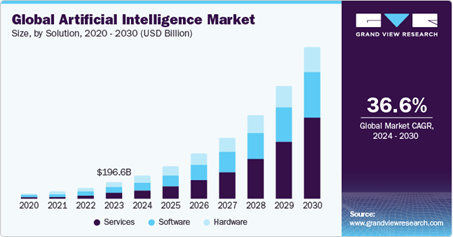
WWW.GRANDVIEWRESEARCH.COM
Failure pain points
No one starts an improvement or innovation program expecting it to fail, yet the failure rate is often high. Depending on the industry and type of innovation, failure rates for new products and services can reach 80-90%. These figures can be misleading, as they often include projects abandoned during development or those that fell short of overly optimistic expectations rather than those that reached the market and failed.
Market conditions, competition, and the level of investment and support also influence innovation failure rates. Failure is a natural part of the innovation process, with many successful innovations emerging from lessons learned from past failures. Numerous studies and analyses have estimated these failure rates, providing valuable insights into the challenges and opportunities in the innovation landscape.
Harvard Business School Study: A study conducted by Harvard Business School professor Clayton Christensen and his colleagues found that around 75% of venture-backed startups fail to return investors’ capital. This study focused on startups, but it highlights the high failure rate in the entrepreneurial space.
Product Failure Rates: Research by organizations such as Gartner and Nielsen indicate that many new product launches fail. Estimates suggest that 70% to 90% of new products fail to achieve their revenue or market share targets.
Innovation Metrics: Innovation management consulting firms like Doblin (now part of Deloitte) have developed innovation metrics and frameworks to assess innovation success and failure. These metrics often include time to market, customer adoption rates, and financial performance.
Academic Research: Academic studies in innovation management and entrepreneurship have also explored innovation failure rates. While methodologies and findings vary, these studies contribute to our understanding of innovation success and failure.
It is essential to approach these figures with some caution, as definitions of failure can vary, and failure rates can be influenced by factors such as industry, market conditions, and the stage of the innovation lifecycle. Failure is not always a definitive endpoint; it can also be a stepping stone to learning and improvement in subsequent innovation efforts.
Let us examine why innovations fail. What causes them to fail?
Incomplete or Ineffective Solution: The implemented system may need more critical features or functions to meet business objectives. Missing the objectives can result in an ineffective solution that doesn’t address the organization’s core needs. The designed system may cause further inefficiencies if it does not integrate with existing workflows. Inefficient systems will cause drops in productivity and overall business performance.
Poor Performance: A lack of performance monitoring and evaluation can lead to suboptimal vendor performance. Poor system performance may impact the quality of services or products and hinder the achievement of business goals.
Loss of Competitive Advantage: Innovation and strategic differentiation are crucial for maintaining a competitive advantage; thus, vendors who need help understanding the importance of innovation can lose that advantage.
Quality issues: The quality of the implemented solution may not meet the organization’s standards, which can lead to operational disruptions and patient dissatisfaction. Failure to satisfy regulatory or compliance requirements due to missing system features can result in legal consequences and fines.
Reliability and dependability: Vendors who fail to meet deadlines or consistently deliver late can disrupt your supply chain and production schedules, affecting your overall business operations.
• Financial challenges: Hidden Costs: Some vendors may need to be more transparent about their pricing structure, leading to unexpected costs that can strain your budget and impact profitability. Those costs could be both in the implementation and the system’s operations. The total cost of ownership needs to be better defined.
Communications: Poor Communication: Difficult communication can lead to misunderstandings, delays, and misaligned expectations, impacting project timelines and outcomes. Ineffective communication and a lack of transparency can lead to a better understanding between the business and the vendor. Communication may result in misaligned expectations, clarity, and disputes.
Data Security and Compliance: Security Risks: Choosing a vendor with weak data security measures can expose your business to potential data breaches, which can compromise sensitive information.
Scalability: Lack of Scalability: A vendor’s products or services must scale with your business growth to avoid limitations and the need for new solutions. The vendor must include scaling the software to ensure business growth expectations.
Customer support: Inadequate Support: Poor customer support from a vendor can result in unresolved issues, delays in problem resolution, and frustration for your team.
Technology misalignment: Incompatibility: Selecting a vendor whose technology or systems are incompatible with your existing infrastructure can lead to integration challenges and inefficiencies.
Cultural fit: Misalignment of Values: Differences in organizational culture and values between your company and the vendor can lead to conflicts and difficulties in collaboration.
Contractual Issues: Ambiguous Contracts: Poorly drafted or ambiguous contracts can result in legal disputes, and you may need more protection if issues arise.
Value Creation Concept
In this section, we will delve into the concept of value creation within the context of strategic sourcing for IT projects. Understanding how to create value is essential for maximizing the benefits of your sourcing initiatives and ensuring they contribute meaningfully to your organization’s success.
What is Value Creation?
Value creation in IT projects refers to generating benefits that exceed the costs of implementing technology solutions. It encompasses tangible and intangible benefits, providing a comprehensive understanding of how IT investments contribute to organizational growth and success.
Strategies for Value Creation in IT Projects
Creating value in IT projects requires strategic planning and execution. Here are key strategies to consider:
• Leveraging Advanced Technologies
Adopting emerging technologies like artificial intelligence, machine learning, blockchain, and cloud computing helps maintain a competitive edge. Ensuring seamless integration of these new technologies with existing systems enhances functionality and avoids disruptions.
• Fostering Innovation
Encouraging Experimentation creates an environment where experimentation and risk-taking are welcomed, allowing teams to test new ideas and technologies without fear of failure. Collaboration with Vendors involves working closely with vendors to co-create innovative solutions, leveraging their unique insights and capabilities for significant value.
• Enhancing Collaboration and Communication
Using Collaboration Tools involves implementing tools that facilitate communication and teamwork across departments and with external partners. Maintaining Regular Stakeholder Engagement ensures alignment and addresses concerns promptly, fostering a collaborative environment.
• Optimizing Processes
Process Automation focuses on automating repetitive and time-consuming tasks to free up resources for higher-value activities. Implementing Continuous Improvement methodologies like Lean and Six Sigma helps identify and eliminate inefficiencies, optimizing overall processes.
• Measuring and Demonstrating Value
Defining Clear Metrics involves establishing metrics and KPIs that align with organizational goals to measure the value created by IT projects. Implementing Regular Reporting ensures progress tracking and effectively communicates the generated value to stakeholders.
Measuring the Impact of Value Creation
Effective measurement of the impact of value-creation initiatives is crucial for demonstrating their success and securing ongoing support.
• Quantitative Measures: Calculate direct cost savings achieved through strategic sourcing and process optimization. Measure the increase in revenue attributable to new IT solutions and improved customer experiences. Assess productivity and operational efficiency improvements resulting from automation and other IT initiatives.
• Qualitative Measures: Gather customer feedback to gauge satisfaction and service quality improvements. Conduct surveys to understand the impact of IT initiatives on employee morale and productivity. Track the number of new ideas generated, projects initiated, and successful innovations implemented to measure innovation metrics.
• Balanced Scorecard: Utilize a balanced scorecard approach to evaluate value creation comprehensively. The financial perspective includes traditional economic metrics such as ROI, cost savings, and revenue growth. The customer perspective assesses customer satisfaction, retention, and development. The internal process perspective measures the efficiency and effectiveness of internal processes. The learning and growth perspective evaluates the organization’s innovation, improvement, and growth capacity. This multi-faceted approach ensures a holistic assessment of the value created by strategic sourcing initiatives.
image too small
Summary
This chapter explored the critical elements for successful strategic sourcing in IT projects, addressing common failure points and optimizing the process to deliver substantial value aligned with organizational goals.
In our definition of the value concept in IT projects, we underscore the benefits of understanding and aligning these values with organizational goals. This understanding is a cornerstone for effective strategic sourcing initiatives.
We examined how to identify value opportunities through market analysis, internal needs assessments, and gap analysis, allowing organizations to target their efforts effectively.
Lastly, we discussed the concept of value creation and outlined strategies to generate significant value through IT projects. Leveraging advanced technologies, fostering innovation, enhancing collaboration, optimizing processes, and measuring impact ensure that strategic sourcing initiatives contribute meaningfully to overall success.
This chapter provides a detailed framework for strategic sourcing, addressing potential pitfalls, and enhancing vendor management and project execution. It emphasizes the crucial role of proactive organizational change management, instilling confidence in one’s ability to integrate new systems and technologies. This involves stakeholder engagement, effective communication, and comprehensive training programs. Continuous performance monitoring and strict quality assurance protocols maintain high standards throughout the project’s lifecycle.
In conclusion, this structured approach significantly enhances the organization’s ability to manage and execute IT projects efficiently and strategically. It reduces risks, ensures substantial value delivery, and supports the organization’s profitability and strategic advancement. The potential for sustained success in strategic sourcing efforts is underscored, inspiring and motivating you to overcome traditional challenges and achieve this success.

Exercise
1. List Tangible Values:
• Think of a recent IT project in your organization.
• List at least three tangible values (e.g., cost savings, revenue growth, efficiency improvements) the project aimed to achieve.
2. List Intangible Values:
• List at least three intangible values (e.g., customer satisfaction, brand reputation, innovation) the project aimed to achieve.

Course Manual 2: Innovation
Staying ahead means embracing innovation and operational transformation in today’s fast-paced and competitive business environment. Businesses across all industries find that traditional methods and processes are no longer sufficient to meet the evolving demands of their markets and workforce. This chapter explores the driving forces behind the need to innovate and outlines practical steps for implementing change effectively within your organization. By understanding why innovation is crucial and how it can be strategically applied, your company can adapt to current challenges and position itself for future success and growth.
Why Drive Innovation?
Organizations innovate or add products for various reasons, but they typically do so to stay competitive, meet changing customer demands, and capitalize on emerging opportunities.
Organizations often innovate or add products to meet evolving customer preferences and needs. Understanding and addressing customer pain points can lead to developing or enhancing new products. In today’s dynamic business environment, staying ahead of competitors is crucial. Innovation allows organizations to differentiate themselves and maintain or increase market share. Introducing new products or innovative solutions can help organizations reach new customer segments or expand into new domestic and international markets.
Innovation can also drive revenue growth by introducing new products or expanding product lines, increasing revenue streams if these offerings resonate with customers and drive sales. Innovation isn’t limited to products; it can also involve process improvements or new technologies to streamline operations, reduce costs, and enhance productivity. Regulatory changes or industry standards may require organizations to innovate their products or services to comply with new requirements or seize opportunities created by regulatory shifts.
Sometimes, innovation is driven by identifying new market trends, emerging technologies, or unmet customer needs. Organizations that quickly identify and capitalize on these opportunities can gain a competitive advantage. By continually innovating and adding products, organizations can future-proof themselves against market disruptions or changes in consumer behavior. This adaptability is essential for long-term success.
Introducing innovative products can enhance the organization’s brand image, positioning it as forward-thinking, customer-focused, and technologically advanced. Being known as a creative organization can attract top talent motivated to work for a company that values creativity, problem-solving, and forward-thinking.
In summary, organizations innovate and add products to maintain relevance, competitiveness, and profitability in a constantly evolving business landscape. Often, the push for innovation starts at the top. When leadership identifies the need for change, it sets the tone for the entire organization, creating a culture that values and seeks innovation.
Innovation concerns
Innovation can bring numerous benefits to a company, but it also comes with concerns and challenges. One of the primary concerns is Resource Allocation, which involves allocating financial investment, time, and talent towards innovation efforts. Companies must balance the need to innovate with other operational priorities and ensure sufficient resources are available to support innovation initiatives without compromising core business functions.
Another primary concern is the Risk of Failure. Innovation inherently involves risk, as there are no guarantees of success. Companies may worry about investing resources into innovative projects that ultimately fail to deliver the expected outcomes, leading to financial losses and potential damage to the organization’s reputation. Additionally, Resistance to Change is a common issue. Introducing new ideas, processes, or technologies can encounter resistance from employees, stakeholders, or customers who are comfortable with the status quo. Overcoming this resistance and fostering a culture that embraces innovation can be a significant concern for companies seeking to innovate.
Lack of Market Adoption is another concern. Even if an innovative product or solution is developed successfully, it is not guaranteed to gain traction in the market. Companies may worry about whether there will be sufficient demand for their innovations and if they can effectively penetrate and capture market share. Competitive Pressures also play a role. Companies may face pressure to innovate in highly competitive industries to keep pace with competitors and maintain their market position. Concerns about falling behind rivals regarding technological advancements, product offerings, or customer experience may arise.
Protecting Intellectual Property (IP) is crucial for companies investing in innovation. They may be concerned about preventing competitors from copying or imitating their innovations. This includes securing patents, trademarks, copyrights, and trade secrets to safeguard their competitive advantage. Regulatory and Compliance Risks are also a factor. Depending on the industry and the nature of the innovation, companies may face regulatory hurdles or compliance requirements that must be addressed. Failure to navigate these challenges effectively could result in legal issues, fines, or reputational damage.
Long-term sustainability involves developing solutions that meet present needs and address future challenges and opportunities. Companies may be concerned about whether their innovation efforts align with long-term sustainability goals, including environmental, social, and governance (ESG) considerations. Return on Investment (ROI) is another critical concern. Companies must justify their investment in innovation by demonstrating a positive return on investment. Concerns may arise about whether the benefits derived from innovation initiatives, such as increased revenue, cost savings, or market differentiation, outweigh the associated costs and risks.
Finally, Organizational Culture and Structure play a significant role. Establishing a culture fostering innovation and agility can be challenging within traditional organizational structures prioritizing stability and efficiency. Companies may worry about whether their culture, leadership, and structure support or inhibit innovation. Addressing these concerns requires a strategic approach to innovation management, including precise goal setting, risk assessment, stakeholder engagement, and continuous monitoring and adaptation. By proactively addressing these concerns, companies can mitigate risks and maximize the potential benefits of their innovation efforts.
Now What?
Once an organization has determined to innovate, how can it figure out what to do?
A company determines what to innovate through market analysis, customer insights, technology assessment, and strategic planning. Here’s a breakdown of the process:
• Market Analysis: The company conducts thorough market research to understand current trends, identify emerging opportunities, and assess potential threats. This analysis involves studying industry reports, market data, and competitor strategies to gain insights into the competitive landscape and market dynamics.
• Customer Insights: Gathering customer insights through surveys, interviews, focus groups, and observational studies helps the company understand their preferences, needs, and pain points. By listening to customer feedback and observing their behavior, the company can identify areas where innovation is needed to address unmet needs or enhance customer satisfaction.
• Technology Assessment: Keeping abreast of technological advancements and evaluating their potential impact on the industry is crucial for identifying opportunities for innovation. This involves monitoring developments in relevant fields, such as artificial intelligence, biotechnology, or materials science, and assessing how new technologies can be leveraged to create value for customers and the business.
• Strategic Planning: Integrating innovation into the company’s strategic planning process ensures alignment between innovation efforts and business objectives. The company defines clear goals and priorities for innovation, considering growth targets, competitive positioning, and market expansion strategies.
• Risk Management: Innovation involves inherent uncertainty and risk, so the company assesses the risks associated with potential innovations and develops strategies to mitigate them. This may include conducting feasibility studies, testing prototypes, or engaging in partnerships or collaborations to share risks and resources.
• Organizational Capabilities: The company evaluates its internal capabilities, including R&D expertise, technological infrastructure, and talent pool, to determine its innovation capacity. This assessment helps identify areas where additional investments or resources may be needed to support innovation initiatives effectively.
• Cross-functional Collaboration: Innovation often requires collaboration across different organizational departments and functions. By fostering a culture of collaboration and teamwork, the company can leverage diverse perspectives and expertise to generate innovative ideas and bring them to fruition.
• Industry Best Practices Demand It: Adopting the latest best practices becomes essential for competitive advantage and survival as industries evolve. Organizations that align their operations with these practices are better positioned to meet market expectations and excel. Industry KPIs can signal areas where improvements are necessary. When KPIs show declining performance or missed targets, it’s a clear indication that innovation could be required to enhance processes and outcomes.
• Inspirational Case Studies: Many organizations within the industry have successfully transformed their operations through innovation. These case studies serve as a motivational tool, showing the benefits of embracing change and the strategies that led to success.
• Availability of Advanced Tools: Technological advancements, especially artificial intelligence (AI), have drastically created new tools to enhance productivity and decision-making. These tools make it feasible to automate processes, analyze vast amounts of data, and optimize operations.
• The Imperative of LEAN and waste reduction: In a business context, continuous improvement is necessary to enhance product quality, reduce waste, lower costs, and improve customer satisfaction. Innovating processes and technologies are central to continuous improvement strategies.
• Legal and Compliance Demands: Regulatory changes often require new systems and processes to ensure compliance. Innovation can help organizations swiftly adapt to these legal demands, minimize risk, and align with industry standards.
By systematically analyzing market trends, customer needs, technological developments, and internal capabilities, the company can identify opportunities for innovation that align with its strategic objectives and maximize its chances of success.
Organizing this (embedded or separate)
Several factors influence the decision to integrate an innovative program into an existing entity or establish it as a brand-new venture.
• Alignment with Core Business: Evaluate whether the innovative program aligns closely with the existing entity’s core mission, values, and strategic goals. If the program complements the current business activities and can leverage existing resources, infrastructure, and expertise, integrating it into the entity may be the most practical approach.
• Resource Availability: Consider the resources required to launch and sustain the innovative program. If the program demands significant investment in capital, human resources, technology, and time, establishing it as a separate venture might be preferable to avoid diluting resources or attention from the core business.
• Risk Tolerance: Assess the organization’s and stakeholders’ risk tolerance. Innovative programs often entail uncertainty and may involve experimentation and trial-and-error processes. If the organization is risk-averse or if failure could negatively impact the existing business, launching the program as a separate venture could provide greater autonomy and mitigate risk.
• Market Differentiation: Determine whether the innovative program offers a unique value proposition that could differentiate it in the market. If the program targets a distinct customer segment or addresses an unmet need different from the existing business, establishing it as a standalone venture may allow for more focused branding and market positioning.
• Speed of Execution: Consider the urgency and speed at which the innovative program needs to be developed and scaled. Launching it as a separate venture may enable faster decision-making, agility, and flexibility than navigating internal processes and structures within the existing entity.
• Synergies and Dependencies: Evaluate potential synergies or dependencies between the innovative program and the existing business operations. If synergies can be leveraged to create value or the program’s success depends on close integration with existing products or services, integrating it into the entity may be more effective.
• Organizational Culture: Assess whether the organization’s culture and structure support innovation and entrepreneurship. If there is a culture of experimentation, openness to new ideas, and a willingness to embrace change, integrating the program into the existing entity while fostering an innovation-friendly environment could be beneficial.
• Long-Term Strategy: Consider the long-term strategic implications of both options. Evaluate how the decision will impact the innovative program’s scalability, sustainability, potential for future growth, and alignment with the organization’s overall vision and trajectory.
By carefully weighing these factors and conducting a thorough analysis, you can determine whether integrating the innovative program into the existing entity or establishing it as a brand-new venture is the most appropriate course of action.
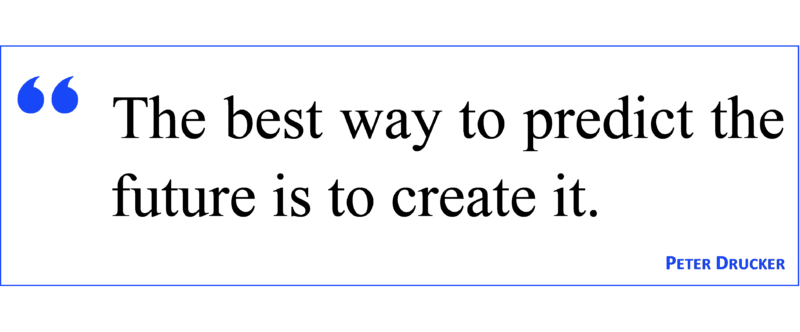
Innovate?
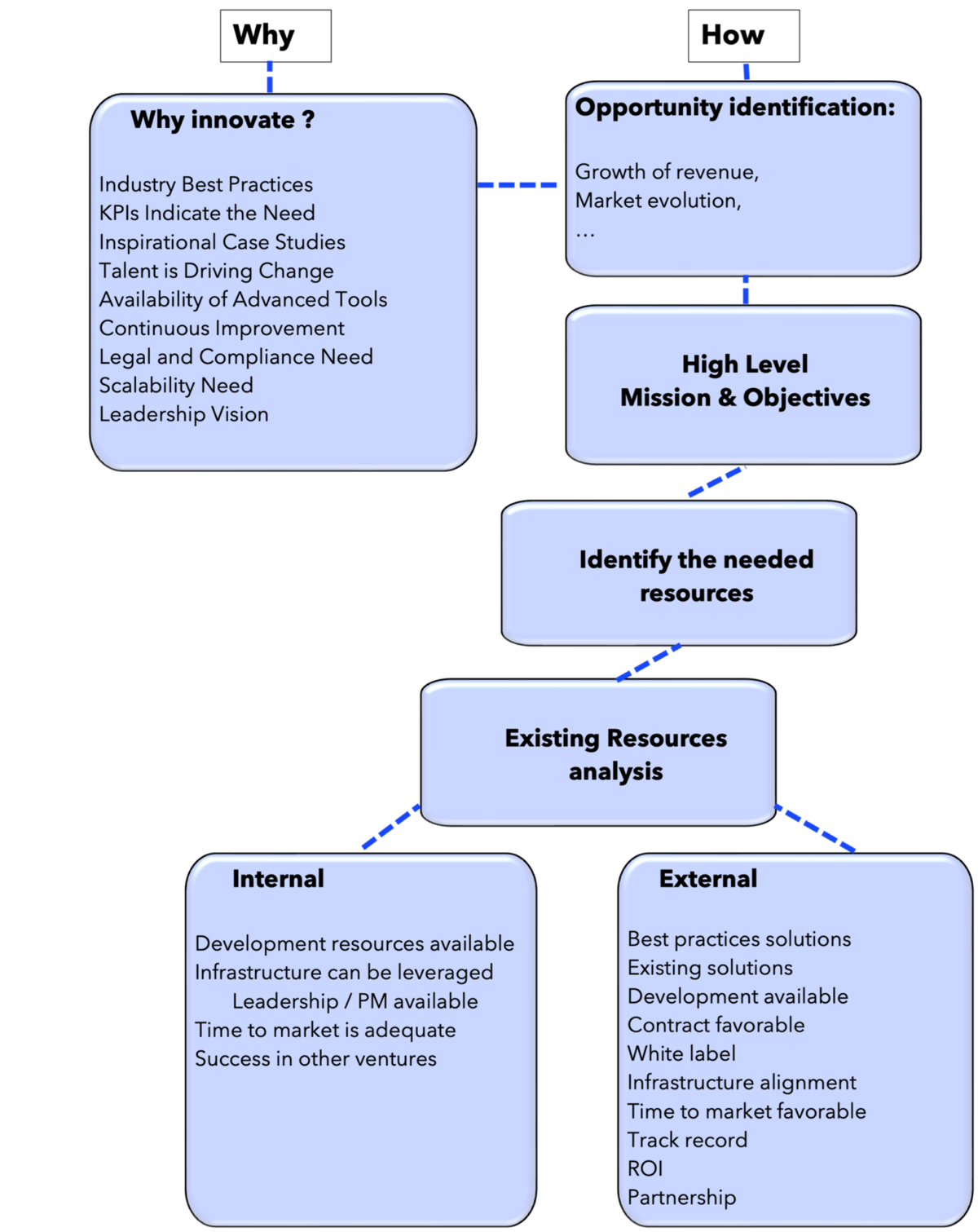

Case Study: Microsoft PowerBI
Magic Quadrant for Analytics and Business Intelligence Platforms
By Gartner
Data and analytics leaders must use analytics and BI platforms to support the needs of IT, analysts, consumers, and data scientists. While integration with cloud ecosystems and business applications is a crucial selection requirement, buyers also need platforms to support openness and interoperability.
Market Definition/Description
Analytics and business intelligence (ABI) platforms enable less technical users, including businesspeople, to model, analyze, explore, share, and manage data and collaborate and share findings. These platforms are enabled by IT and augmented by artificial intelligence (AI).
For several years, the Gartner Magic Quadrant for Analytic and Business Intelligence Platforms has emphasized visual self-service for end users augmented by AI to deliver automated insights. While this remains a significant use case, the ABI platform market will increasingly need to focus on the needs of the analytic content consumer and business decision-makers. To achieve this, automated insights must be relevant to a user’s goals, actions, and workflow.
For years, Tableau (now purchased by Salesforce) was the innovative tool that most companies used to build analytic displays. However, as the market developed, others became interested in displaying analytics. This year, demonstrating the market’s development, Gartner added critical capabilities to their evaluation criteria: collaboration and data science integration. These new capabilities depict some fundamental changes buyers expect their ABI platform vendors to deliver.
Innovation became the key in analytics and business intelligent displays. Customers’ demand for more data analytics and data displays increased dramatically.
Questions: Did Microsoft have or acquire internal talent to build a new tool? Was there a market for it? Would this be an addition to the existing tools? The answers to all those questions were yes! Consequently, Microsoft built PowerBI to leverage AI functionality and expand its Excel analytic platform. That investment was popular, and as seen in this chart, the tool is now seen as both a visionary product and a leader in execution. What a change for Tableau.
Magic Quadrant
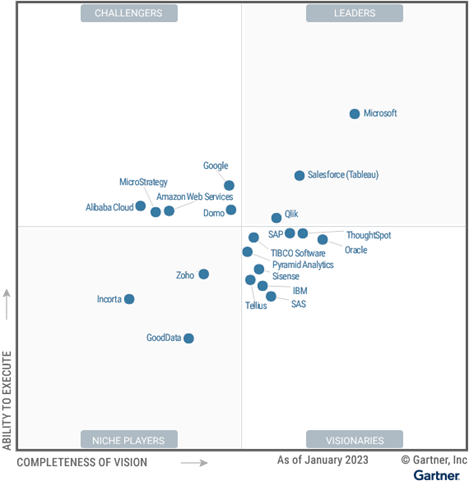
Figure 1: Magic Quadrant for Analytics and Business Intelligence Platforms

Exercise: OLDco

Course Manual 3: Definitions
A common understanding of terms or definitions is essential for effective communication, collaboration, and decision-making in business. Here are several reasons why it’s important:
• Clarity: Consistent definitions ensure clarity in communication by providing a shared language that everyone understands. When terms have well-defined meanings, there is less room for confusion or misinterpretation, leading to more effective communication and fewer misunderstandings.
• Alignment: Common definitions help ensure alignment and shared understanding among individuals or groups working together towards common goals. When everyone uses the same terminology and understands its meaning, it facilitates collaboration and promotes unity of purpose.
• Precision: Clear definitions enable precision in communication by specifying the exact meaning of terms. This precision is essential in technical or specialized fields where accuracy and specificity are critical for conveying complex concepts or instructions.
• Problem-solving: When discussing complex issues or solving problems collaboratively, having a shared understanding of terms allows individuals to focus on the substance of the discussion rather than debating semantics. It streamlines identifying and addressing issues by providing a standard frame of reference.
• Consistency: Common definitions promote consistency in decision-making and actions across different contexts or situations. When everyone interprets terms similarly, it helps ensure that policies, procedures, and standards are applied consistently, reducing ambiguity and promoting fairness.
• Learning and Development: Clear definitions facilitate learning and skill development by providing a foundation of shared knowledge. Learners who understand the meanings of terms can more easily grasp new concepts, build on existing knowledge, and apply their learning effectively.
• Interdisciplinary Collaboration: Standard definitions are crucial for facilitating collaboration and integrating diverse perspectives in interdisciplinary fields. They bridge gaps between disciplines and promote effective communication and understanding. The terms used in this workshop are defined to ensure clarity, alignment, precision, and consistency, fostering effective learning and problem-solving across various contexts.
Strategic sourcing
Strategic sourcing is a comprehensive procurement and supply chain management approach that continuously re-evaluates and re-negotiates a company’s purchasing activities. It encompasses analyzing the organization’s spending and needs, researching potential suppliers, and developing long-term relationships with vendors to improve value and gain competitive advantage. This methodology involves considering cost reduction, quality improvement, risk management, and innovation to align the purchasing strategy with the overall business goals. Strategic sourcing aims to save money, strengthen service and product quality, minimize risks, and optimize supplier performance.
Best practices
Best practices are the most efficient and effective methods of performing a task or process, widely recognized and accepted within an industry or field. These practices are often established through experience and research and are considered the standard against which performance is measured. Adopting best practices is intended to increase an organization’s quality, productivity, and performance while minimizing errors and inefficiencies. They are typically developed over time by identifying the techniques that consistently yield superior results and can be shared and implemented across different organizations or projects to achieve desired outcomes.
When identifying best practices and understanding the solutions for a given need, several reputable tools and sources can guide your decision-making. Industry analysts like Gartner and Forrester provide comprehensive research reports and insights to help you assess the latest technologies, strategies, and market trends. Engaging with industrial leaders and leveraging their experiences can offer practical perspectives and proven strategies aligning with current industry standards. Benchmarking against top performers in your sector can reveal critical practices that might be adopted or adapted to enhance your operations. Lastly, cultivating deep market knowledge through ongoing research, attending industry conferences, and networking with peers is crucial. It enables an up-to-date understanding of the dynamic market landscape, ensuring current data and trends inform your strategies.
Continuous improvement
Continuous improvement is an ongoing effort to enhance products, services, or processes. This approach involves regularly examining workflows, identifying areas that can be made more efficient or effective, and implementing improvement solutions. The goal is to maintain and elevate quality and service standards by constantly seeking ways to reduce waste, streamline operations, increase customer satisfaction, and improve overall performance. Continuous improvement fosters a culture of innovation and constant learning within an organization.
Risk
Risk refers to the possibility of experiencing loss or an unfavorable outcome due to internal or external vulnerabilities and the impact these could have on achieving business objectives. It encompasses various potential events, including financial uncertainties, legal liabilities, management errors, accidents, natural disasters, and deliberate attacks from adversaries.
Two main components typically characterize risk. The first is probability, which refers to the likelihood of a specific event occurring within a given time frame. The second is impact, which concerns the potential consequences or effects of the event if it does happen. Together, these components help assess and prioritize risks, enabling organizations to develop strategies to mitigate and manage them effectively.
Risk management,
Risk management involves systematically identifying, assessing, and prioritizing an organization’s risks. It is a critical component of organizational strategy and decision-making.
Identifying Risks is the initial step in identifying potential threats that could negatively impact the organization’s assets or operations. This process involves recognizing all potential hazards across various facets of the organization, from financial uncertainties to strategic management errors, operational risks, and external threats.
Risk Assessment follows the identification process. Once risks are identified, they are evaluated to determine their magnitude and likelihood. This assessment helps understand each risk’s potential impact, thereby aiding in prioritizing which risks need immediate attention based on their severity and probability of occurrence.
Risk Prioritization involves ranking risks based on their potential impact and the likelihood of occurrence. This step ensures that resources are allocated appropriately and that effective risk management is in place. Prioritization helps organizations focus on the most critical risks that could have the most substantial negative impact.
Following these steps, risk management requires coordinated efforts to:
• Minimize Risks: Implement measures to reduce risks’ likelihood or impact. This could involve developing strategies to lower vulnerability or enhancing security protocols to prevent potential threats.
• Monitor Risks: Continuously observe and track risk factors and their evolution. Monitoring ensures that the organization remains aware of new and developing risks and the effectiveness of measures to mitigate them.
• Control Risks: Taking actions to mitigate the effects of risks should they materialize. This includes implementing contingency plans, utilizing insurance policies, and conducting regular audits and compliance checks.
Overall, risk management enables organizations to prepare for and respond to risks effectively and recover from disruptions quickly, ensuring stability and sustained operational success. Effective risk management is crucial because it helps maintain the organization’s reputation, ensures compliance with laws and regulations, protects against financial loss, and supports its long-term strategies and objectives.
Scalability
Scalability refers to a company’s capability to increase its production or sales capacity to meet an expected increase in demand without compromising the cost efficiency or quality of its products or services.
Operational scalability involves a company’s ability to maintain or improve profit margins as sales volume increases. This is achieved through efficient resource management, process automation, and infrastructure improvements that support more extensive operations.
Technical scalability is crucial for businesses that rely on technology or digital platforms. It refers to the capacity of technical systems to expand and support increased operational or customer demands, which might involve adding new servers, enhancing data handling capabilities, or upgrading software and hardware.
Strategic scalability focuses on a company’s ability to adapt its strategies to accommodate growth. This includes entering new markets, diversifying product lines, and effectively scaling up marketing and sales efforts.
Scalability is essential because it sets the stage for a business’s growth and expansion capabilities. Scalable businesses can often exploit economies of scale, reduce per-unit costs, and improve profitability as they grow.
COTS (Commercial Off-The-Shelf)
COTS refers to commercially available products or solutions ready-made and available for immediate use. Unlike custom-made software or systems developed specifically for a single customer, COTS products are designed to be sold to a broad market with minimal customization.
Critical aspects of COTS include:
• Availability: COTS products are readily available for purchase and implementation. They are mass-produced and can be acquired off the shelf without lengthy development processes.
• Standardization: These products are standardized for general use across various industries rather than tailored to specific business needs. Standardization helps reduce costs and shorten the implementation timeline.
• Lower Cost: Typically, COTS solutions are less expensive in the short term compared to custom-developed software. This cost-effectiveness comes from the vendor spreading development costs across multiple buyers.
• Compatibility: COTS products are designed to be compatible with existing systems and software, facilitating integration and interoperability within various IT environments.
• Support and Maintenance: Since multiple organizations use COTS products, vendors usually offer ongoing support and regular updates. This ensures that the product remains functional and secure as technologies evolve.
The significance of COTS lies in enabling organizations to leverage existing technologies without extensive investments in custom solutions. This accelerates deployment and allows businesses to benefit from advanced technologies maintained by established providers. COTS solutions are precious when the solution needs are met daily across organizations and when a vendor better manages obsolescence and support risks.
ROI
Return on Investment (ROI) is a performance measure used to evaluate the efficiency or profitability of an investment or compare the efficiency of several different investments. ROI tries to directly measure the return on a particular investment relative to its cost.
An investment’s benefit (or return) is divided by its cost to calculate ROI. The result is expressed as a percentage or a ratio. The ROI formula is:

Where:
• Net Profit: gain from the investment minus the cost of the investment
• Cost of Investment: total amount invested in generating profit.
It helps investors and managers assess whether to proceed with a particular investment or choose several alternatives.
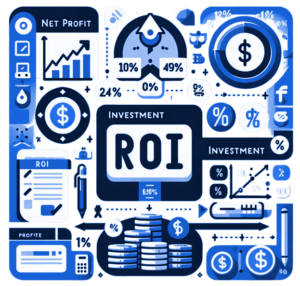
Key Performance Indicators (KPIs)
KPIs focus on the aspects of organizational performance most critical to the organization’s current and future success.
They can measure progress toward strategic goals, operational improvements, customer satisfaction, financial performance, and other business areas.
• Relevant: A good KPI must align with the organization’s strategic goals and objectives. It should be pertinent to the business area intended to measure and directly linked to manageable influencing factors.
• Actionable: It should provide insights that can lead to actions impacting the outcome. A KPI should be a measure and a driver for decisions and actions to help achieve strategic goals.
• Measurable: The KPI must be quantifiable. It should have a clear, numeric outcome that can be measured consistently over time.
• Specific: Good KPIs are well-defined and precise, leaving no room for ambiguity in how they are interpreted or measured. They provide a clear definition of what is measured and how.
• Time-bound: They should be measured within a specific time frame (daily, weekly, monthly, quarterly, annually). This helps track performance and evaluate strategies’ effectiveness over defined periods.
• Understandable: The organization should understand the KPI, including how and why it is measured. This clarity helps ensure all team members know what to aim for and why it matters.
• Comparable: Good KPIs allow for comparing different periods, departments, or locations. This comparison can help benchmark performance and set performance standards.
• Achievable: While KPIs should be challenging and aim to drive performance improvements, they must also be realistically achievable. Unrealistic KPIs can demotivate teams and lead to disillusionment with the measurement process.
• Adjustable: As strategies and goals evolve, so should the KPIs. A good KPI should be flexible to adapt to changes in the organization’s business environment or strategic direction.
Opportunity or challenge
The term “opportunity or challenge” refers to the specific objectives or goals that an organization aims to achieve by capitalizing on a particular opportunity. It represents the rationale behind pursuing the opportunity and outlines the intended outcomes that the organization expects to derive from it. The purpose can vary widely depending on the nature of the opportunity and the organization’s strategic needs.
One common objective is Growth, which involves expanding business operations, entering new markets, or increasing market share. Organizations pursue growth to enhance their market presence and achieve incredible financial performance.
Innovation is another key objective, focusing on developing new products or services or improving existing ones. Innovation helps organizations stay competitive and meet evolving customer needs, ensuring long-term success and market relevance.
Efficiency aims to enhance operational processes to reduce costs and improve productivity. Organizations can increase profitability and sustain competitive advantage by streamlining operations and eliminating inefficiencies.
Risk Management involves mitigating potential risks that could negatively impact the business. Proactively identifying and managing risks helps ensure business continuity and protects organizational assets and reputation.
Competitive Advantage seeks to gain an edge by leveraging unique resources or capabilities. This can include proprietary technologies, superior customer service, or strategic partnerships that set the organization apart in the marketplace.
Identifying the purpose behind pursuing an opportunity helps businesses focus their resources and efforts on the most promising opportunities. It ensures that their strategic actions align with their broader business goals, facilitating more effective decision-making and resource allocation. By clearly defining the objectives, organizations can better navigate challenges and capitalize on opportunities that drive success and growth.
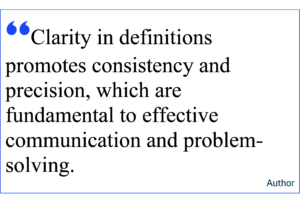
Summary
This chapter has established the importance of having a shared understanding of key terms within strategic sourcing. We have laid a foundation for effective communication and decision-making across the organization by providing precise and consistent definitions. As we continue through the workshop series, these definitions will serve as a crucial reference that enhances clarity, ensures alignment, and supports the precision required in our discussions and activities. Each term has been chosen for its relevance and impact on fostering a cohesive learning environment and optimizing our strategic sourcing processes.
Moving forward, these definitions will underpin our exploration of more complex concepts, ensuring that all participants have the knowledge to engage deeply with the material presented in subsequent workshops. As we progress through the series, remember that these terms are tools to help us build a robust strategic sourcing framework that aligns with our overarching business goals.

Case Study: Geisinger Health System
Geisinger is in Mid Pennsylvania. It is a physician-owned and operated entity with a health plan providing health insurance for about 400,000 people. 22% of the people in the health plan are seniors with chronic illnesses. This population leads to a significant percentage of people who are either being seen in the emergency room or admitted to the hospital due to not managing their chronic illnesses (like diabetes or congestive heart failure). Geisinger has a good history of providing seniors with care management assistance, provided by nurses, often in person during or in conjunction with primary care visits. However, as the senior population grows, the traditional way of providing care management with RNs providing coaching and support will never scale to meet the growing demand. Two things are necessary: 1. Do a better job identifying people at risk of ER visits and admissions, and 2. An organized way of managing those patients with less skilled nurses (or supported with a system) to help them meet the needs of these patients.
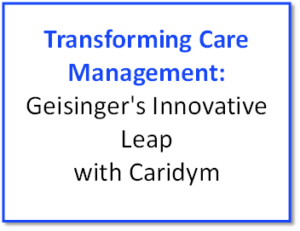
With a mere 2% reduction in senior admissions, a proposal to develop a robust care management system was quickly promoted and sold to the board of directors.
As a result, the system developed a revolutionary/cutting-edge system called Caridym, which prioritized the patients’ care and helped nurses coach patients into a better health status (thus avoiding hospitalizations). It was envisioned to take 18 months to build that system. Data from many other systems had to be integrated, including claims data and electronic medical records. Still, it could not be built by the people in the system. The skills needed differed from those required by the skilled people in the system (e.g., creating a sophisticated data model and normalizing data with industry standards), while others in the system were already fully occupied (this being a long-term initiative).
The system must integrate with existing architecture and systems to use and leverage the existing data. In addition, additional data from other organizations (e.g., health information exchange (HIE) data) was to be added.
One of the first steps in this program was to contact Forrester and Gartner to investigate the best practices of Care Management. Each had a person who was following care management development across the country. Those organizations provided best-practice research. Both also indicated what the development process that these existing systems were focused on was. Coupled with this research, we investigated some of the innovative vendors for our program. Without this step, Geisinger may have built a less forward-thinking and less robust tool.
In this case, Geisinger used several of the tools available to it, including all the provided definitions.

Exercise: OLDco

Course Manual 4: Can We Do This Internally?
Internal considerations
Organizations determine whether to build a product internally or externally by considering various factors and conducting a comprehensive evaluation. Here’s a breakdown of the process:
• Core Competencies: The organization assesses whether product development aligns with its core competencies and strategic objectives. If the product is closely related to the organization’s expertise and capabilities, building it internally may be preferred to maintain control and leverage existing strengths.
• Resource Availability: The organization evaluates its internal resources, including talent, technology, and infrastructure, to determine whether it can develop and support the product successfully internally. This assessment considers factors such as the availability of skilled personnel, access to relevant technology, and the organization’s R&D capabilities.
• Cost Analysis: A thorough cost-benefit analysis compares the expenses associated with building the product internally versus sourcing it externally. This analysis includes the direct costs of development and indirect costs such as time-to-market, opportunity costs, and ongoing maintenance and support expenses.
• Time-to-Market: The organization assesses the urgency of bringing the product to market and the time required to develop it internally. If speed is crucial and developing the product internally would take too long, sourcing it externally may be a more viable option to meet immediate needs.
• Risk Management: Both options are considered. Building the product internally carries risks such as project delays, cost overruns, and technical challenges. On the other hand, sourcing it externally may involve risks related to vendor reliability, integration issues, and dependence on external suppliers.
• Scalability and Flexibility: The organization evaluates whether it needs a solution that can scale rapidly or adapt to changing business needs. Building internally may offer greater flexibility and customization options, while sourcing externally may provide a faster and more scalable solution.
• Regulatory and Compliance Requirements: Compliance with industry regulations and standards is assessed to ensure that the chosen option meets all legal and regulatory requirements. This is particularly important in highly regulated healthcare, finance, and aerospace industries.
• Strategic Partnerships and Alliances: Sometimes, organizations opt for a hybrid approach by forming strategic partnerships or alliances with external vendors or startups to co-develop or co-innovate solutions. This allows them to leverage external expertise while retaining some control and integration with their internal operations.
Inhouse development
Your organization can certainly develop a new product or innovation internally. This approach, known as ‘in-house’ product development, offers several benefits. It allows for greater control over the process, fosters innovation within the company, and can lead to significant cost savings. Here’s an overview of the process:
Idea Generation: The exciting journey typically begins with a burst of creative energy, generating ideas for new products. These can spring from various sources, such as market research, customer feedback, brainstorming sessions, or employee insights.
Concept Development: Once an idea is identified, the organization evaluates its feasibility and potential market demand. This involves conducting market research, analyzing competitors, and assessing the proposed product’s technical and financial feasibility.
Design and Prototyping: After validating the concept, the organization moves into the design phase, where detailed specifications for the product are developed. This includes creating prototypes or mock-ups to test the product’s functionality, usability, and design.
Testing and Iteration: The prototype undergoes testing to identify any flaws or areas for improvement. Feedback from testing is used to refine the product design and make iterative improvements until it meets the desired quality standards and user requirements.
Production: Once the product design is finalized, the organization moves into the manufacturing and production phase. This involves setting up production processes, sourcing materials, and manufacturing the product at scale.
Marketing and Launch: Parallel to manufacturing, the organization develops a marketing strategy to promote the new product. This strategy includes branding, pricing, distribution, and promotional activities to generate awareness and drive demand.
Sales and Distribution: The product is launched and made available to customers through various distribution channels. Sales teams may pitch the product to potential customers and close deals.
Post-launch Evaluation: After launching the product, the organization monitors its market performance and collects customer feedback. This information assesses the product’s success and identifies further improvement or expansion opportunities.
Of the above components, we focus on items 2, 3, 4, and 5 in this workshop as these are the technology-focused items. Building a new product or innovation internally requires creativity, technical expertise, market knowledge, and project management skills. While it can be complex and resource-intensive, it offers the advantage of maintaining complete control over the development process and intellectual property rights. A thorough internal evaluation is crucial to integrating a proposed system within an existing organizational architecture. This evaluation will ensure the system fits seamlessly within the current infrastructure and optimally utilizes organizational resources. Here’s a detailed breakdown focusing on both building within the current organization and leveraging its existing strengths:
Resources to be investigated.
System Architecture
• Scalability: Ensure the architecture is scalable to accommodate future growth without significant redesigns or cost implications.
• Interoperability: Design the system to interact seamlessly with existing and potential future systems. Use standard data formats and open APIs where possible.
• Resilience: Build redundancy and fault tolerance into the system to maintain operation during unexpected failures.
• Security: Embed robust security protocols into the architecture, including data encryption, secure access mechanisms, and regular security audits.
• Maintenance and Support: Plan for ongoing maintenance and support of the new system, including setting up helpdesk services, regular updates, and system optimization strategies.
Financial Investment:
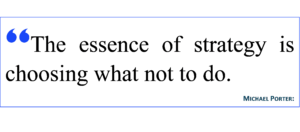 How much will this process cost? Some of the measures that need to be evaluated are provided in the chart. How much of the budget must be allocated for software development, system integration, and initial testing phases? This includes procurement of software licenses, third-party services, and potential contingency funds. As seen previously, establishing clear and measurable objectives is essential. These objectives will be directly informed and defined by specific Key Performance Indicators (KPIs), ensuring that each goal is quantifiable, aligned with the organization’s strategic aims, and achievable.
How much will this process cost? Some of the measures that need to be evaluated are provided in the chart. How much of the budget must be allocated for software development, system integration, and initial testing phases? This includes procurement of software licenses, third-party services, and potential contingency funds. As seen previously, establishing clear and measurable objectives is essential. These objectives will be directly informed and defined by specific Key Performance Indicators (KPIs), ensuring that each goal is quantifiable, aligned with the organization’s strategic aims, and achievable.
To ensure these objectives are met, each KPI must be rigorously monitored through a comprehensive dashboard that integrates real-time data from the system. Regular assessments will compare performance against these critical metrics, with findings reviewed in strategic meetings. Adjustments will be made to the system’s operations to align performance with set objectives, ensuring the system integrates seamlessly and contributes positively to the organization’s goals.
This approach ensures that the mission and objectives are aligned with the organization’s strategic needs and clearly defined and measurable, enabling effective management and optimization of the new system’s integration and performance.
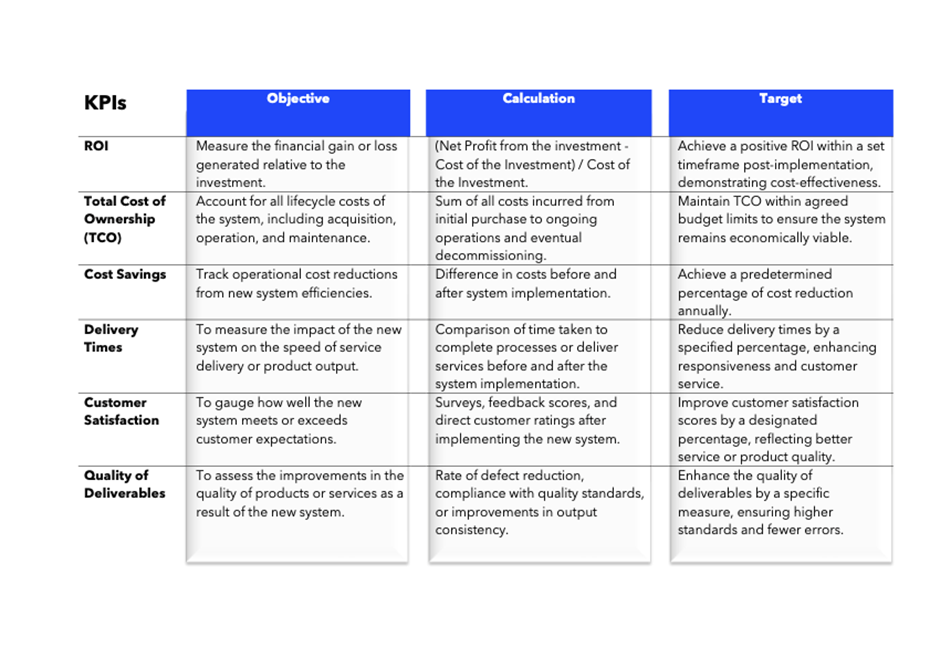
Technological Assets
Can this approach leverage the existing technology platform? Identify what additional resources will be needed, such as servers robust enough to handle increased loads, upgraded networking equipment to ensure data flow efficiency, and secure development tools that align with the latest industry standards.
• Existing IT Infrastructure: Utilize available IT resources such as data centers, cloud environments, and existing application platforms to support the deployment of the new system.
• Organizational Data Access: Secure access to necessary databases, CRM systems, and other critical data repositories for system integration and function.
• Communication Networks: Leverage existing communication and collaboration tools to facilitate project management and team collaboration.
• Operational Impact: Address the implications of reallocating current staff from their usual duties to support the new initiative, ensuring minimal disruption to regular operations.
• Physical Infrastructure: Assess the need for physical space adjustments, such as additional server rooms or enhanced security facilities for hardware.
• Software Development Expertise: Recruit or train developers skilled in relevant programming languages and frameworks critical to the project. This might include specific software languages and knowledge of your development platform and processes.
• Project Management: Ensure experienced project managers who understand complex systems integration and can handle cross-functional team coordination are on board.
• Systems Integration Specialists: Deploy experts in integrating new technological solutions with existing systems, ensuring seamless functionality and interoperability.
• Security Analysts: This group includes cybersecurity experts who protect new and existing systems, ensuring data integrity and compliance with regulatory standards.
• Data Analysis and Management: Employ or develop talent in data science and analytics to manage large datasets, perform quality checks, and optimize data usage for decision-making.
• Training and Development: Implement comprehensive training programs to help existing staff understand and adapt to new technologies and processes. Focus on reducing the learning curve associated with new system operations.
• Change Management Professionals: Engage specialists who can manage the organizational changes that come with system integration, helping minimize disruption and enhancing acceptance among the workforce.
Focusing on these detailed elements can improve efficiency, integrate the new system into the existing architecture, maximize resource efficiency, and minimize operational disruption.
By systematically evaluating these factors and aligning the decision with the organization’s strategic goals, resources, and risk tolerance, the organization can determine whether to build the product internally or externally. This is often a complex decision that requires input from multiple stakeholders across the organization.
The decision between internal building and external sourcing depends on various factors and can vary greatly depending on the specific circumstances of each organization and project. There is no one-size-fits-all answer, and the decision often involves carefully weighing multiple considerations.
Organizations may sometimes determine that building the product internally aligns better with their core competencies, strategic objectives, and resource availability. This might be the case when the product is closely related to the organization’s expertise and has the necessary talent, technology, and infrastructure to develop it internally. Factors such as the urgency of bringing the product to market, the need for customization or control, and the long-term strategic value may influence the decision to build internally.
On the other hand, there are scenarios where organizations opt for external sourcing, such as when the required expertise or resources are not available internally or when speed-to-market is critical and developing the product internally would take too long. External sourcing may also be preferred when the organization seeks to mitigate risks associated with internal development, such as cost overruns, technical challenges, or regulatory compliance.
Ultimately, the decision between internal build and external sourcing depends on a thorough analysis of core competencies, resource availability, cost, time-to-market, risk management, scalability, and regulatory compliance. It’s not uncommon for organizations to use a combination of both approaches, leveraging internal capabilities for some projects while sourcing externally for others, depending on each initiative’s specific requirements and objectives.
Risk with external.
Using external resources for a project carries certain risks; if the project fails, these risks can have significant consequences for the organization. Here are some potential risks associated with relying on external resources:
• Dependency on External Partners: By outsourcing parts of a project or relying on external vendors, the organization becomes dependent on the performance and reliability of those partners. If the external resources fail to deliver as expected, it can lead to delays, cost overruns, and project disruptions.
• Loss of Control: Outsourcing certain aspects of a project may result in losing control over critical functions or processes. The organization may have limited visibility or influence over the actions of external vendors, making it challenging to ensure that the project is executed according to the organization’s standards and requirements.
• Quality and Performance Concerns: External resources may not meet the organization’s quality standards or performance expectations. This can lead to subpar deliverables, rework, and stakeholder dissatisfaction, ultimately impacting the project’s success.
• Communication and Coordination Challenges: Working with external resources introduces communication and coordination challenges, mainly if there are cultural or language differences, time zone discrepancies, or ineffective communication channels. Poor communication can result in misunderstandings, delays, and misalignment between the organization and external partners.
• Intellectual Property and Confidentiality Risks: Sharing sensitive information or proprietary knowledge with external vendors may pose intellectual property and confidentiality risks. Without adequate safeguards in place, there is a possibility of data breaches, leaks, or unauthorized use of intellectual property, which can have legal and reputational consequences for the organization.
• Contractual and Legal Risks: The contract terms between the organization and external vendors may not adequately protect the organization’s interests or provide recourse in case of project failure. Disputes over contractual obligations, scope changes, or performance issues can lead to both parties’ legal challenges and financial liabilities.
• Financial Implications: Outsourcing projects to external resources typically involve financial commitments and expenses, including vendor fees, contract negotiations, and project management costs. If the project fails, the organization may incur financial losses associated with sunk costs, termination fees, or additional expenses to rectify the situation.
• Reputation Damage: Project failure can negatively impact the organization’s reputation and credibility, particularly if it becomes public knowledge or affects stakeholders’ trust in its ability to deliver on its commitments. This can impact future business opportunities and relationships with customers, partners, and investors.
To mitigate these risks, organizations should conduct thorough due diligence when selecting external resources, establish clear expectations and agreements through contracts and service level agreements, maintain open communication channels, and actively manage the relationship with external partners throughout the project lifecycle. Additionally, having contingency plans and risk mitigation strategies in place can help minimize the impact of project failure if it occurs.
Summary
The decision between internal development and external sourcing involves complex considerations, including managing risks, leveraging core competencies, and optimizing time to market. Organizations often turn to external solutions for specialized expertise and scalability. This workshop is tailored for these organizations, emphasizing evaluating external resources to enhance internal capabilities. It provides a structured approach to navigating outsourcing complexities, focusing on technological integration and strategic partnerships.
Participants will gain insights into strategic sourcing and vendor management, enabling informed decision-making aligned with strategic goals and maximizing outsourcing benefits. This workshop equips organizations with the tools and knowledge necessary to manage outsourcing challenges effectively, highlighting its role in boosting productivity and innovation.
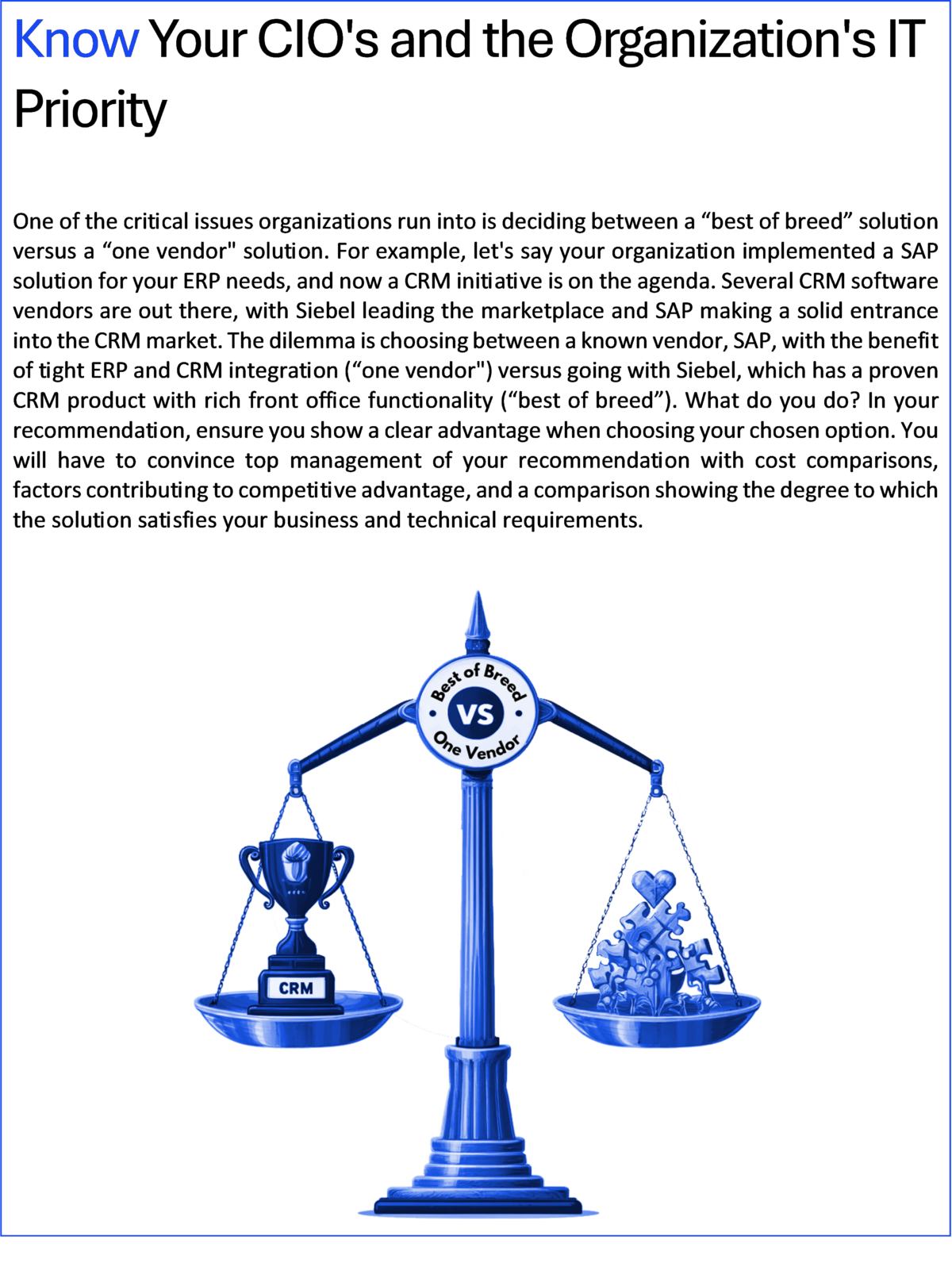

Case Study: Prior Authorization Process, Failures
There are some procedures that a patient might need to treat a disease that, because of expense, must be approved by a health insurance company in advance of that procedure. That process is called prior authorization. The number of procedures that must be authorized prior is less than 2% of all procedures. However, this is a significant pain point for practicing physicians who see this prior authorization process as a delay in delivering care. With the development of systems in health care, some systems make the prior authorization process relatively simple. Priority Health had a manual system that required physicians to submit medical records and other related documentation. The physicians who provide care to patients supported by various health insurers recognized that the priority system was antiquated (compared to other insurers).
Thus, the physicians requested that Priority Health implement a system that would be more in tune with the more sophisticated systems. As a result, Priority hired an outside vendor with expertise in health systems to develop a system. After that team worked on that prior authorization system development for over 13 months, it was determined that the system did not function properly, nor did it satisfy the requirements of the other existing system. This vendor was attempting to build a new module that would work with the current architecture of Priority Health’s system. (In retrospect, it appears that they were trying to create a generic module that they could sell to other health plans). Based on this failure and continued pressure from physicians, Priority Health started another project, bringing consultants on-site with the Priority staff to build a priority-specific add-on to the claims processing systems and utilizing the medical direction with the health plan. After about eight months, it became clear that this approach was not resulting in a working approach.
At this point, Priority Health developed its project team, which included developers, medical, claims processing, and prior authorization teams. Using the agile process, the newly formed team built and tested the previous authorization approach in three months and launched it to the physician community. The result was designed to provide the features and functions of the best-of-class prior authorization systems on the market.

Exercise: NEWco

Course Manual 5: Let’s Look at External
External considerations
Once an organization decides to build a strategic initiative using external resources, several key steps need to be taken to manage the process and ensure successful outcomes effectively. Here’s a comprehensive guide:
• Define Project Objectives: Clearly define the strategic initiative’s objectives, scope, and desired outcomes. Establish measurable goals and success criteria to track progress and evaluate the project’s effectiveness.
• Identify External Resources: Identify and select external resources, such as vendors, consultants, contractors, or partners, with the expertise, capabilities, and resources to support the initiative. Conduct thorough due diligence to assess their track record, reputation, and suitability for the project.
• Develop a Project Plan: Develop a detailed project plan that outlines the timeline, milestones, tasks, responsibilities, and deliverables for the initiative. Define roles and responsibilities for internal stakeholders and external resources to ensure clarity and accountability.
• Establish Clear Communication Channels: Establish clear communication channels and protocols for sharing information, updates, and feedback between the organization and external resources. Ensure that communication is frequent, transparent, and aligned with project objectives.
• Set Expectations and Agreements: Communicate expectations, requirements, and deliverables to external resources through contracts, service level agreements (SLAs), and other formal agreements. Define key performance indicators (KPIs) and metrics to measure progress and evaluate performance.
• Provide Necessary Resources: Provide external resources with access to the resources, tools, data, and support they need to perform their roles effectively. This may include providing training, access to systems or software, and other resources necessary for project execution.
• Monitor Progress and Performance: Monitor progress and performance throughout the project lifecycle to ensure that milestones are being met, deliverables are on track, and quality standards are being upheld. Address any issues or challenges that arise promptly and proactively.
• Manage Risks and Issues: Identify and assess potential risks and issues that may impact the project’s success and develop strategies to mitigate them. Monitor and manage risks throughout the project to minimize their impact on project outcomes.
• Maintain Stakeholder Engagement: Keep stakeholders informed and engaged throughout the project by providing regular updates, seeking feedback, and addressing concerns or questions promptly. Ensure that stakeholders are aligned with project goals and objectives.
• Evaluate and Adjust: Continuously evaluate the project’s progress and outcomes against established goals and success criteria. Identify lessons learned, best practices, and areas for improvement to inform future initiatives. Adjust the project plan and execution as needed to ensure that objectives are met.
By following these steps and effectively managing external resources, organizations can maximize the likelihood of success for their strategic initiatives and achieve their desired outcomes.
Existing software: COTS
Suppose there is existing software available, and the organization decides to use it for its strategic initiative rather than building it internally or sourcing it externally. In that case, there are still several key considerations and concerns to address:
• Fit for Purpose: Evaluate whether the existing software meets the strategic initiative’s requirements and objectives. Consider functionality, scalability, flexibility, and customization options to ensure the software meets the organization’s needs.
• Cost-Benefit Analysis: Conduct a cost-benefit analysis to compare the costs of acquiring and implementing the existing software with its potential benefits. Consider upfront licensing or subscription fees, implementation costs, ongoing maintenance and support expenses, and the expected return on investment (ROI).
• Integration and Compatibility: Assess the software’s compatibility with the organization’s existing systems, infrastructure, and processes. Consider whether the software can seamlessly integrate with the organization’s other systems and applications to ensure smooth operations and data flow.
• Customization and Adaptability: Evaluate the level of customization and adaptability the existing software offers. Determine whether it can be configured or customized to meet specific business requirements and workflows or if extensive modifications would be needed to fit the organization’s needs.
• Vendor Reliability and Support: Assess the software vendor or provider’s reliability, reputation, and track record. Consider factors such as vendor stability, financial health, customer satisfaction, and the quality of support and maintenance services offered to ensure a positive long-term relationship.
• Data Security and Compliance: Evaluate the data security measures and compliance standards implemented by the software vendor to protect sensitive information and ensure regulatory compliance. Consider data encryption, access controls, data privacy policies, and compliance with industry regulations and standards.
• Training and User Adoption: Assess the existing software’s ease of use and user-friendliness, as well as the availability of training and support resources to facilitate user adoption. Consider factors such as user interface design, documentation, tutorials, and training programs to ensure users can effectively utilize the software.
• Vendor Lock-in and Exit Strategy: Consider the potential risks of vendor lock-in and develop an exit strategy if the organization needs to transition from the existing software. Evaluate factors such as contract terms, data portability, and contingency plans to mitigate the risks associated with vendor dependency.
Contracting
Contracting is essential when acquiring any new system. It formalizes the agreement between your organization and the vendor, clarifying expectations, deliverables, and timelines. A comprehensive contract will outline the system’s scope, payment terms, and penalties for non-compliance, protecting your organization’s interests.
Service Level Agreements (SLAs) are critical to the contracting process. They specify the performance and service standards the vendor must meet, such as system uptime and response times for support inquiries. SLAs, which often include penalties like credits or refunds for non-compliance, ensure vendor accountability and align their performance with your business needs.
Risk Management in Contracting involves defining roles, responsibilities, and expectations to mitigate project delays, budget issues, and non-delivery risks. Contracts should address potential risks, such as data security and intellectual property issues, and include dispute resolution mechanisms and conditions for renegotiation or termination. These measures ensure that risks are equitably managed between your organization and the vendor, providing a structured approach to resolving issues.
Alignment with platform
Ensuring the new system aligns with your organization’s existing platforms and technology infrastructure is crucial for successful integration. Compatibility with current tools and processes simplifies implementation, minimizes operational disruptions, and promotes user adoption. This alignment allows the new system to fully utilize the organization’s IT environment without significant modifications or causing compatibility issues.
Proper alignment with the existing platform architecture is critical to maintaining a unified IT environment. It involves adhering to established protocols, data formats, and coding standards, which ease maintenance and enhance future scalability. Such adherence streamlines IT management and bolsters security, as the system will comply with the organization’s operational and security protocols.
Moreover, alignment addresses future scalability by ensuring the system can integrate seamlessly with current technologies and adapt to upcoming upgrades and advancements. This strategic foresight prevents obsolescence and supports long-term IT planning, enabling the organization to evolve efficiently with changing business needs and technological trends.
Time to market
The speed at which a new system can be operational, known as ‘time to market,’ is a significant factor, especially in dynamic industries. Buying may offer a quicker rollout and faster benefit realization than building a solution, which typically involves more extended development and testing phases. A faster time to market can provide competitive advantages by allowing the organization to adapt swiftly to market changes and customer demands.
ROI
The expected Return on Investment (ROI) should heavily influence the decision to build or buy. This involves analyzing the total cost of ownership (TCO) and the potential gains from the investment over time. A favorable ROI decision means the benefits—financial returns, operational improvements, and strategic advantages—outweigh the costs. Evaluating ROI involves direct costs such as development or purchase prices and indirect benefits like increased efficiency, customer satisfaction, and potential market expansion.
By carefully considering these concerns and thoroughly evaluating the existing software, organizations can make informed decisions about using it for their strategic initiative and effectively manage the implementation process to achieve their desired outcomes.
Build from scratch externally.
If an existing software solution does not meet the organization’s needs, and the decision is made to build the innovation from scratch using external resources, there are several key considerations to address:
Vendor Selection: Identify and select external vendors, partners, or contractors with the necessary expertise, experience, and resources to develop innovation. Conduct thorough due diligence to evaluate their track record, capabilities, and suitability for the project.
Requirements Definition: Clearly define the requirements, objectives, and specifications of the innovation to be built. Collaborate closely with stakeholders to gather input, prioritize features, and ensure alignment with organizational goals and user needs.
Technology Stack: Choose the appropriate technology stack, development tools, and platforms for building the innovation. Consider scalability, performance, security, and compatibility with existing systems and infrastructure.
Project Management: Develop a comprehensive project management plan to oversee the development process and ensure timely delivery of the innovation. Define roles and responsibilities, establish milestones and deadlines, and implement effective communication and collaboration mechanisms.
Agile Development Methodology: Consider adopting agile development methodologies, such as Scrum or Kanban, to facilitate iterative development, rapid prototyping, and continuous feedback loops. This approach enables flexibility, adaptability, and responsiveness to changing requirements and priorities.
Quality Assurance and Testing: Implement robust quality assurance and testing processes to ensure the innovation’s reliability, functionality, and performance. Conduct thorough testing at each stage of development, including unit testing, integration testing, and user acceptance testing, to identify and address any issues or defects early on.
Data Security and Compliance: Incorporate data security measures and compliance standards into the innovation’s design and development to protect sensitive information and ensure regulatory compliance. Implement encryption, access controls, audit trails, and other security features to safeguard data integrity and privacy.
Intellectual Property Protection: Consider intellectual property protection strategies to safeguard the organization’s proprietary technology, inventions, and innovations. Develop clear ownership agreements, nondisclosure agreements (NDAs), and intellectual property rights policies to protect against unauthorized use or disclosure of confidential information.
Vendor Management and Oversight: Establish effective vendor management processes to monitor and oversee the activities of external resources throughout the development process. Maintain open communication, provide guidance and support as needed, and promptly address any issues or concerns to ensure project success.
Change Management and Training: Prepare for organizational change and user adoption by providing training, documentation, and support resources to stakeholders and end-users. Communicate the innovation’s benefits, address any concerns or resistance to change, and facilitate a smooth transition to the new solution.
By addressing these considerations and effectively managing the development process with external resources, organizations can build innovation from scratch and achieve their desired outcomes while mitigating risks and maximizing success.
Separate Organization?
Whether the innovation should be integrated with current business units or developed separately depends on various factors, including the nature of the innovation, organizational goals, resources available, and strategic considerations. Here are some considerations to help make this decision:
Alignment with Organizational Goals: Evaluate whether integrating the innovation with existing business units aligns with the organization’s strategic objectives and long-term vision. Consider whether the innovation complements or enhances current offerings, capabilities, and market positioning.
Synergy and Integration Opportunities: Assess whether integrating the innovation with current business units creates synergies or integration opportunities that can leverage existing resources, customer relationships, distribution channels, or operational efficiencies. Consider how the innovation can add value to existing products or services and contribute to overall business growth.
Autonomy and Focus: Consider whether developing innovation separately allows for greater autonomy, focus, and agility in the development process. Evaluate whether separating the innovation from existing business units enables faster decision-making, flexibility in resource allocation, and experimentation with new business models or approaches.
Resource Allocation and Management: Evaluate resource availability and management considerations, including budget, personnel, technology infrastructure, and project prioritization. Determine whether integrating the innovation with current business units requires reallocating resources from existing initiatives or if separate resources can be dedicated to the innovation project.
Market Differentiation and Competitive Advantage: Consider whether integrating the innovation with current business units enhances the organization’s market differentiation and competitive advantage. Assess whether the innovation strengthens the organization’s unique value proposition, attracts new customers, or opens new market opportunities.
Risk Management and Governance: Evaluate risk management and governance considerations associated with integrating the innovation with current business units versus developing it separately. Consider factors such as regulatory compliance, legal liability, intellectual property protection, and organizational resilience in the face of uncertainties or setbacks.
Cultural and Organizational Fit: Assess whether integrating the innovation with current business units aligns with the organization’s culture, values, and operating norms. Consider how the innovation may impact existing workflows, decision-making processes, organizational dynamics and whether it requires cultural or organizational changes to succeed.
Long-Term Sustainability and Scalability: Consider the innovation’s long-term sustainability and scalability within the organization. Evaluate whether integrating the innovation with current business units provides a sustainable framework for growth, adaptation, and evolution or if separate development allows for greater scalability and future-proofing.
Ultimately, the decision to integrate the innovation with current business units or develop it separately should be based on carefully evaluating these factors and weighing the potential benefits and risks in the context of the organization’s strategic priorities and objectives. It may also be beneficial to involve key stakeholders from across the organization in the decision-making process to ensure alignment and buy-in.
Summary
This chapter highlights the essential strategies for leveraging external resources to accelerate strategic initiatives. Organizations must adopt a structured approach, starting with clearly defined, measurable objectives that align with their strategic vision. Choosing the right partners involves thorough due diligence and establishing detailed contracts and service agreements.
Managing external resources goes beyond mere coordination. It requires proactive communication, continuous monitoring against benchmarks, and responsive adjustments to challenges. Keeping stakeholders engaged and informed is also crucial for the initiative’s success. Regular evaluation of outcomes provides valuable feedback that can improve the management of external resources and enhance future projects.
By adhering to these guidelines, organizations can maximize the benefits derived from external resources, ensuring the achievement of immediate goals and contributing to long-term strategic competitiveness.

Case Study: ICON
At the $2 billion yearly global organization ICON, which has its headquarters in Ireland, we created a new set of procedures to support the launch of a new product. The processes required to deliver and sell the product were developed from the ground up. Throughout that process, it became clear that maintaining the consistency and transparency of those protocols required a deliberate approach. We thought a software solution would be helpful with multiple clients and product variations inside each client. The sales and delivery processes were defined by hand. Based on that time-consuming method, we developed specific conditions that must be met. We looked at many software possibilities and found three that worked well for us. After defining the requirements, we sent out a thorough request for bids, examined the responses, and assessed each solution through the demonstrations. Consequently, we were able to install the chosen system successfully. We were confirming that our needs were satisfied. The product went on sale precisely as planned, and the software supported the procedures and personnel without requiring additional hiring when volume increased. The year following its launch, the new product brought in almost $10 million in sales. The strategic sourcing and management of the vendor has been a true success story; trainees now look to it as an example.
The trainee benefits personally from this strategic vendor selection and management approach by gaining valuable experience in negotiation, relationship building, and risk management—essential skills in today’s dynamic business environment. Additionally, the trainee’s proficiency in vendor management contributes to the company’s bottom line by optimizing costs, improving efficiency, and ensuring the successful delivery of products or services. Overall, the strategic vendor, selection, and management practices implemented by the trainee demonstrate a forward-looking and holistic approach that benefits the company’s current operations and positions it for sustained success in the future.
Attending the Strategic Sourcing and Management course is paramount for the trainee and his company, given their current position and practices in vendor selection and management. The comprehensive approach outlined in the strategic sourcing and management processes reflects a commitment to excellence and diligence in ensuring optimal outcomes. The course offers an opportunity for further refinement and enhancement, providing several compelling reasons for participation.
The Strategic Sourcing and Management course complements the trainee’s practices by offering advanced insights, methodologies, and vendor selection and management strategies. By attending, the trainees can elevate their skills, contribute to further improvements in their company’s operations, and position themselves as strategic asset capable of successfully navigating the complexities of vendor relationships.
In summary, the trainee’s commitment to strategic vendor management and participation in the Strategic Sourcing and Management course position them and their company for sustained success by enhancing skills, refining practices, and staying ahead in an ever-evolving business landscape.

Exercise: NEWco

Course Manual 6: Mission and Objectives
Mission
The mission of an organization refers to its fundamental purpose or overarching goals. It is a concise statement that describes what the organization is intended to do, the core reasons for its existence, and who it serves. A mission statement helps to guide the organization’s strategic direction and decision-making processes, ensuring that all efforts are aligned toward an expected end.
Likewise, we need to identify the proposed initiative or program’s mission. We will need to demonstrate how the new program fits into the organization’s overall mission by referencing both the organization’s overall mission and the new program’s mission.
A mission statement typically includes:
Purpose: The mission articulates the organization’s or project’s primary function or goal. It answers the question, “Why does this exist?” by focusing on the reasons behind the organization’s or project’s inception.
Scope: It outlines the breadth of operations, indicating the range of activities, services, or products the organization or project covers. This helps stakeholders understand the domain within which the organization or project operates.
Beneficiaries: The mission identifies the primary beneficiaries of the organization’s or project’s outputs, whether they are customers, communities, stakeholders, or other entities. This aspect highlights who the organization or project is primarily intended to serve or impact.
Values: Often, the mission integrates core values that shape the culture and ethical context in which the organization or project operates. These values help motivate and direct the behavior of those involved toward achieving the mission.
The mission acts as a foundational statement that provides clear direction and motivation. It helps to focus the organization’s or project’s efforts on its most important goals and guides its strategic planning and operational decisions. It is typically concise, memorable, and enduring, rarely changing unless fundamental shifts in the organization or its environment necessitate a reevaluation.
Clear Objectives
No matter which approaches you take to build out this innovation, a clear mission and objectives are required. This is especially true when using external resources. Specifying clear goals for a new software development process is essential for several reasons:
Alignment: Clear objectives help ensure that the software development process is aligned with the organization’s overall goals, strategies, and priorities. By defining specific outcomes and targets, stakeholders can work towards a common purpose and focus on activities that contribute to achieving those objectives.
Guidance: Objectives provide guidance and direction for the software development team throughout the project lifecycle. They serve as a roadmap for decision-making, resource allocation, and task prioritization, helping the team stay on track and progress toward achieving the desired outcomes.
Measurement: Clear objectives enable measuring progress and success during software development. By establishing quantifiable metrics and success criteria, stakeholders can track performance, evaluate the effectiveness of the development efforts, and make data-driven decisions to optimize outcomes.
Risk Management: Clearly defined objectives help identify potential risks and challenges early in software development. By understanding what needs to be achieved and the associated constraints and dependencies, stakeholders can anticipate possible obstacles and develop mitigation strategies to address them proactively.
Scope Management: Objectives help define the scope of the software development project by outlining the desired features, functionalities, and deliverables. By clearly defining what is within scope and what is not, stakeholders can manage expectations, avoid scope creep, and ensure that resources are allocated appropriately.
Communication: Clear objectives facilitate communication and collaboration among stakeholders, including developers, project managers, clients, and other relevant parties. They provide a common language and framework for discussing project requirements, progress updates, and potential changes, fostering alignment and transparency throughout development.
Motivation and Engagement: Well-defined objectives can inspire and motivate the software development team by providing a sense of purpose and direction. When team members understand the goals they are working towards and the impact of their contributions, they are more likely to be engaged, committed, and proactive in their efforts.
Continuous Improvement: Objectives support continuous improvement by providing a basis for reflection, evaluation, and learning. After completing the software development project, stakeholders can assess the outcomes against the original objectives, identify lessons learned, and apply insights to future projects to enhance performance and effectiveness.
In summary, developing clear objectives for a new software development process is essential for aligning efforts, guiding decision-making, measuring progress, managing risks, defining scope, facilitating communication, motivating teams, and driving continuous improvement. It lays the foundation for successful project execution and helps ensure the software development effort delivers value to the organization and its stakeholders. As we transition from identifying our innovation opportunity to executing it, our first step is clearly defining the mission and objectives.
Establishing a coherent mission and precise objectives is foundational to successfully integrating any new system within an organization. This guide provides a step-by-step methodology to ensure the mission and goals are well articulated and perfectly aligned with the organization’s strategic aims.
SMART Objectives
“Smart Objectives” refer to specific, concrete targets an organization or a project sets to achieve its mission. Objectives are precise, measurable, and time-bound milestones that serve as benchmarks for success and are fundamental in guiding daily operations and strategic decisions. Here’s a detailed breakdown of what objectives typically encompass:
Specificity: Objectives must be clear and specific to provide a focused direction. They should detail exactly what needs to be accomplished, eliminating ambiguity and aligning resources and efforts to achieve them more easily.
Measurability: Effective objectives have quantifiable criteria, allowing for tracking progress and assessing whether the purpose has been achieved. This measurability can include numbers, percentages, milestones, or other defined metrics.
Achievability: While objectives should be challenging, they must also be realistic and attainable within the specified resources, capabilities, and time frame. Setting achievable objectives ensures that teams have a feasible target to aim for, which can motivate and drive performance.
Relevance: Objectives should align with the organization’s goals and strategic direction. They must be relevant to the organization’s mission, ensuring that achieving these objectives will contribute to its overall purpose and success.
Time-bound: Objectives should have a clear timeline or deadline that specifies when the results need to be achieved. This helps prioritize efforts, plan resources, and create urgency.
These characteristics ensure that objectives are actionable and practical tools for driving an organization’s performance and strategic achievements. They act as stepping stones towards fulfilling the broader mission, providing a structured path for organizational efforts and helping monitor progress.
Why and What?
Now that we’ve explored the elements of a clear mission and objectives, you can appreciate the necessity of defining these at the project’s outset. A well-defined mission and precise objectives are crucial as they align the project with the organization’s strategic goals, ensuring that every action and resource allocation contributes meaningfully. This alignment provides a roadmap, enhancing coherence and unity throughout the project.
Additionally, articulating these elements is essential for internal alignment and effectively presenting the project to your organization, board, and collaborators. A compelling mission and clear objectives are vital for engaging stakeholders and offering a narrative highlighting the project’s benefits and impact. This clarity is crucial for gaining support and building stakeholder confidence, ensuring their commitment aligns with the project’s aims.
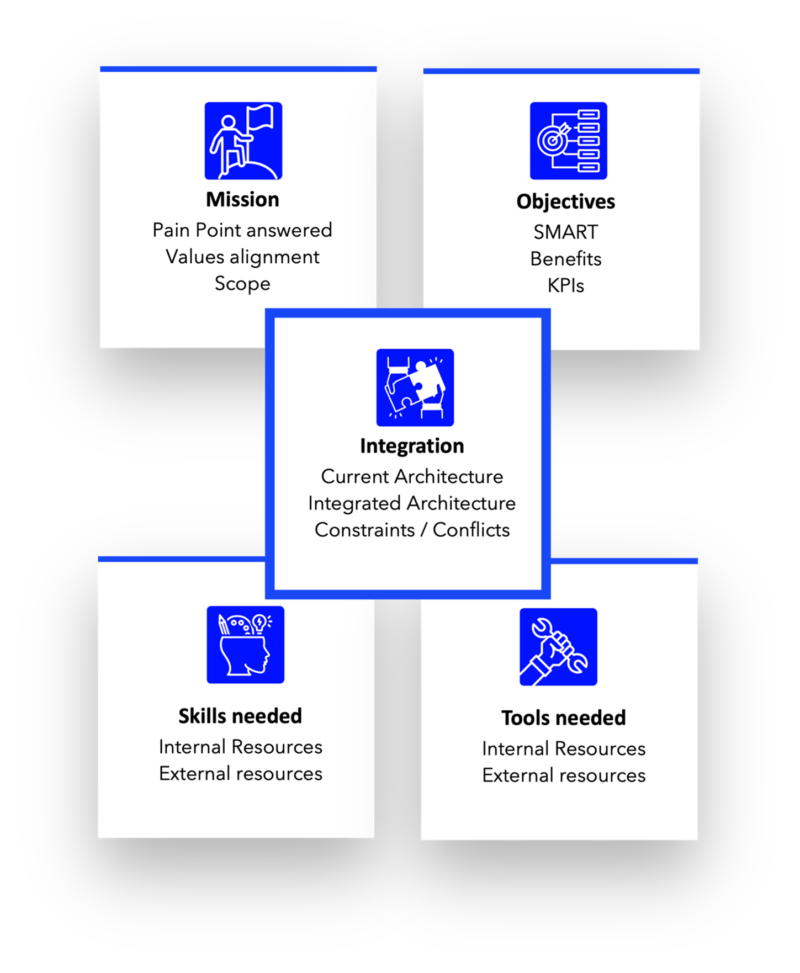
Mission examples
Program mission statements articulate a software development program’s overarching purpose and goals. They often encompass broader objectives that guide the development of multiple projects or initiatives within the program. Here are examples of program mission statements that incorporate the objectives mentioned earlier:
• Strategic Objective:
Mission Statement: “Our program aims to drive customer-centric innovation by developing software solutions that enhance customer engagement, satisfaction, and loyalty across all touchpoints. By leveraging cutting-edge technology and data-driven insights, we seek to create value for our customers and strengthen our competitive position in the market.”
• Operational and Quality Objectives:
Mission Statement: “Our program is committed to delivering high-quality software solutions that streamline operations, improve efficiency, and drive business growth. We strive to develop robust, reliable, and scalable applications that meet the needs of our users and exceed industry standards for performance, reliability, and security.”
• User Experience (UX) Objective:
Mission Statement: “Our program is dedicated to delivering exceptional user experiences by designing and developing intuitive, user-friendly software solutions. By prioritizing user needs, preferences, and feedback, we aim to create engaging and accessible digital experiences that delight our customers and drive user adoption and loyalty.”
• Scalability and Security Objectives:
Mission Statement: “Our program focuses on building scalable, resilient, and secure software solutions that adapt to changing business needs and withstand evolving threats. We prioritize designing and implementing robust architecture, infrastructure, and security measures to ensure our applications’ scalability, reliability, and integrity in dynamic and challenging environments.”
• Compliance Objective:
Mission Statement: “Our program is committed to upholding the highest standards of regulatory compliance and data protection in all aspects of software development. We adhere to industry regulations, standards, and best practices to safeguard user privacy, protect sensitive data, and maintain trust and transparency with our stakeholders.”
These examples demonstrate how program mission statements can encompass various objectives, including strategic alignment, operational excellence, user experience, scalability, security, and compliance. By articulating a clear and compelling mission, software development programs can align stakeholders, inspire teams, and guide development efforts toward achieving meaningful outcomes and impact.
Objective Examples
Here are examples of clear objectives for a new software development project across various categories:
• Strategic Objective:
Objective: Develop a customer relationship management (CRM) software solution to improve customer engagement and retention.
Key Results: Increase customer satisfaction scores by 20% within one year, reduce customer churn rate by 15%, and increase repeat purchase rate by 10%.
• Functional Objective:
Objective: Create a mobile banking application with robust security features for seamless and secure access to banking services.
Key Results: Implement two-factor authentication for user login, integrate biometric authentication (e.g., fingerprint or facial recognition), and provide real-time transaction monitoring and alerts.
• Operational Objective:
Objective: Automate manual processes and streamline workflow management with a custom enterprise resource planning (ERP) system.
Key Results: Reduce manual data entry errors by 50%, decrease processing time for purchase orders by 30%, and increase overall operational efficiency by 20%.
• Quality Objective:
Objective: Develop a bug-free and reliable e-commerce platform to provide a seamless shopping experience for customers.
Key Results: Achieve a defect density rate of less than 1% in production, maintain a system uptime of 99.9%, and ensure that 95% of user-reported issues are resolved within 24 hours.
• User Experience (UX) Objective:
Objective: Design an intuitive and user-friendly interface for a productivity software suite to enhance user satisfaction and productivity.
Key Results: Achieve a usability score of 80% or higher in user testing, reduce average task completion time by 20%, and increase user engagement metrics (e.g., time spent on the platform, frequency of use).
• Scalability Objective:
Objective: Build a scalable cloud-based platform for a social media analytics tool to accommodate increasing data volumes and user traffic.
Key Results: Ensure that the system can handle a 50% increase in concurrent users without performance degradation, support data storage growth of 100% annually, and enable seamless horizontal scaling of infrastructure.
• Security Objective:
Objective: Develop a secure messaging application with end-to-end encryption to protect user privacy and data confidentiality.
Key Results: Achieve compliance with industry security standards (e.g., GDPR, HIPAA), conduct penetration testing to identify and remediate vulnerabilities, and implement regular security audits and updates.
• Compliance Objective:
Objective: Create a regulatory compliance management system to ensure adherence to industry regulations and standards (e.g., GDPR, SOX, PCI-DSS).
Key Results: Implement role-based access controls to restrict access to sensitive data, automate compliance monitoring and reporting processes, and provide audit trails for regulatory oversight.
These examples illustrate how clear objectives for a new software development project can be defined across different dimensions: strategic, functional, operational, quality, user experience, scalability, security, and compliance. Each objective is accompanied by critical results that provide measurable targets for evaluating project success and driving performance improvements.
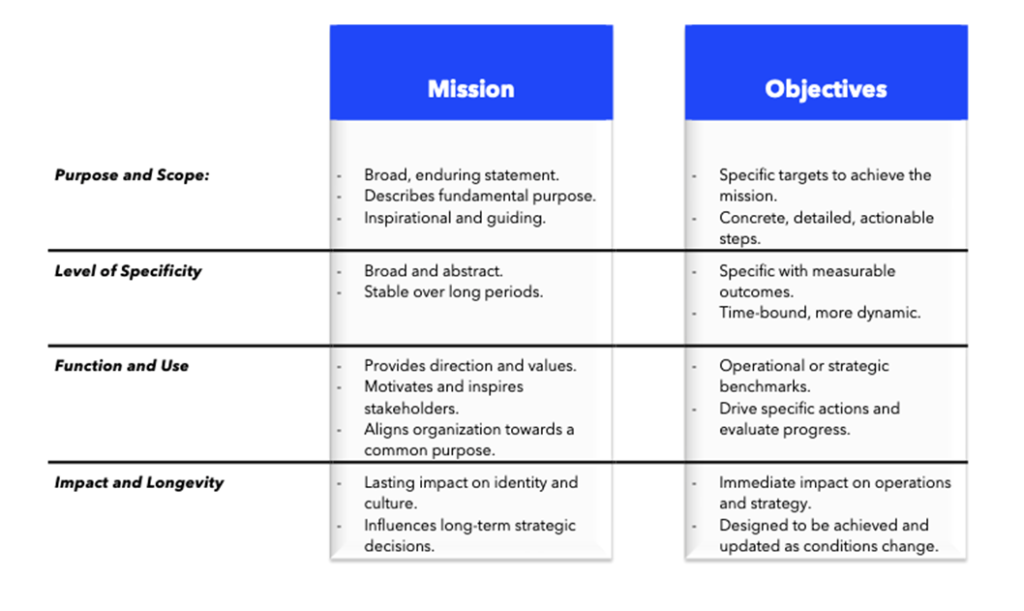
Summary
 In summary, establishing a clear mission and well-defined objectives is crucial for any organization or project aiming for success. The mission serves as a guiding star, setting an organization’s foundational purpose and scope and illuminating the path toward achieving overarching goals. It ensures that every effort and decision is aligned with the organization’s core values and strategic direction. Meanwhile, the objectives provide a detailed roadmap, outlining specific, measurable, and timely targets that propel the organization forward, ensuring that every step taken is a step towards fulfilling the mission.
In summary, establishing a clear mission and well-defined objectives is crucial for any organization or project aiming for success. The mission serves as a guiding star, setting an organization’s foundational purpose and scope and illuminating the path toward achieving overarching goals. It ensures that every effort and decision is aligned with the organization’s core values and strategic direction. Meanwhile, the objectives provide a detailed roadmap, outlining specific, measurable, and timely targets that propel the organization forward, ensuring that every step taken is a step towards fulfilling the mission.
By integrating SMART objectives, organizations can ensure their goals are attainable, relevant but also time-bound, and quantifiable, enabling precise tracking and assessment of progress. This approach fosters alignment across various organizational levels, enhancing cohesion and operational efficiency. Moreover, a well-articulated mission and objectives empower organizations to clearly communicate their purpose and ambitions to stakeholders, enhancing transparency and garnering essential support and commitment.
Furthermore, the chapter underscores the necessity of adapting the mission and objectives as the organization evolves. This adaptability ensures that the organization remains responsive to changes in its internal and external environments, sustaining relevance and effectiveness in achieving its goals.
Ultimately, a robust framework of mission and objectives guides an organization through its present activities and strategically positions it for future challenges and opportunities. This framework is critical in strategic planning, risk management, and continuous improvement, ensuring that the organization survives and thrives in a competitive landscape.

Case Study: ICON
ICON, one of the top 3 research organizations in the world with data available for over 300 million individuals in the US (through drug claims and other claims data), defined the need for post-pharmaceutical test data. The FDA and the pharmaceutical companies recognized that following a patient through a clinical trial was essential and already part of each drug trial. However, it was even more important to follow patients over a longer time to determine if the patient continued to benefit from a particular drug therapy compared to his peers.
To do this, a new product would be required to allow longer-term analyses but keep the patient information confidential. Borrowing from the tokenization used in financial organizations, we applied that to the trial patients. This allows the drug companies to compare the trial patients’ medical course post-trial to their peers. A new product was born using the real-world data of 300 million patients and the tokenization process. The pharmaceutical industry is implementing this for their future trials. The FDA is pursuing this data as part of the clinical trial and post-trial data.
It took us 20 months to build this new tool and process. Most of the building was done internally, but the new venture was a separate business unit responsible for creating new processes for selling and delivering this product to customers.

Exercise: NEWco

Course Manual 7: Establish Authority to Proceed
Starting a program of innovation typically involves a combination of strategic planning, resource allocation, stakeholder engagement, and formal authorization, depending on the organizational context. Here’s a general outline of the steps involved:
Defining Objectives and Scope: It is crucial to identify the goals of the innovation program. Determine whether the focus will be on product, process, or business model innovation. Defining the scope and scale of the program is also essential. Decide whether the program will be organization-wide or concentrated on specific departments to align with strategic objectives.
Securing Buy-in: Engaging organizational stakeholders is necessary to ensure broad support for the innovation initiative. This involves communicating with senior leadership, potential innovation program participants, and possibly board members. Clearly articulate the program’s value and potential impact to gain their support and buy-in, emphasizing how it aligns with the organization’s strategic goals.
Developing a Proposal: Prepare a detailed proposal that outlines the innovation program’s vision, goals, structure, needed resources (budget, personnel, technology), and expected outcomes. The proposal should also demonstrate how the program aligns with the organization’s strategic objectives. This comprehensive document serves as a blueprint for gaining formal authorization and guiding the program’s implementation.
Obtaining Formal Authorization: Depending on the organization, obtaining formal authorization might involve approval from senior management, the board of directors, or even shareholders. Identify the project’s most senior sponsor, who will be accountable for its success. The authorization process may require presenting the proposal in meetings, providing detailed reports, and addressing any concerns or questions to secure the necessary approvals.
Allocating Resources: Once the proposal is approved, secure the necessary resources to support the innovation program. This includes budget, personnel, and any required technology or tools. Consider forming partnerships or collaborations inside and outside the organization to enhance the program’s capabilities and ensure its success.
Establishing Governance Structures: Create a governance structure to oversee the innovation program. This includes defining roles and responsibilities, decision-making processes, and oversight mechanisms. Depending on the program’s scale, setting up a dedicated innovation team or office may be beneficial to manage and support innovation activities effectively.
• Launching the Program: Start the innovation program with clear communication to the organization. Develop an internal marketing strategy to maintain excitement and engagement among employees. Implement the processes and tools to manage innovation activities, such as idea management systems and innovation labs, ensuring the program is structured and supported.
Developing a Solid Proposal
Securing formal approval to launch a new initiative involves more than just presenting a good idea; it requires a comprehensive and compelling argument demonstrating the project’s viability, strategic alignment with the organization’s broader goals, and the tangible benefits it promises. This chapter guides you through meticulous preparation and critical considerations to craft a strategic proposal. This plan will not only present a vision that aligns with the organization’s aspirations but will also address potential concerns of various stakeholders by demonstrating thorough risk management, financial foresight, and operational readiness.
We will explore how to articulate the project’s objectives, structure, and intended outcomes in a manner that resonates with the stakeholders’ values and expectations. The goal is to present a straightforward, data-backed narrative that outlines the project’s direct contributions to strategic objectives such as revenue growth, cost efficiency, innovation, or market expansion. We’ll delve into how to effectively communicate the project’s alignment with the organization’s existing capabilities and strategic direction, illustrating how it builds on previous successes or pivots from less effective strategies.
How will the project be monitored? Establish metrics and KPIs to monitor the progress and success of the innovation program. Regularly evaluate the impact and adjust as necessary. Following these steps ensures that your organization systematically establishes an authority and foundation for a successful innovation program. Flexibility and adaptability are essential as the program evolves and organizational needs change.
What about the architecture? When initiating a new project, particularly one that brings innovative changes within an organization, presenting the project’s architecture to the board and stakeholders is crucial. It informs, reassures, and garners the support needed to progress successfully. This section will guide you through effectively presenting the project’s architectural framework, emphasizing its alignment with organizational goals and feasibility.
Articulating the Architectural Vision
When presenting a project’s architectural vision, it is crucial to emphasize strategic alignment and provide a high-level overview of the system architecture. First, link the project’s architectural design with the organization’s strategic goals. Demonstrate how the proposed architecture addresses specific business challenges or opportunities and aligns with the organization’s long-term vision. This connection helps stakeholders understand the relevance and importance of the project within the broader organizational context.
Next, provide a high-level diagram that encapsulates the overall system architecture. This diagram should clearly explain how new components integrate with the existing infrastructure, highlighting efficiency, scalability, and capabilities improvements. By presenting a clear and comprehensive overview, stakeholders can visualize the architectural changes and their impact on the organization’s operations and future growth.
Technical Specifications and Integration:
To effectively present the technical specifications and integration plans, develop high-level technical specifications that outline the system’s key components, their functionalities, and the technologies that will be employed. These specifications should illustrate the system’s robustness and ability to integrate smoothly with current systems, providing a clear understanding of the technological foundation and expected performance.
Additionally, demonstrate interoperability by presenting examples or case studies of similar technology integrations that have succeeded within the industry. These examples reassure stakeholders of the architectural plan’s feasibility and reliability, showing that the proposed technology has been successfully implemented in similar contexts. This combination of detailed specifications and proven examples helps build confidence in the project’s technical viability and integration capabilities.
Demonstrating Scalability and Flexibility
Discuss how the architecture supports current needs and future growth to demonstrate scalability and flexibility. Provide a scalability roadmap with models or projections to show how the system can expand in response to increased demands or scale back in more conservative scenarios. This roadmap will help stakeholders understand the system’s capacity for growth and ability to adjust to varying needs.
Next, highlight the architectural flexibility to adapt to new technologies and changes in the market environment. Explain how the design allows for easy updates and the integration of emerging technologies without requiring significant overhauls. By showcasing the system’s adaptability, you can illustrate how the architecture is prepared to evolve with technological advancements and market shifts, ensuring long-term relevance and efficiency.
Addressing Risks and Showcasing Robustness
To address risks and showcase the system’s robustness, begin by incorporating a comprehensive risk analysis that identifies potential architectural risks and outlines the measures to mitigate them. This analysis should cover technical, operational, and strategic risks, demonstrating the project’s preparedness to handle various challenges.
Next, the architecture’s robustness features, such as redundancy, fault tolerance, and disaster recovery plans, should be emphasized. Highlight how these features ensure the system’s resilience and the continuity of business operations, reassuring stakeholders of the project’s reliability and the organization’s commitment to maintaining a secure and stable environment.
External Vendors
Engaging external vendors is integral to the project’s success in strategic sourcing. Clearly outline the roles of these third parties and detail the selection process to ensure they align with the project’s strategic goals. Describe how their contributions will seamlessly integrate into the broader project framework, ensuring cohesive collaboration and efficient implementation.
Financial Justification and ROI
Cost-Efficiency: Discuss the new architecture’s cost implications, including the initial investment and expected operational savings. Provide a clear return on investment (ROI) forecast based on improved efficiencies or increased revenue opportunities, demonstrating the project’s financial benefits.
Budget Allocation and Financial Planning: Detail how funds will be allocated within the project, ensuring stakeholders manage financial resources wisely. Include contingencies and justify expenditures concerning the anticipated benefits. When crafting a project budget, it is essential to meticulously account for all financial aspects to ensure adequate and appropriately allocated funding. This comprehensive budgetary outline should cover various categories of expenses the project will incur from start to finish.
Types of Costs:
Initial capital expenditure encompasses upfront project launch costs, including equipment purchases, software licenses, and setup fees. These one-time investments require precise documentation. Operational expenses cover ongoing costs related to daily project operations, such as salaries, recurring service fees, utilities, and supplies. Maintenance and support costs include expenses for maintaining and updating equipment and software, as well as technical support and troubleshooting, which are crucial for long-term project viability. Contingency funds are reserved budgets set aside to address unexpected costs or risks, typically 5-10% of the total budget, based on risk evaluation. Lastly, resource scaling costs are linked to adjusting project resources to meet changing demands, including expenses for hiring, training, or reducing resources.
Clearly explain the rationale behind each budget allocation, linking costs directly to specific project milestones and objectives. This demonstrates how financial planning supports the project’s strategic goals, providing a straightforward narrative for stakeholders.
• Engaging Stakeholders with Interactive Tools: To effectively engage stakeholders, use advanced visualization tools during presentations to help them understand complex technical details. Interactive models that allow stakeholders to view different aspects of the architecture can be particularly effective. A two-way communication channel should also be established for stakeholders to provide feedback or raise concerns during the presentation. This engagement is crucial for adjusting the project plan to fit organizational needs better and building consensus.
By carefully crafting the presentation of the project architecture, you can effectively communicate its value and viability to the board and stakeholders. This strategic approach facilitates the approval and support necessary for the project’s commencement and lays a foundational trust in its successful implementation and integration within the organizational landscape.
• Risks & Mitigations
Provide a thorough risk assessment that identifies potential challenges and the strategic measures designed to mitigate these risks. This section should not only list potential risks but also include detailed scenarios and proactive strategies for handling unexpected developments. You underline the project’s preparedness and commitment to safeguarding the organization’s interests by showcasing a well-thought-out risk management plan.
Risk Assessment Tools:
Risk Register: Utilize a risk register to systematically identify, describe, and assess potential risks. This tool helps document each risk’s nature, likelihood, potential impacts, and the measures planned for mitigation.
SWOT Analysis: Conduct a SWOT (Strengths, Weaknesses, Opportunities, Threats) analysis to gain a broader understanding of internal and external factors that could impact your project. This helps align your risk mitigation strategies with the organization’s capabilities and market conditions.
Monte Carlo Simulations: Implement Monte Carlo simulations for quantitative risk analysis. This statistical technique allows you to model the probability of different outcomes in complex situations, providing a clearer picture of potential risks and their impacts.
Failure Mode and Effects Analysis (FMEA): Use FMEA to anticipate potential points of failure in the project’s processes. This analysis helps to prioritize risks based on their severity, occurrence, and detectability, guiding the focus toward critical vulnerabilities.
Scenario Planning: Engage in scenario planning to anticipate and plan for possible future conditions. This helps prepare flexible response strategies that can be quickly deployed as different scenarios unfold.
• Time and Cost Considerations:
Detail a phased timeline that outlines major milestones and implementation phases, aligning these phases with their corresponding costs. This timeline should set realistic expectations and include buffer periods for potential delays, ensuring stakeholders have a pragmatic understanding of the project’s schedule. Emphasize the financial implications of the project duration. Shorter project timelines can reduce resource allocations and operational overhead costs, allowing for quicker market entry, which can be critical for realizing the project’s benefits sooner. Conversely, extended timelines might increase expenses but could be necessary to ensure thoroughness and quality.
Discuss how efficient time management and judicious resource use can lead to significant cost savings and a better return on investment. Highlight strategies that optimize time and resources, such as agile project management techniques or lean methodologies, which can accelerate deliverables and reduce waste.
Detailing these budgetary components and their relationship with project time and milestones gives stakeholders a transparent view of the project’s financial dynamics. This clarity helps secure approvals, and fosters trust in the project’s economic management.
• Change Management
Elaborate on the change management strategies that will be employed to handle the transitions and transformations necessitated by the project. Discuss the tools and techniques that will be used to manage change, including training programs, stakeholder communication plans, and feedback mechanisms. Emphasizing a robust change management plan illustrates a commitment to ensuring smooth transitions and minimizing operational impact.
• Leadership/Sponsor/Program Manager
Detail the leadership structure of the project, including the backgrounds and roles of key personnel such as the project sponsor and manager. Highlight their experience, past successes, and specific qualifications that make them suited to lead this initiative. Strong leadership instills confidence in the project’s management and ability to achieve the set goals.
• Quality Assurance:
Establish quality control approaches for the project, including measures to be adhered to and audits to ensure all deliverables meet the required standards.
Summary
This chapter covers the work required to present a proposal for developing an initiative. To be successful, it is essential to know who the sponsor will be and how the initiative fits into the organization’s overall vision, priority, and growth strategy for the future.


Exercise: NEWco

Course Manual 8: Talent Management Strategies
Effective talent management is a cornerstone of strategic sourcing initiatives, ensuring that the right people with the right skills are in place to drive organizational success. This chapter explores various methods and best practices for optimizing talent management within your organization. We delve into the processes involved, from the initial onboarding of new employees to the continuous integration of external talents, all aimed at enhancing your strategic capabilities.
Selecting the right people for a strategic project is crucial for its success. Here’s a structured approach:
1. Define Project Requirements: Clearly outline the project’s objectives, scope, timeline, and required skills. This will help identify the expertise needed.
2. Identify Key Roles: Break down the project into critical roles and responsibilities. Typical roles may include project manager, project coordinator, subject matter expert, analyst, developer, process improvement engineer, change management consultant, etc.
3. Assess Skills and Expertise: Evaluate potential team members based on their skills, experience, and expertise relevant to the project requirements. Consider technical skills, domain knowledge, problem-solving abilities, and past performance.
4. Consider Variety: Aim for expertise, perspectives, backgrounds, and working styles. A team can bring different ideas, creativity, and innovation, enhancing problem-solving and decision-making.
5. Evaluate Availability and Commitment: Ensure team members have the capacity and commitment to dedicate themselves to the project. Check for existing workloads and obligations to prevent overburdening team members.
6. Assess Team Dynamics: Consider how potential team members work together. Look for individuals who can collaborate effectively, communicate openly, and handle conflicts constructively.
7. Review Past Performance: Examine past project performance, including successes and challenges, to identify individuals with a track record of delivering results and overcoming obstacles.
8. Seek Stakeholder Input: Get input from stakeholders, including senior management, department heads, and key project sponsors, to ensure alignment between project goals and team composition.
9. Conduct Interviews or Assessments: Interview potential team members to gauge their interest, commitment, and suitability for the project. Consider using assessments or simulations to evaluate their skills and problem-solving abilities.
10. Finalize Team Composition: Based on the assessment of skills, expertise, availability, commitment, and stakeholder input, finalize the project team composition. Ensure that the selected team members have the necessary support and resources to succeed in their roles.
Building the right project team involves individual capabilities and how well they can work together towards a common goal. Regular communication, ongoing support, and effective leadership are essential for maximizing the team’s performance and achieving project success.
Selecting and Onboarding for Success
Selecting people for a program is more art than science, requiring an understanding of what will be needed for the project to be successful and the candidates’ experience or interest in the project’s growth potential. Often, project staffing roles may be adjusted to accommodate applicants’ skills. As you create work teams, ensure enough talent to accomplish the required outcomes.
The onboarding process is your first opportunity to embed new hires into the organizational culture and clarify their roles within the company’s strategic framework. Effective onboarding goes beyond simple orientation; it involves tailored, in-depth training sessions that connect new hires with their teams and critical projects from the start. Technology such as virtual reality tours and interactive platforms enhances the onboarding experience. In contrast, augmented reality applications simulate real-life scenarios that employees might face, providing a more engaging and immersive learning environment. Mentorship programs are crucial, pairing newcomers with experienced mentors who guide them through their early days and help them navigate the company landscape.
Integrating external talent from different corporate cultures requires careful management to align new skills and perspectives with existing organizational standards and goals. Specific challenges such as cross-cultural training and compliance with global employment laws need dedicated strategies to ensure smooth integration. Techniques such as cultural assimilation workshops and compliance training sessions help external talents blend their expertise with the company’s established practices. Regular check-ins and structured feedback sessions help quickly identify and address cultural or operational misalignments, ensuring smooth transitions and effective collaboration.
Assessing and Developing Skills
Identifying the capabilities of potential and existing employees involves a systematic approach to determine the skills and competencies necessary to meet organizational goals. This process should start with clearly defining role-specific competencies aligned with strategic objectives, utilizing competency frameworks and job analysis techniques. Evaluating these capabilities requires a mix of skill assessments, performance reviews, and 360-degree feedback. Skill assessments should measure specific skills and knowledge, performance reviews to assess contributions towards strategic goals, and 360-degree feedback to provide a comprehensive view of an employee’s capabilities and improvement areas.
Once the project has started, it will be our job to assess the skills of each team member along with their specific skill development. Skill assessment is a critical ongoing process that helps understand your workforce’s capabilities and pinpoint areas where development is needed. These assessments should be regular and comprehensive and may incorporate tools such as AI-driven analytics for precision. AI technologies can analyze performance data in real-time, providing insights that are not immediately apparent through standard evaluation techniques. The insights gained are invaluable for crafting personalized development plans that align with individual career goals and the organization’s strategic needs, incorporating continuous learning and upskilling to keep pace with industry changes.
Facilitating Knowledge Transfer
Maintaining continuity and fostering innovation within an organization requires effective knowledge transfer. Structured knowledge-sharing sessions, such as workshops and seminars, should be complemented by digital tools like internal wikis, social media platforms, or collaborative tools to enhance the efficiency of information dissemination. Advanced collaborative technologies such as cloud-based platforms enable real-time sharing and editing of documents and project materials, making it easier for teams to work together efficiently. These technologies streamline the knowledge-sharing process and, along with encouraging the formation of cross-functional teams, help break down silos within the organization, promoting a more integrated and agile working environment.
Managing Time Efficiently
Accurate timekeeping is essential not just for payroll and compliance but also for effective management of project timelines and resource allocation. Implementing advanced timekeeping systems helps track the duration of tasks and projects, providing insights into work patterns and efficiencies. Sophisticated project management software can offer detailed analytics on time expenditure and resource allocation, enabling managers to pinpoint areas of inefficiency and adjust project schedules accordingly. Analyzing this data allows managers to optimize workflows and enhance productivity, ensuring projects stay on track and within budget.
Selecting Talent and Organizing Teams
Talent selection is a critical process that should be strategically aligned with the organization’s needs. It involves defining the role clearly, sourcing candidates through diverse channels, and conducting thorough screenings and structured interviews to ensure competencies and cultural fit. Assessment centers can simulate job tasks for critical roles to further evaluate candidate skills in a controlled environment. Organizing effective teams is pivotal for maximizing productivity; this includes managing optimal team sizes (typically between 5 to 9 members) to facilitate easier coordination and deeper collaboration, ensuring role clarity to prevent overlap and conflicts, and utilizing cross-functional teams for projects requiring diverse skill sets.
Implementing Agile Processes
Agile methodologies, such as Scrums, are crucial for flexible and frequent reassessment projects. Projects should be broken down into 2-4 weeks sprints to focus on delivering specific components or milestones. Daily stand-ups should be conducted to discuss progress and immediate next steps, keeping the team aligned and focused. An iterative approach to development and testing allows for continuous refinement based on feedback, maintaining high standards of quality and relevance.
Seeing Results
To visualize and assess the impact of these strategies, it’s essential to implement a robust monitoring system that includes performance metrics and regular reviews. Clear KPIs should be defined to measure the effectiveness of teams and individuals, and regular project reviews should be conducted to assess outcomes and integrate lessons learned. Creating channels for continuous feedback from team members is also vital, fostering a culture of open communication and constant improvement.
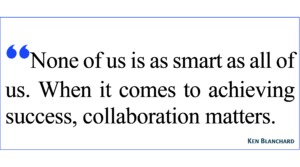
Summary
Talent management is an ongoing strategic endeavor that enhances individual and organizational performance. An organization can significantly improve its strategic sourcing capabilities by investing in comprehensive onboarding, continuous skill development, effective knowledge transfer, and seamless integration of external talent. Regularly revisiting these strategies will ensure your workforce remains adaptable and aligned with the evolving demands of the business landscape, driving sustained success in all your strategic initiatives.
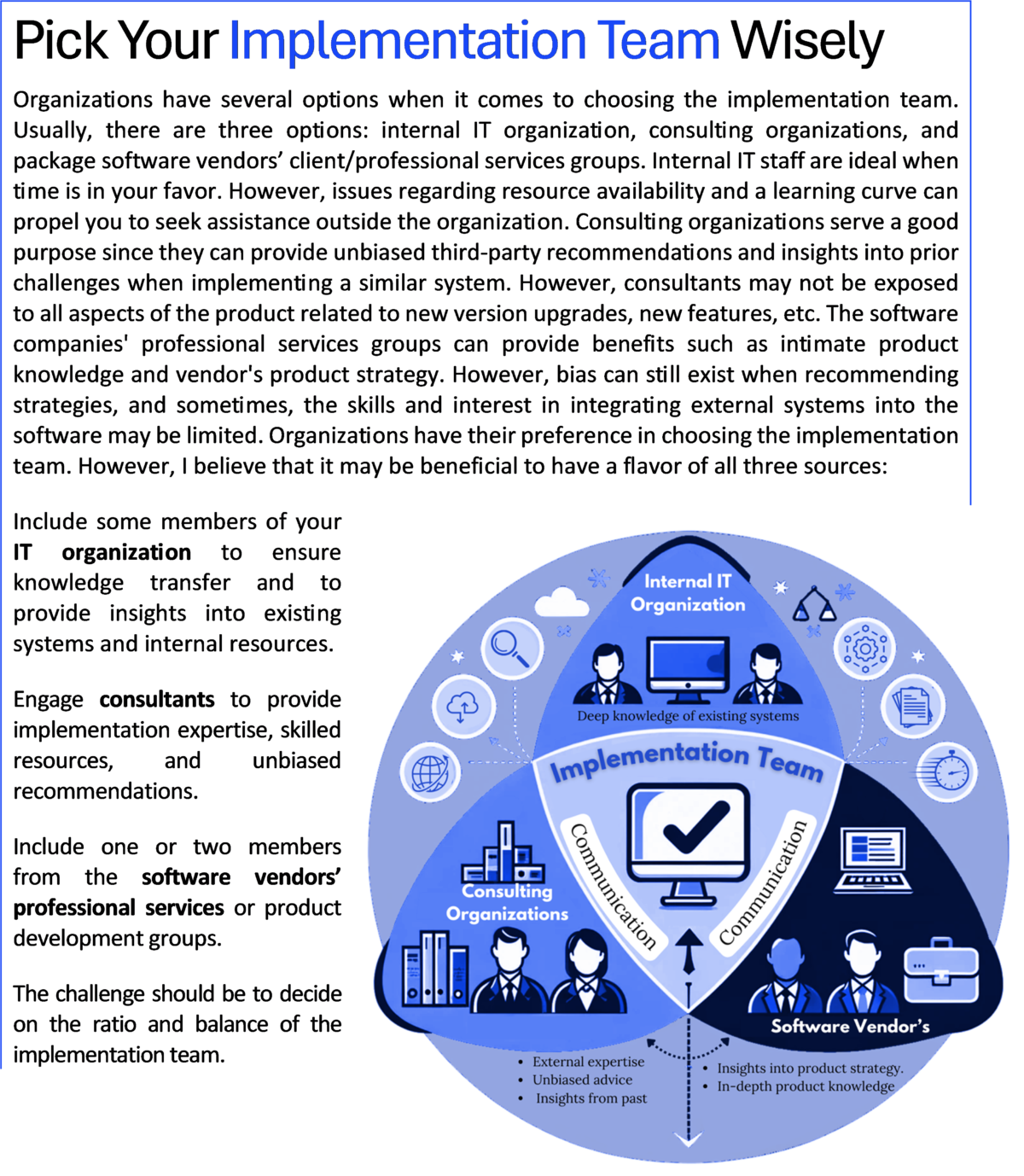

Case Study: Geisinger Health System
In undertaking the primary program to develop a new product, we recognized that we did not have the resources available locally to design the approach, much less the building of the product. Therefore, we had to identify consultants to develop the requirements. We interviewed many business analysts brought on board based on their previous work to help us interview the business experts in various business areas where integration would be necessary and to understand the current process. We had to know how Geisinger had successfully prioritized patients for exceptional care management. In addition, we brought on several external architects to assist in understanding the existing architecture and designing interfaces. In this project, it became clear that parts of the system needed several existing applications to provide for the whole project. For example, correspondence with patients and providers did not have to be developed from scratch as there are COTS applications. Our job was to select the correct application and the project manager and analysts who implemented those applications. The main product was contracted to GE, but we were involved in choosing the people to work on the project on the GE team. This project became a mix of internal resources, subject matter experts, external talent that could be onboarded, and an external developing organization.

Exercise: NEWco

Course Manual 9: Technology/Tools to Help
In the dynamic field of strategic sourcing, project success heavily relies on the effective integration of technology. This chapter delves into the essential tools and systems that support project management, communications, and collaboration, guiding how to select and implement these resources to meet specific project needs and organizational contexts.
Leveraging PMI’s Best Practices and Methodologies
The Project Management Institute (PMI) is renowned for its comprehensive set of standards and best practices in project management, encapsulated primarily in the Project Management Body of Knowledge (PMBOK). PMBOK is widely regarded as the gold standard for project management methodologies, offering a systematic, rigorous, and adaptable approach to project management.
PMBOK outlines a process framework comprising five process groups: Initiating, Planning, Executing, Monitoring and Controlling, and Closing. Each of these groups encompasses several processes that provide a roadmap for managing projects from start to finish. This structured approach is particularly beneficial for strategic sourcing projects, which often require careful coordination of resources, transparent communication across various departments, and meticulous attention to compliance and quality standards.
Initiating: This phase involves defining a new project or a new phase of an existing project by obtaining authorization to start the project or phase. Strategic sourcing could involve aligning project goals with organizational strategic objectives, stakeholder analysis, and establishing initial project scope.
Planning: Planning is crucial for outlining the path to completing the project. This includes developing a project management plan, which integrates all subsidiary plans such as scope, schedule, cost, quality, resource, communication, risk, procurement, and stakeholder management. In strategic sourcing, detailed resource planning, cost estimation, and supplier contract management are integral to this phase.
Executing: The primary focus here is completing the work defined in the project management plan to satisfy the specifications. This involves resource allocation, task execution according to the project schedule, and quality management of deliverables. For strategic sourcing, this could translate into supplier coordination, manufacturing oversight, and compliance with industry standards.
Monitoring and Controlling: This phase involves tracking, reviewing, and regulating the project’s progress and performance. It also consists of identifying any areas in which changes to the plan are required and initiating the corresponding changes. Key performance indicators (KPIs) and project dashboards are essential here, providing real-time data on various aspects of the project, including timelines, budget adherence, and quality control.
Closing: Concluding all activities across all process groups to formally close the project or phase. Strategic sourcing may involve final deliverable acceptance, supplier and stakeholder feedback, and project review for future improvement.
Integration of PMI Standards in Strategic Sourcing
Integrating PMI’s methodologies into strategic sourcing projects offers several advantages. It ensures that projects are managed according to globally recognized standards, which can enhance the credibility and reliability of the sourcing process. Furthermore, extensive guidance on risk management can help sourcing managers identify potential risks early in the project lifecycle, allowing for proactive strategies to mitigate these risks.
The emphasis PMI places on stakeholder management is also critical in strategic sourcing. It ensures that all parties involved, from internal departments to external suppliers, are appropriately engaged and their needs and expectations are managed throughout the project. This is essential for maintaining strong relationships and ensuring project success.
Incorporating PMI methodologies into strategic sourcing ensures a well-structured approach to project management that aligns with the best practices and standards recognized globally. This alignment helps organizations manage their sourcing projects more effectively, ensuring they meet project goals while adhering to high standards of quality and efficiency.
Project Management System
Effective project management transcends sophisticated software; it requires a robust system that encompasses a transparent, shared process to guide all phases of project execution. A well-defined project management system includes methodologies that structure task scheduling, resource allocation, progress monitoring, and reviews, ensuring projects are completed within scope, on time, and within budget.
While specific tools like Microsoft Project or Asana can significantly enhance these capabilities, the key is how these tools are integrated into the daily workflows. Microsoft Project is renowned for its comprehensive features that support detailed project scheduling and resource management, making it ideal for complex projects with multiple dependencies. On the other hand, Asana offers a more user-friendly, collaborative environment that is suitable for teams requiring flexibility and real-time communication.
Regardless of the tool selected, a project management system’s effectiveness lies in its ability to be clearly understood and consistently utilized by the entire project team. This ensures that every team member is on the same page and that project goals are met efficiently. It’s also crucial that the chosen system or tool seamlessly integrates with other tools the organization uses, enhancing data consistency and accessibility.
In strategic sourcing, where projects often involve cross-departmental collaboration and various external stakeholders, tracking progress, updating schedules, and communicating real-time changes can significantly affect project outcomes. Therefore, while the choice of tool is essential, ensuring that it supports a clear and shared project management process is paramount.
Agile Project Management Tools and Concepts
Many ask: Can formal project management software coexist with agile processes for a specific project? Yes, formal Microsoft Project schedules can coexist with Jira and Sprint planning in Agile development, although integrating them effectively requires careful planning and clear communication across teams. This hybrid approach can leverage the strengths of both traditional project management and Agile practices. Here’s how they can work together:
• High-Level Planning with Microsoft Project:
Microsoft Project is well-suited for high-level project planning and management. It can map out project milestones, significant deliverables, and dependencies across multiple teams and projects. This tool is handy in environments with fixed timelines and budgets and where senior management requires visibility into the overall project timeline and resource allocation.
• Detailed Task Management with Jira:
On the other hand, Jira excels at managing more granular tasks and is highly adaptable to changes, a hallmark of Agile development. Jira can manage backlogs, plan sprints, track issues, and maintain documentation within an Agile framework. It supports the daily operations of development teams, allowing them to adjust to changes in priorities and requirements.
• Bridging the Tools through Integration:
Integrating Microsoft Project and Jira allows organizations to maintain a high-level overview and detailed task management. Various third-party tools and plugins can sync data between Microsoft Project and Jira, allowing updates in one tool to reflect in the other automatically. This helps maintain consistency in reporting and ensures that strategic and operational perspectives are aligned.
• Communication and Updates:
Regular communication is essential when using both Microsoft Project and Jira. Project managers and Agile teams need to establish routines for updating both systems to reflect the project’s current state accurately. This might involve regular sync meetings or automated reports highlighting progress and discrepancies between the planned and actual project status.
• Role Clarification:
To make this hybrid approach work, it’s essential to clearly define the roles and responsibilities of everyone involved in the project. Traditional project managers might focus on resource allocation and milestone tracking using Microsoft Project, while Scrum masters or Agile coaches manage the day-to-day development process within Jira.
This dual approach allows companies to manage complex, multi-faceted projects that benefit from structured planning and Agile flexibility. It benefits large organizations or projects involving external stakeholders with traditional project management expectations. By carefully integrating these tools and processes, companies can achieve a balance that maximizes the benefits of both methodologies.
Jira and Kanban Boards
Jira is a versatile tool widely recognized for its robust capabilities in managing bugs, issues, and complex project activities, especially within software development and IT fields. It supports agile project management methodologies with integrated features, such as Scrum and Kanban boards, making it exceptionally useful for strategic sourcing projects requiring rigorous task tracking, sprint planning, and real-time reporting. The tool allows project managers and teams to maintain meticulous oversight of every aspect of the project lifecycle, from initiation to closure, ensuring that all deliverables are met within the stipulated timelines.
Kanban boards offer a dynamic visual tool to manage workflow and tasks efficiently. Unlike traditional project management tools that may enforce a linear task structure, Kanban boards provide a flexible and interactive way to view the progress of various tasks across different project stages. They are instrumental in environments that require high flexibility and continuous delivery, which are common in strategic sourcing projects involving numerous stakeholders and frequent adjustments. This visual system helps teams quickly identify bottlenecks or delays, allowing for swift adjustments that keep projects on track.
Sprints, Epics, and User Stories
In agile project management, sprints serve as a fundamental unit of measurement and execution. A sprint is a predetermined timeframe for specific project tasks or tasks to be completed and prepared for review. This approach is critical to the Scrum methodology, promoting a structured yet flexible environment where teams can focus intensively on selected tasks without the distraction of broader project goals. By breaking down projects into shorter, manageable intervals (usually two to four weeks), teams can achieve more frequent accomplishments and maintain a higher level of motivation.
Epics and user stories further refine the task breakdown structure within agile frameworks. An epic is a large, complex body of work that can be divided into smaller, more manageable segments known as user stories. These stories describe features or functions from the end-users or customer’s perspective, ensuring that the development work aligns closely with user needs and expectations. This breakdown not only simplifies task management but also enhances clarity for the development teams, as each user story represents a specific requirement or function that contributes to the larger, overarching goal of the epic.
User stories are particularly compelling because they focus on benefit, acceptability, and testability criteria. These criteria are described in simple, straightforward language accessible to all project stakeholders, including non-technical members. This method allows projects to maintain a user-centered focus, essential in delivering solutions that meet customer needs and preferences.
Integration of Agile Tools into Strategic Sourcing Projects
Incorporating these agile project management tools and concepts into strategic sourcing projects can significantly enhance the visibility and tracking of project progress. By adopting Jira, teams can leverage detailed dashboards and reporting features to inform all stakeholders of the project’s status in real-time. Kanban boards facilitate a seamless flow of tasks, accommodating changes and updates without disrupting the project timeline.
Furthermore, by structuring projects into sprints and defining requirements through epics and user stories, teams can ensure that each phase of the project is aligned with the organization’s strategic goals while being adaptable enough to respond to changing market conditions or project requirements. This structured yet flexible approach is crucial in strategic sourcing, where projects often span different departments and involve a variety of external suppliers and partners.
Overall, the integration of these agile project management tools and methodologies promises not only enhanced project oversight and execution but also a greater alignment with business objectives and user needs, driving more successful outcomes in strategic sourcing initiatives.
Collaboration Tools
Collaborative platforms are indispensable in the complex strategic sourcing environment, where multiple stakeholders often work on intersecting tasks across different locations. These tools, such as SharePoint and Google Documents, provide a shared space where documents and project structures can be accessed and edited in real-time. This capability is crucial for maintaining the flow of information and ensuring that all participants work with the most up-to-date data, thereby minimizing discrepancies and misunderstandings.
Features and Benefits of Key Collaboration Tools
SharePoint: Microsoft SharePoint is a robust platform that builds websites. It is highly effective as a document management and storage system, allowing users to organize information and collaborate. SharePoint’s deep integration with Microsoft Office and its powerful content management capabilities make it ideal for handling complex projects where document control and access management are critical. Its features allow for setting up automated workflows for document reviews and approvals, enhancing efficiency and adherence to compliance standards.
Google Documents: Part of the Google Workspace, Google Documents allows for real-time document creation, revision, and collaboration. What separates Google Docs is its ease of use and accessibility from any device with an internet connection. Multiple users can work on the same document simultaneously, tracking and syncing changes instantaneously. This immediacy can significantly boost productivity and ensure all team members have immediate access to the latest updates.
Advanced Features for Enhanced Collaboration
These platforms offer sophisticated features that enhance collaboration and project management:
Real-Time Editing and Communication: SharePoint and Google Documents support real-time editing, complemented by built-in chat features. This allows team members to discuss changes as they make them, which is particularly useful for remote teams who rely on swift communication to resolve issues and push projects forward.
Version Control and Audit Trails: These platforms automatically save previous versions of documents and provide detailed audit trails. This capability ensures that teams can revert to earlier versions if needed and track changes made to documents, offering protection against accidental data loss and providing clarity over the evolution of project documents.
Rights Allocation and Access Control: Both platforms enable administrators to set specific access rights for users or groups. This ensures that sensitive information is only accessible to authorized personnel, reducing the risk of data breaches. In strategic sourcing, where confidentiality and data security are paramount, having robust access control mechanisms is critical.
Integration with Other Tools: SharePoint and Google Documents can integrate with various other tools, such as project management software and CRM systems, creating a seamless workflow environment. This integration capability allows for centralizing information and processes, simplifying management tasks, and enhancing overall project efficiency.
Collaborative platforms like SharePoint and Google Documents are more than just tools for document management; they are central to fostering a collaborative culture and enhancing the efficiency of project execution. By leveraging these platforms, organizations can improve coordination, accelerate decision-making, and maintain high levels of security and compliance, all of which are crucial for successfully managing strategic sourcing projects. As projects become more dynamic and dispersed, the role of these collaboration tools becomes increasingly central to achieving project goals and organizational objectives.
Communications Platforms
Effective communication is central to the success of strategic sourcing projects, which typically involve numerous stakeholders and complex information flows. A robust communication platform is essential for ensuring information is timely, targeted, and accessible to all relevant parties.
The cornerstone of effective project communication is the strategic management of information flows. This involves identifying the communication needs of various stakeholders and designing processes that ensure information is shared efficiently and effectively. A well-structured communication platform allows project managers and team members to distribute information in a manner that is both accessible and secure, minimizing delays and misunderstandings.
Critical components of an effective communications platform include:
Centralized Information Systems: Utilize platforms like SharePoint or intranet sites for storing, updating, and accessing documents, ensuring all project participants have the most current information.
Real-Time Communication Tools: Use platforms like Microsoft Teams or Slack for instant messaging and discussions, facilitating rapid decision-making and ongoing communication.
Dedicated Email Channels: Essential for formal communications, record-keeping, and engaging external stakeholders, email remains a fundamental tool despite the prevalence of faster communication methods.
Scheduled Updates and Reports: Implement regular updates through weekly emails or monthly reports to inform all stakeholders about project progress, milestones, and any arising challenges.
In addition to utilizing various communication tools, employing a structured approach to defining the specific communication needs of stakeholders is beneficial. Communication Tables, as outlined in PMI methodology, are an excellent example. These tables help systematically identify who needs to receive what information, the format it should be delivered in, and the frequency of communication. This method ensures that communication is tailored to the requirements of each stakeholder, enhancing clarity and effectiveness throughout the project lifecycle.
Project Dashboards and KPIs
Project dashboards are essential tools in modern project management. They provide a real-time consolidated view of all critical project metrics and KPIs. These dashboards are instrumental in helping project managers and stakeholders monitor project health and progress. By displaying data like status, upcoming milestones, risk levels, and resource utilization, dashboards help make informed decisions quickly and effectively.
Dashboards are especially valuable in environments where multiple projects run simultaneously, as they offer a quick, visual means to compare project progress and identify any potential issues before they become significant problems. They can be customized to focus on different aspects of a project—financial, resource, schedule, or quality—and can be set to update dynamically as new data becomes available.
Tools like Microsoft Power BI, Tableau, and Smartsheet provide robust dashboard capabilities, allowing for integration with various data sources and offering powerful visualization tools to make the data accessible and actionable.
KPIs in Development
Key Performance Indicators (KPIs) are quantifiable measures used to gauge a project’s overall performance and effectiveness. In strategic sourcing and project management, choosing the right KPIs is crucial for tracking efficiency, effectiveness, and meeting strategic objectives. Common KPIs in project management include:
Project Completion Rates: Measures the percentage of projects completed on time, providing insight into the efficiency of project execution.
Budget Adherence: This KPI tracks how closely the project expenses align with the budgeted amounts. It is essential for financial oversight and ensuring the project does not exceed its allocated resources.
Time to Market: This KPI is particularly relevant in product development and launch projects. It measures the time taken from project initiation to the product reaching the marketplace.
Quality of Deliverables: Assesses a project’s quality outcomes, ensuring that deliverables meet the required standards and specifications. This might be measured through defect rates, stakeholder satisfaction, or post-launch product returns and repairs.
Effectively Using Dashboards and Selecting KPIs
To maximize the utility of project dashboards and KPIs, it’s essential to follow best practices in their design and implementation:
Select Relevant KPIs: Choose KPIs that directly reflect the project’s critical success factors. This ensures that the dashboard focuses on the most impactful data, aiding in effective decision-making.
Customize Dashboards for Audiences: Different stakeholders may require different information from a project. Customizing dashboards to suit the needs of specific audiences (like project teams, executives, or clients) can make the information more valuable and actionable.
Regularly Update and Review: Dashboards should be updated in real-time or at frequent intervals to reflect the project’s most current state. Regular reviews of the dashboard and the underlying KPIs can help identify trends in a timely manner, enabling proactive management actions.
Integrate with Other Systems: Ensure dashboard tools integrate seamlessly with other project management software and data systems the organization uses. This integration allows automatic data flow into the dashboard, reducing manual data entry errors and saving time.
By integrating these various tools and practices into a cohesive communication strategy, organizations can prevent the formation of information silos and ensure that every stakeholder, whether internal or external, has the correct information at the right time. This supports collaboration and operational efficiency and underpins strategic decision-making across the project lifecycle.
Collaboration Tools
Collaborative platforms are indispensable in the complex strategic sourcing environment, where multiple stakeholders often work on intersecting tasks across different locations. These tools, such as SharePoint and Google Documents, provide a shared space where documents and project structures can be accessed and edited in real time. This capability is crucial for maintaining the flow of information and ensuring that all participants work with the most up-to-date data, thereby minimizing discrepancies and misunderstandings.
Features and Benefits of Key Collaboration Tools
SharePoint: Microsoft SharePoint is a tool that builds information websites on projects. It is highly effective as a document management and storage system, allowing users to organize information and collaborate. SharePoint’s deep integration with Microsoft Office and its powerful content management capabilities make it ideal for handling complex projects where document control and access management are critical. Its features allow for setting up automated workflows for document reviews and approvals, enhancing efficiency and adherence to compliance standards.
Google Documents: Part of the Google Workspace, Google Documents allows for real-time document creation, revision, and collaboration. What separates Google Docs is its ease of use and accessibility from any device with an internet connection. Multiple users can work on the same document simultaneously, tracking and syncing changes instantaneously. This immediacy can significantly boost productivity and ensure all team members have immediate access to the latest updates.
Advanced Features for Enhanced Collaboration
These platforms offer sophisticated features that enhance collaboration and project management:
Real-Time Editing and Communication: SharePoint and Google Documents support real-time editing, complemented by built-in chat features. This allows team members to discuss changes as they make them, which is particularly useful for remote teams who rely on swift communication to resolve issues and push projects forward.
Version Control and Audit Trails: These platforms automatically save previous versions of documents and provide detailed audit trails. This capability ensures that teams can revert to earlier versions if needed and track changes made to documents, offering protection against accidental data loss and providing clarity over the evolution of project documents.
Rights Allocation and Access Control: Both platforms enable administrators to set specific access rights for users or groups. This ensures that sensitive information is only accessible to authorized personnel, reducing the risk of data breaches. In strategic sourcing, where confidentiality and data security are paramount, having robust access control mechanisms is critical.
Integration with Other Tools: SharePoint and Google Documents can integrate with various other tools, such as project management software and CRM systems, creating a seamless workflow environment. This integration capability allows for the centralization of information and processes, simplifying management tasks and enhancing overall project efficiency.
Collaborative platforms like SharePoint and Google Documents are more than just tools for document management; they are central to fostering a collaborative culture and enhancing the efficiency of project execution. By leveraging these platforms, organizations can improve coordination, accelerate decision-making, and maintain high levels of security and compliance, all of which are crucial for successfully managing strategic sourcing projects. As projects become more dynamic and dispersed, the role of these collaboration tools becomes increasingly central to achieving project goals and organizational objectives.
Time Keeping & Approvals
Accurate timekeeping is fundamental to effective project management, particularly in strategic sourcing, where multiple activities and transactions need close monitoring. Proper timekeeping ensures that all project activities are logged and accounted for, which helps maintain budget discipline and operational efficiency. By tracking the time spent on various project tasks, managers can gauge productivity, determine cost efficiency, and ensure resource allocation aligns with project needs.
Streamlined Approval Processes
Streamlined approval processes are equally crucial for maintaining project momentum and administrative efficiency. In complex projects, delays in approvals can lead to project bottlenecks, misallocated resources, and, ultimately, project overruns. Automating these processes helps minimize delays, reduces the administrative burden on team members, and ensures that critical project decisions are made swiftly and effectively. Automation also reduces human error and provides a clear audit trail that can be invaluable for compliance and review processes.
Tools for Timekeeping and Approvals
Several tools can automate time entries and streamline approval chains, contributing significantly to project efficiency:
Time Tracking Tools: Applications like Toggl, Harvest, and Timesheets.com offer user-friendly interfaces for time tracking across multiple projects and tasks. These tools often feature start-stop timers, manual time entry options, and other project management software integrations to ensure that time tracking is seamless and non-intrusive.
Approval Workflow Automation: Tools like Kissflow, ProcessMaker, and Asana provide functionalities to automate approval workflows. They allow for the setting up custom approval processes, where requests can automatically be routed to the appropriate approvers based on specific rules, project stages, or budget thresholds. These tools also typically include features for tracking the status of approvals, sending reminders, and maintaining records of all actions taken.
Benefits of Integration:
Integrating timekeeping and approval processes within the broader project management framework offers several significant benefits. Enhanced transparency is one of the key advantages, as integrated tools provide project managers and stakeholders with a clear view of how time and resources are being spent. This transparency is crucial for monitoring the current status and planning future projects based on historical data.
Improved productivity is another major benefit. Automated tools reduce the time team members spend on administrative tasks, allowing them to focus more on core project activities. This shift can lead to significant gains in productivity and overall project performance.
The integration also facilitates data-driven adjustments. With real-time data on time usage and approvals, project managers can make informed decisions quickly. For example, if a task consistently takes longer than anticipated, resources can be reallocated to address this bottleneck, ensuring the project stays on track.
Additionally, automated timekeeping and approval workflows provide a verifiable data trail crucial for compliance, particularly in regulated industries. This integration fosters a culture of accountability, as team members know their time and actions are being logged and reviewed, promoting adherence to project timelines and quality standards.
For strategic sourcing projects, where precision in budgeting and efficiency in process execution are paramount, leveraging advanced timekeeping and approval tools is not just an option but a necessity. By choosing the right tools and integrating them effectively into daily operations, organizations can achieve higher control and efficiency in their project management practices, leading to better outcomes and more significant project success.
Summary
Selecting and implementing the right technological tools goes beyond simply adopting the latest software; it involves deeply understanding your project’s specific needs and aligning these tools with your organization’s workflows. Properly integrated, these technologies can significantly enhance coordination, increase transparency, and boost productivity—critical elements for achieving the goals of strategic sourcing projects.
When chosen wisely and customized to the unique demands of your projects, these tools can transform from mere utilities to powerful enablers of strategic success. This integration facilitates better team communication, ensures efficient resource management, and allows for a more agile response to changing project demands. The result is improved project outcomes and enhanced organizational efficiency and adaptability.
By meticulously selecting these tools and tailoring their implementation to meet your needs, your team can leverage technology as a functional asset and a strategic lever that drives project success and fosters sustainable organizational growth. This approach ensures that the most effective and efficient tools support your strategic sourcing initiatives. This ultimately leads to more successful project execution and a stronger competitive position in the marketplace.
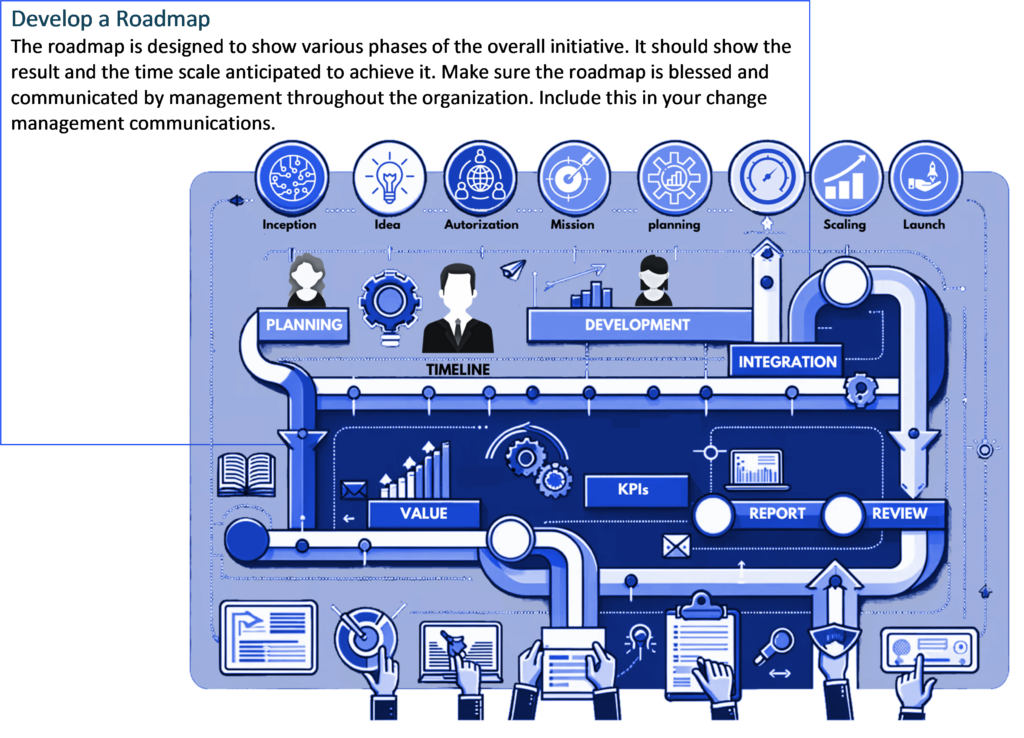

Case Study: ICON
As ICON developed its new tool/product to be introduced and sold to its anxious clients, we used a hybrid approach to Project management. We needed a high-level project schedule that we could use with the CEO and CFO to describe the project’s status and the product’s readiness for the market. However, in the development process, we needed to use the JIRA approach to design the sprints that accomplished the user stories and epics of the development process.
We developed a clear communication plan that outlined the frequency of the various project team meetings, the purpose of each meeting, and the reporting method for each. Also, because so many organizations and entities were involved, we collaborated with Microsoft TEAMS and SharePoint so that every member of the various teams could see the progress/changes being maintained.
The timekeeping process produced the charges by each of the many organizations involved in the development process, allowing us to report against the budget for the overall project.
We selected a vendor to help implement routine sales processing and delivery management. Using a formal vendor, SAAS allowed us to develop and operate faster in selling and delivering this new product.

Exercise: NEWco

Course Manual 10: Legal & Compliance Considerations
Several legal and compliance concerns must be addressed when a company builds a new software product or solution, especially one that fosters innovation and growth. These concerns are crucial to ensure the product’s success and to avoid potential legal pitfalls. Here’s a detailed exploration of some critical areas:
Intellectual Property (IP) Rights
The first step in developing a new software product involves clearly understanding and managing intellectual property rights. This includes ensuring the software does not infringe on other entities’ patents, copyrights, or trademarks. Companies must conduct thorough IP audits and possibly obtain licenses for using proprietary technology owned by third parties. Additionally, protecting the new software through patents or copyrights can safeguard against competitors copying innovations. It’s also essential to manage the IP rights related to any open-source components used in the software to comply with their respective licenses.
Data Privacy and Protection
With increasing global attention on data privacy, any software that handles personal or sensitive data must comply with relevant data protection regulations such as the General Data Protection Regulation (GDPR) in the EU or the California Consumer Privacy Act (CCPA) in the U.S. These regulations dictate how data must be collected, processed, and stored, and require companies to implement stringent measures to protect user data. Failure to comply can result in hefty fines and damage to the company’s reputation. Therefore, incorporating privacy by design into the software development process is essential.
Compliance with Industry Standards
Depending on the industry and the software’s nature, specific standards and regulations may need to be followed. For example, software products used in the healthcare sector must comply with Health Insurance Portability and Accountability Act (HIPAA) standards in the U.S. In contrast, financial software must adhere to regulations like the Payment Card Industry Data Security Standard (PCI DSS). Compliance ensures legal protection and builds trust with customers who rely on the software for critical operations.
Export Controls and International Regulations
If the software is intended for a global market, the company must navigate various international laws and export controls. This includes complying with the U.S. Export Administration Regulations (EAR) and International Traffic in Arms Regulations (ITAR). These regulations control the countries to which software can be exported and prevent the dissemination of technology that could be used in weapons of mass destruction. Understanding and complying with these rules is vital for companies aiming to operate internationally without legal repercussions.
Cybersecurity Measures
Finally, as cybersecurity threats evolve, ensuring the software is secure against breaches is paramount. This involves implementing best practices in software development, such as regular security audits, vulnerability testing, and updates. Furthermore, depending on the sector the software serves, there might be regulatory requirements for cybersecurity. For instance, the EU’s Network and Information Systems (NIS) Directive imposes specific security and notification requirements on digital service providers.
Addressing these legal and compliance concerns is not just about avoiding legal issues; it’s also about building a robust, reliable, and trustworthy software product that customers can depend on. Each area requires careful consideration and often the expertise of legal professionals and compliance officers to navigate successfully.
Navigating the legal and regulatory landscapes in Europe and the US is crucial for businesses, especially those in technology and software. This chapter addresses critical areas of compliance that impact such companies, including data protection, insurance, intellectual property, and general legal compliance.
Data Protection
Data protection has become a cornerstone of business operations as organizations increasingly rely on digital data, including sensitive personal information. While the regulatory landscapes in Europe and the US share a common goal of protecting this data, they approach the regulations differently.
Europe – The General Data Protection Regulation (GDPR):
The General Data Protection Regulation (GDPR) is one of the world’s most stringent privacy and security laws, imposing obligations on organizations worldwide that target or collect data related to people in the EU. The GDPR mandates high protection and gives individuals substantial control over their data.
One essential requirement is consent. Individuals must explicitly consent to the processing of their data, and this consent can be withdrawn at any time. This ensures that individuals have a say in how their information is used.
The GDPR also includes the right to access, allowing individuals to know exactly what information is being collected about them and how it is being processed. This transparency is crucial for maintaining trust and ensuring accountability.
Another important aspect is the right to be forgotten, which allows individuals to demand the deletion of their data under certain conditions. This right ensures that personal information is not retained longer than necessary or misused.
The GDPR also provides data portability, enabling individuals to receive and transfer their data to another controller. This provision ensures that individuals have control over their information and can move it freely as they see fit.
Overall, the GDPR sets a high standard for data protection and empowers individuals with significant rights over their personal information.
United States – A Patchwork of Laws:
Unlike the EU, the United States does not have a comprehensive federal data protection law similar to the GDPR. Instead, it relies on a patchwork of federal and state laws addressing various aspects of data protection.
Federal laws cover specific sectors. For example, the Health Insurance Portability and Accountability Act (HIPAA) regulates data protection in healthcare, while the Gramm-Leach-Bliley Act (GLBA) applies to financial services. These laws set standards for handling sensitive information within their respective industries.
State laws also play a significant role in data protection. For instance, the California Consumer Privacy Act (CCPA) provides California residents with transparency and control over their data, sharing some similarities with the GDPR. Other states are beginning to adopt similar regulations, contributing to the diverse landscape of data protection laws nationwide.
Additionally, sector-specific regulations govern specific industries, requiring companies to implement measures to ensure data security and integrity. These regulations ensure that businesses within these sectors adopt best practices to protect personal information and maintain data integrity.
The U.S. approach to data protection is characterized by a mixture of federal and state laws and sector-specific regulations, creating a complex legal framework for data privacy and security.
Implementing Data Protection Measures:
Organizations across Europe and the United States must be vigilant in data protection practices, and compliance requires a multifaceted approach.
One critical step is appointing Data Protection Officers (DPOs) . Many organizations, particularly those operating under the GDPR, must appoint a DPO to oversee data protection strategies and ensure compliance. The DPO is responsible for monitoring internal compliance, informing and advising on data protection obligations, and acting as a contact point for data subjects and supervisory authorities.
Data Protection Impact Assessments (DPIAs) are another essential measure, particularly under the GDPR. DPIAs are required for processing operations that present high risks to the rights and freedoms of data subjects. These assessments help organizations identify and mitigate potential privacy risks before they materialize.
Transparent privacy policies are essential for compliance with GDPR and state laws like the CCPA. These policies require organizations to disclose their data processing and protection practices. This transparency helps build trust with data subjects by informing them about how their data is collected, used, and protected.
By implementing these measures, organizations can better ensure compliance with data protection regulations and safeguard the personal information of their customers and stakeholders.
Navigating the complexities of data protection requires a robust understanding of the legal obligations in each jurisdiction where an organization operates. It is crucial to not only comply with these regulations but also to embrace a culture of data protection that respects and safeguards consumer information as a default standard. This commitment helps build customer trust and enhances your company’s reputation as a secure and responsible entity.
Data Breaches and Settlements
Data breaches have become a prominent risk for businesses globally, especially those handling sensitive customer and business information. In the digital age, where vast amounts of data are stored and transmitted across the internet, the potential for data breaches has escalated, posing significant threats to organizational integrity and security.
Impact of Data Breaches
A data breach can lead to severe consequences, including financial losses, damage to reputation, and legal liabilities. As a result, organizations may face various challenges.
Direct financial losses are often immediate and significant, including costs for rectifying the breach. These can involve IT remediation efforts, customer notifications, and increased security measures to prevent future incidents.
Indirect costs can also be substantial. A common consequence of data breaches is customer trust and loyalty loss, which can translate into reduced revenue as customers choose to take their business elsewhere. Rebuilding this trust can be a lengthy and costly process.
Regulatory fines pose another major risk. Regulatory bodies can impose significant penalties on organizations failing to adequately protect data. These fines add to the financial burden and highlight the organization’s failure to comply with data protection laws, further damaging its reputation.
Settlements and Regulatory Penalties
The financial repercussions of data breaches can be substantial, primarily due to settlements and fines. Under regulations like the European GDPR, companies can be fined up to 4% of their annual global turnover or €20 million, whichever is greater, for breaches. In the U.S., although there is no single federal law governing data breaches, various state laws, such as the California Consumer Privacy Act (CCPA), impose their penalties, which can be significant.
High-Profile Data Breach Cases
Several high-profile cases highlight the risks and costs associated with data breaches. One of the most significant breaches was the Equifax data breach, which affected approximately 147 million consumers. Equifax agreed to a settlement of up to $425 million to help those impacted by the breach. Another notable incident was the Yahoo data breach, which resulted in a $117.5 million settlement to compensate individuals affected by the series of breaches. Additionally, under GDPR, Google was fined €50 million for lack of transparency, inadequate information, and valid consent regarding ad personalization. These cases underscore the severe financial and reputational consequences that organizations can face due to data breaches.
Strategies to Mitigate Data Breach Risks
Organizations must adopt comprehensive strategies to minimize the risk of data breaches and potential settlements. One effective measure is data encryption, which ensures that data stored and in transit is protected from unauthorized access. Regular security audits are also crucial, as they help promptly identify and address system vulnerabilities. Employee training plays a vital role in cybersecurity, educating staff on best practices and the importance of data protection. Additionally, having a robust incident response plan allows an organization to react quickly and effectively upon discovering a data breach. Investing in cyber insurance can also provide financial coverage for costs associated with data breaches, offering another layer of protection for the organization. By implementing these strategies, organizations can significantly reduce their risk of data breaches and mitigate the impact if they occur.
The section should serve as a critical alert for businesses about the severe implications of data breaches and the importance of robust security practices. By understanding the potential financial, reputational, and legal impacts, companies can better prepare and implement adequate security measures to protect sensitive information and mitigate the risks associated with data breaches. This proactive approach not only aids in compliance with global data protection regulations but also reinforces the company’s commitment to safeguarding stakeholder interests.
Insurances
Businesses across Europe and the US must mitigate risks through comprehensive insurance coverage. Key policies include professional liability insurance, which covers legal liabilities, and cyber insurance, which is increasingly crucial in protecting against data breaches and cyber-attacks. Understanding each region’s insurance requirements and market standards protects businesses against claims and losses.
Intellectual Property (IP)
Intellectual Property (IP) rights in the information technology (IT) and software sectors are essential for protecting innovations and maintaining competitive advantages. Given the ease of replication and fast-paced innovation in these fields, understanding what can and cannot be protected under IP laws in different jurisdictions is crucial.
What Can Be Protected:
Patents:
US: In the United States, software can be patented if it meets specific criteria, including novelty, non-obviousness, and utility. The software must be part of a patentable process or machine, not merely an abstract idea.
EU: The European approach is more restrictive. Software is not patentable unless it provides a technical contribution to a field. Software patents are generally only granted if they solve a technical problem in a novel and non-obvious way.
Copyrights:
Both US and EU: Copyright protection is automatically granted upon the creation of original works of authorship, including software and related documentation. This gives the creator exclusive rights to use, copy, distribute, and modify the software. However, it does not protect ideas, procedures, processes, or methods of operation.
Trademarks:
US and EU: Trademarks protect symbols, names, and slogans to identify goods or services. In software, this can include logos, graphical user interfaces, and even unique user interaction methods, provided they identify the source of the software to consumers.
Trade Secrets:
US and EU: Trade secrets protect confidential business information that provides a competitive edge, such as algorithms, formulas, or compilations. Protection requires reasonable measures to keep the information secret and that the information derives value from its secrecy.
Real-World Examples of IP Protection in IT and Software:
Google’s Android Operating System:
• Patents: Google has patented critical features of Android, such as bypassing the lock screen with gestures, which enhances security and user experience.
• Copyrights: The Android codebase is copyrighted, preventing competitors from copying Google’s proprietary code.
Microsoft’s File System Technology:
• Patents: Microsoft has secured patents for technologies in its file systems, such as FAT and NTFS, which are crucial for the efficiency and reliability of its operating systems.
• Trademarks: Microsoft protects the names of its products, such as “Windows,” “Office,” and “Azure,” through trademarks, ensuring brand consistency.
Adobe’s Photoshop:
• Copyrights: Adobe holds copyrights on Photoshop’s source code and its distinct graphical interface and toolbar layout.
• Trademarks: The “Photoshop” name is trademarked, safeguarding the brand’s identity and preventing confusion.
SAP’s ERP Software:
• Trade Secrets: SAP keeps its ERP software algorithms and processes as trade secrets, providing a competitive edge.
• Patents: SAP holds patents on specific innovative processes used within its software, protecting them from competitors’ replication.
These examples demonstrate how companies in the IT and software industries leverage various forms of IP protection to secure their innovations and maintain a competitive edge in the market. They highlight the importance of a comprehensive IP strategy that includes patents, copyrights, trademarks, and trade secrets to effectively protect and capitalize on technological advancements.
What Cannot Be Protected:
• General Ideas and Concepts: Neither the US nor the EU allows for patenting mere ideas or concepts; there must be a tangible application or embodiment of the idea.
• Functionalities: Functional aspects of software, such as the functionality of an interface or a software feature, cannot be protected by copyright but might be covered by patents if they meet specific criteria.
• User Experience (UX) Design: While certain UX design elements may be protected under copyright if they are sufficiently original, the overall functionality and user experience as a concept are not protectable.
Intellectual Property Theft
Intellectual property (IP) theft involves the unauthorized use, reproduction, or distribution of intellectual assets without the owner’s permission. In the technology and software sectors, where innovation and proprietary technology drive competitive advantage, IP theft can devastate business revenue, brand reputation, and market position.
IP theft can manifest in various forms, each posing unique challenges and threats. Corporate espionage involves the theft of trade secrets or confidential information by individuals or competitor companies, often to gain a competitive edge. Counterfeiting and piracy refer to the unauthorized copying and selling of patented or copyrighted products, significantly impacting the revenue of original creators. Patent infringement occurs when a party makes, uses, or sells a patented invention without authorization, often involving critical software functionalities and innovative technologies in the tech sector.
The consequences of IP theft extend beyond financial losses. Market disruption occurs when unauthorized, counterfeit products saturate the market, devaluing genuine products and disrupting business operations. Loss of R&D investment is another significant impact, as companies invest heavily in research and development, and IP theft undermines these investments, potentially leading to reduced innovation and growth. Reputational damage can also result, as trust in a brand and customer loyalty can be severely damaged if IP theft leads to inferior or unsafe counterfeit products entering the market.
Effective strategies are essential for preventing IP theft and protecting business interests. Robust IP portfolio management involves regularly auditing and managing IP assets to ensure all valuable properties are adequately protected under the relevant categories of IP law. Implementing security measures, such as technological tools to protect digital IP assets, including data encryption and access controls, and physically securing R&D facilities is also crucial. Vigilantly monitoring the market for potential infringements and enforcing IP rights through legal action and enforcement, such as cease and desist orders, litigation, or seeking injunctions against infringers, is another crucial strategy. Educating employees about the importance of IP protection and using Non-Disclosure Agreements (NDAs) to safeguard sensitive information are also critical steps.
Intellectual property is a cornerstone of innovation and competitiveness in the technology and software industries. Protecting IP assets from theft is a legal necessity and a strategic imperative. By understanding the risks associated with IP theft and implementing comprehensive protective measures, businesses can secure their innovations, maintain market leadership, and continue to drive technological advancements. Addressing IP theft proactively ensures that the fruits of investment and creativity are preserved and that the business’s strategic interests are safeguarded in the long term.
Intellectual property is a cornerstone of innovation and competitiveness in the technology and software industries. Protecting IP assets from theft is a legal necessity and a strategic imperative. By understanding the risks associated with IP theft and implementing comprehensive protective measures, businesses can secure their innovations, maintain market leadership, and continue to drive technological advancements. Addressing IP theft proactively ensures that the fruits of investment and creativity are preserved and that the business’s strategic interests are safeguarded in the long term.
Compliance with Laws
Compliance extends beyond IP and data protection to encompass various regulatory requirements, including labor laws, environmental regulations, and anti-corruption laws. In Europe, businesses may also need to navigate EU-specific regulations affecting their operations across member states. Federal and state laws in the US can vary significantly, making compliance a complex, often localized issue. Companies must establish rigorous compliance programs that include training employees, monitoring adherence, and regularly reviewing and updating their practices to align with evolving laws.
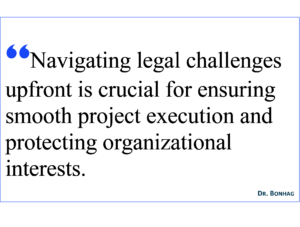
Summary
Navigating the legal and compliance landscapes is essential for technology and software companies operating in Europe and the US. This chapter has outlined the importance of robust data protection, safeguarded intellectual property, and adhered to a broad spectrum of regulatory requirements. Comprehensive measures protect sensitive information, secure innovations, build consumer trust, and protect businesses from potential legal disputes and hefty penalties.
Managing these legal and compliance challenges effectively is crucial for maintaining competitive advantages and ensuring business sustainability in international markets. By staying informed and proactive, companies can navigate these complexities, safeguard their assets, and foster growth in competitive environments.

Case Study: ICON
As we developed the new product for ICON, we were mindful of the US laws on Patents, trademarks, and data privacy. However, because ICON is an internal company serving clients worldwide, we became aware of the GDPR rules about patient data privacy that we must comply with. These requirements mandated a change in our patient consent. Our data storage has already complied with these rules. Understanding the laws of the road for our product to be used internationally was critical. Although, initially, the product was envisioned as a US-only product, in practice, our clients, the pharmaceutical companies, had patient studies in many parts of the world. This meant we needed to meet international legal requirements.

Exercise: NEWco

Course Manual 11: Change Management and Stakeholder Communications
Effective change management and strategic communication are pivotal in navigating the transitions associated with any initiative. This chapter outlines the approach to managing the change process, addressing risks, fostering desirable behavior changes, and developing a comprehensive communications plan to engage all stakeholders effectively.
Change Management Methodologies
Effective change management is essential for ensuring that organizational transformations are successful and sustainable. Structured change management methodologies provide a framework for planning, implementing, and monitoring change to achieve desired outcomes. These methodologies are designed to address change’s human and operational aspects, ensuring smooth transitions and alignment of the workforce with the new direction.
Prosci ADKAR Model
One of the most recognized change management methodologies is the Prosci ADKAR Model. It is a goal-oriented change management model that guides individual and organizational change through five sequential steps:
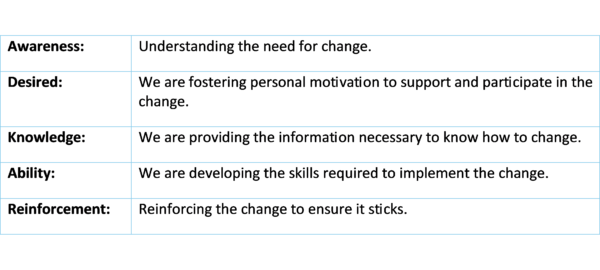
This model emphasizes the importance of addressing the people side of change and is particularly useful in helping change leaders and managers drive successful outcomes by focusing on the elements that directly impact employees’ engagement and ability to change.
Kotter’s 8-Step Process
Developed by Dr. John Kotter, this framework provides a more comprehensive approach to managing complex changes:
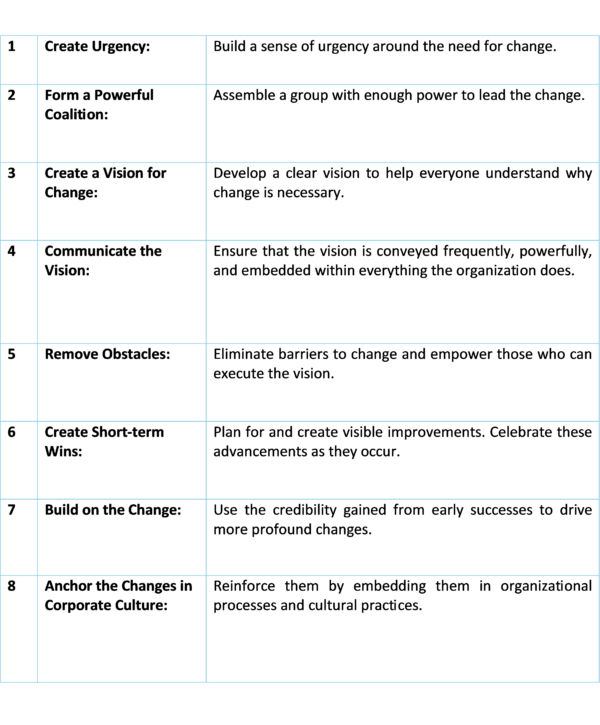
Lewin’s Change Management Model
This foundational model consists of three key stages:

McKinsey 7-S Model
This model focuses on aligning seven critical elements of an organization to ensure success:
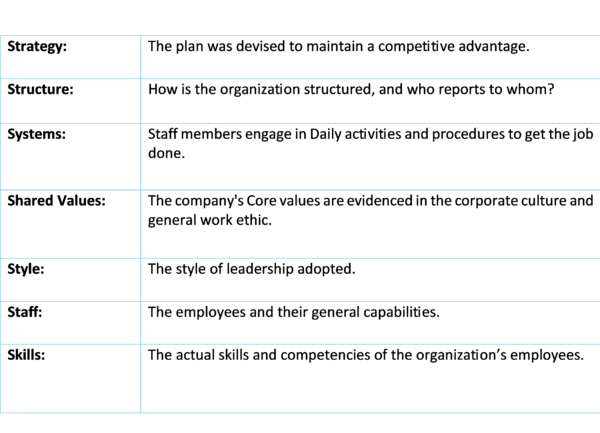
Implementing Structured Change Management
Implementing structured change management methodologies involves several critical steps. First, an assessment of the change’s impact must be conducted to understand its depth and breadth. This helps identify the areas that will be most affected and the resources required to manage the transition.
Next, a stakeholder analysis will be carried out, and all affected parties will be engaged to foster support and mitigate resistance. Engaging stakeholders early and often ensure their concerns are addressed and their support is secured, which is crucial for the change initiative’s success.
Developing a communication plan is essential for addressing every stakeholder group’s needs, concerns, and feedback. A well-crafted communication strategy ensures everyone is informed and aligned with the change process, reducing uncertainty and resistance.
Another vital step is providing targeted training and support. Training ensures stakeholders have the knowledge and skills to engage with the change effectively. Resources and support systems help stakeholders transition smoothly and confidently.
Finally, monitoring and adjusting the process continuously is crucial. By tracking progress and outcomes, organizations can make necessary adjustments to ensure the change achieves its goals. This iterative process allows flexibility and responsiveness, addressing issues and keeping the change initiative on track.
By employing these structured methodologies, organizations can ensure a systematic approach to managing change that addresses operational adjustments and profoundly considers the human element, significantly increasing the likelihood of successful and lasting transformations.
Behavior Change Desired
This section delves into the human dimensions of change management by identifying potential emotional and psychological responses to change. It outlines the behaviors the organization expects to encourage and foster and strategies to mitigate resistance and fear among employees and stakeholders.
Understanding Mindset Barriers and Fears:
Understanding and addressing mindset barriers and fears is crucial in change management. It involves identifying common employee concerns such as fears about job security, adapting to new responsibilities, or uncertainties about the future. Additionally, recognizing mindset barriers that hinder the adoption of new behaviors is vital, including the challenge of shifting from a fixed to a growth mindset or overcoming resistance to new technologies. Addressing these fears and barriers can facilitate a smoother transition and foster a more receptive environment for change.
Encouraging Desired Behaviors:
To encourage desired behaviors post-change, it’s essential to clearly define the target behaviors that you aim to promote, such as enhanced collaboration, more significant innovation, and proactive engagement with challenges. Alongside defining these behaviors, developing effective reinforcement strategies is crucial. These can include comprehensive training programs, tailored incentive schemes, and recognition systems that are precisely aligned with and support the cultivation of these new behaviors. This dual approach ensures that desired behaviors are articulated and actively encouraged and rewarded within the organization.
Strategies to Overcome Resistance:
Transparent and continuous communication is essential to overcoming resistance to change. Clearly explain the reasons for the change, its benefits, and how it will improve individual and organizational performance. This builds understanding and reduces uncertainty among employees.
Establishing support structures, such as mentoring, coaching, and peer support networks, helps individuals navigate the change more effectively. These systems provide guidance and assistance, making the transition more manageable.
Engagement activities like workshops and seminars are crucial. These events directly address fears and barriers, allowing employees to dialogue, co-create solutions, and build buy-in. Involving employees in the process fosters a sense of ownership and commitment to the change.
Implementing a system for continuous feedback is vital. This allows employees to voice their concerns and suggestions, ensuring their perspectives are heard and considered. Based on this feedback, adapt and refine change management strategies to remain relevant and practical. This iterative approach helps maintain alignment with employee expectations and enhances the overall effectiveness of the change initiative.
Communications Plan
The communications plan is pivotal in effective change management by ensuring that all stakeholders are well-informed and actively engaged throughout the change process. This comprehensive plan outlines the communication objectives, key messages, target audiences, preferred communication channels, and detailed timelines, ensuring a structured and strategic approach to messaging.
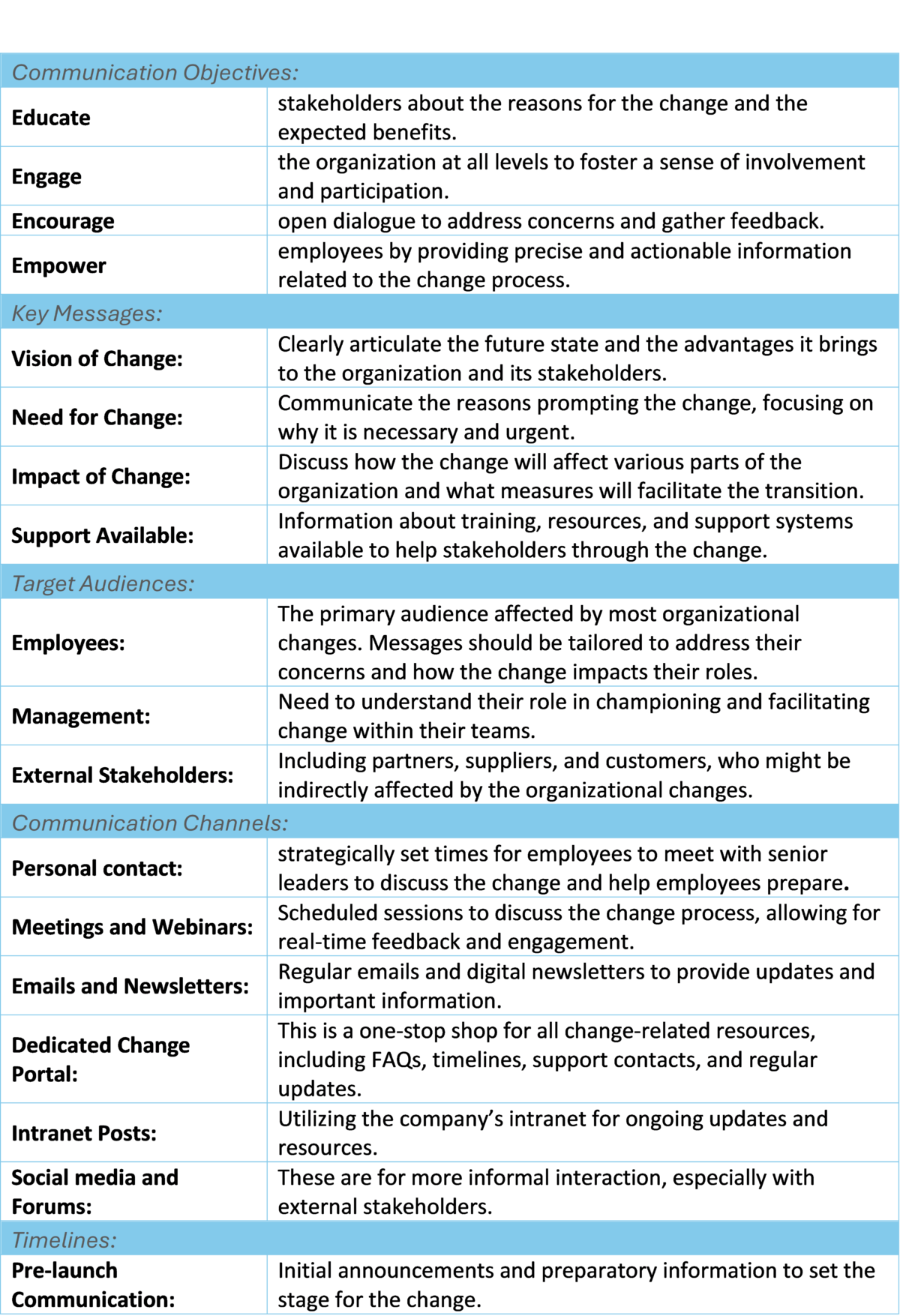
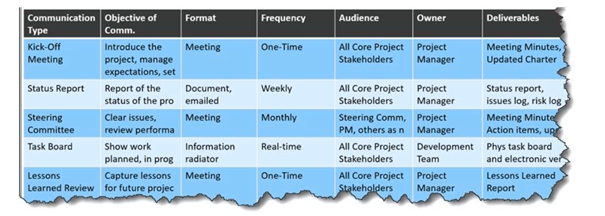
Feedback to Stakeholders
Consistent and transparent reporting keeps stakeholders informed and engaged throughout the change process. This involves establishing a structured reporting system that includes regular updates on progress, challenges, and milestones. The reports should be tailored to the needs of different stakeholder groups, ensuring that information is relevant and accessible. Utilizing digital dashboards, scheduled briefings, and interactive platforms can enhance the visibility of the change process, allowing stakeholders to see real-time progress and fostering a sense of involvement and transparency.
To achieve this, consider establishing a systematic reporting mechanism that could include the following components:
• Digital Dashboards:
Implement digital dashboards that provide real-time data visualization of the change process. Tools like Microsoft Power BI or Tableau can create interactive dashboards that show key performance indicators (KPIs), progress metrics, and other relevant data. These dashboards should be accessible to all stakeholders and designed to allow users to drill down into specific data points for detailed analysis.
• Progress Tracking Tools:
Use project management software like Asana, Trello, or Microsoft Project to track the progress of different components of the change process. These tools can help manage tasks, assign responsibilities, and set deadlines, all of which can be organized and reported back to stakeholders.
Incorporate Gantt charts or similar tools to visually represent the project timeline, showing what has been completed and is still pending.
• Automated Reporting Systems:
Consider implementing automated reporting systems to generate and distribute reports at predefined intervals. Automation helps reduce the manual labor involved in report preparation and ensures timely information delivery.
Automated alerts can also be set up to notify stakeholders about critical issues or completed milestones, keeping everyone informed without delay.
• Stakeholder-Specific Reporting:
Tailor reports to the specific needs of different stakeholder groups. For example, executive stakeholders may require high-level overviews focusing on strategic implications and ROI, whereas project teams might need detailed reports on day-to-day operations and task completion.
Utilize feedback from stakeholders to continually refine the reporting process, ensuring that the reports meet their needs and enhance their understanding of the change process.
Risk of Change
Addressing the risks associated with change is critical to any change management strategy. Properly managing these risks ensures the stability and success of the change process and helps maintain stakeholder confidence.
Risk Identification:
Begin with a thorough risk assessment to identify potential risks associated with the change. This process involves gathering input from all levels of the organization to understand various perspectives and possible concerns. Once the risks are identified, classify them based on their nature and impact. Common categories include operational, technological, financial, and reputational risks. This classification helps prioritize and address risks effectively, ensuring that the most critical issues are managed first to minimize potential negative impacts on the organization.
Risk Analysis:
For each identified risk, evaluate its likelihood of occurrence and potential impact on the project and the organization. Utilize tools like risk matrices or scoring systems to quantify and prioritize these risks, ensuring a structured and objective approach to risk management. Additionally, engage in scenario planning for high-priority risks to visualize possible outcomes and plan appropriate responses. This process helps understand the full scope of each risk and prepares the organization for different eventualities.
Monitoring and Reporting:
Establish a system for continuous monitoring of risk indicators to allow for the early detection of potential issues as they arise. This proactive approach can significantly reduce the severity of risk impacts by enabling timely interventions. Furthermore, risk reporting should be integrated into the regular reporting framework to keep stakeholders informed about potential risks, current risk levels, and the actions being taken. This transparency fosters trust and ensures that all parties are aware of and prepared for any challenges that may arise.
Maintaining Transparency and Building Trust:
Transparency in communications builds trust. Be honest about the challenges and realistic about the benefits, ensuring stakeholders understand the change’s positive and potentially negative aspects.
Allow stakeholders to voice their concerns and contribute ideas, making them feel valued and heard.
By maintaining a structured and interactive approach to communications, the change management process can achieve greater clarity, reduced resistance, and more substantial alignment within the organization, thereby enhancing the likelihood of successful change implementation.
Communication management plan example
The Communication Management Plan, as detailed by the Project Management Institute (PMI), is a vital component of any project management strategy, especially within the context of structured change management. This plan effectively outlines how communication should be handled throughout the lifecycle of a project or organizational change initiative. Here’s a closer look at how a Communication Management Plan is structured and why it’s crucial according to PMI guidelines:
The primary purpose of the Communication Management Plan is to define the communication requirements and the flow of project information for all stakeholders involved in a project. It serves as a roadmap for how information will be shared, with whom, when, and through what channels, ensuring everyone involved has the necessary information to contribute effectively and make informed decisions.
Summary:
This chapter underscores the importance of effective change management and strategic communication in ensuring successful organizational transformations. It presents structured methodologies such as the Prosci ADKAR Model, Kotter’s 8-Step Process, Lewin’s Change Management Model, and the McKinsey 7-S Model, highlighting their utility in managing both the human and operational aspects of change.
The chapter also emphasizes the necessity of a robust communications plan to keep all stakeholders informed and engaged, utilizing tools like digital dashboards and automated reporting systems to enhance transparency and involvement. Risk management is discussed with strategies for identifying, analyzing, and mitigating risks, ensuring the stability and success of the change process.
Finally, it highlights the importance of continuous feedback and adaptation of strategies based on stakeholder input, which ensures that change initiatives remain relevant and effective.
In essence, this chapter provided a comprehensive framework for navigating change management and stakeholder communications, essential for fostering a culture that embraces improvement and drives sustainable organizational success.
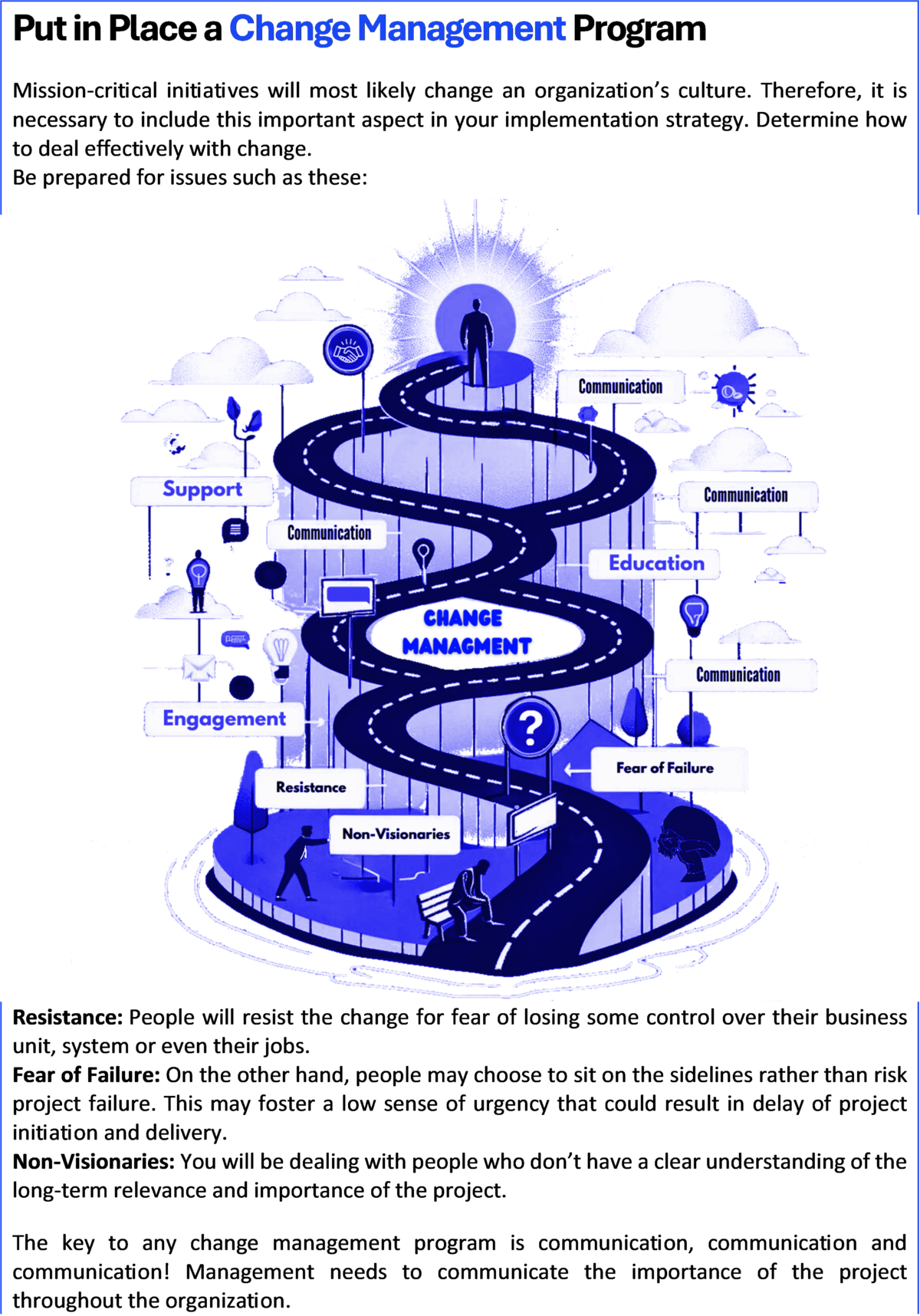

Exercise: NEWco
– Behavioral Changes: Identify one critical behavior NewCo seeks to promote and outline a strategy to encourage this behavior.
– Communications Plan: Describe a streamlined communications plan detailing essential messages and the primary channel for different stakeholder groups
– Feedback to Stakeholder Strategy: Choose an essential tool for updating stakeholders on the progress and challenges.

Course Manual 12: Scalability and Overview
The ability to scale and adapt becomes critical in an ever-evolving business landscape. This chapter delves into the essentials of scalability and flexibility, focusing on technological and business system scalability. As we innovate, organizations must address the growth for which the systems are created. These dimensions enable businesses to grow effectively and respond to changing market demands.
Computer System Scalability
Scalability is crucial for systems that handle increasing workloads without compromising performance. It involves several critical factors, each contributing to the system’s ability to grow and adapt efficiently. Below are detailed insights into these factors, with practical examples illustrating their importance.
• System Architecture
The architecture of a system plays a foundational role in its scalability. It must be designed to support scaling up (enhancing the capacity of existing components) and scaling out (adding more components in parallel).
Example: A web application might initially run on a single server but can be scaled out by adding more servers as user demand increases. Similarly, scaling up can be achieved by upgrading existing servers with more powerful CPUs and additional RAM.
• Resource Management
Efficient resource management ensures that all system components optimally use computational resources such as CPU, memory, and storage. This is particularly crucial in environments with extensive data or high transaction rates.
Example: In cloud computing, resource management might involve auto-scaling features that automatically adjust resource allocation based on real-time demand, ensuring that the system uses resources efficiently and reduces costs.
• Load Distribution
Load distribution involves spreading work evenly across a system to avoid overloading any single component. Implementing effective load-balancing solutions is essential for this.
Example: A load balancer can distribute incoming network traffic across multiple servers to ensure no single server becomes a bottleneck. This is commonly used in large-scale web services, such as those provided by Amazon or Google, to handle millions of simultaneous requests.
• Data Scalability
As systems scale, the amount of data they handle can grow exponentially. Managing this data efficiently is crucial to maintaining performance.
Examples:
Database Sharding: This involves dividing a database into smaller, more manageable pieces or shards, each of which can be hosted on different servers. This approach can significantly improve performance by reducing the load on any single server and allowing queries to run in parallel across multiple shards.
NoSQL Databases: Platforms like MongoDB or Cassandra are designed to scale out by distributing data across many servers, offering flexibility and high data availability.
• Flexibility in Integration
A scalable system should also be flexible, allowing easy integration with new and evolving technologies. This facilitates upgrades and modifications without significant overhauls.
Example: A modular system architecture, where components communicate through well-defined interfaces, can easily integrate with new modules or third-party systems. For instance, an e-commerce platform might integrate with various payment gateways and shipping services as it expands globally, requiring systems that can quickly adapt to new integrations.
Understanding these scalability factors is crucial for developing robust and adaptable systems to meet growing demands. Organizations can ensure that their systems remain efficient and cost-effective as they expand by focusing on scalable architecture, efficient resource management, effective load distribution, data scalability, and integration flexibility. These principles are foundational for IT infrastructure and supporting business strategies that rely on technological agility and responsiveness.
How to Test Technology Scalability
Testing for scalability is crucial to ensure a system can handle increased loads and maintain performance as it grows. The following methods are employed to evaluate the scalability of a system rigorously:
• Load Testing
Load testing involves simulating real-world load conditions to observe how the system performs under increased stress. This type of testing helps identify an application’s maximum operating capacity and any bottlenecks that could impede scalability.
Example: An e-commerce site may undergo load testing by simulating thousands of simultaneous users accessing the site during a sale event to ensure the system can handle peak traffic without crashing or slowing down significantly.
• Stress Testing
Stress testing pushes the system beyond its normal operational limits to see how it handles extreme conditions. This test is crucial for determining the system’s robustness and capacity to manage unexpected surges in load.
Example: A cloud storage service might be stress-tested by uploading and downloading massive amounts of data simultaneously to ensure the system does not fail under extreme conditions.
• Performance Testing
Regular performance testing assesses a system’s efficiency under normal conditions and ensures that new updates or enhancements do not degrade it.
Example: After updates or patches, a database system may undergo performance testing to verify that query response times and transaction processing speeds meet expected performance standards.
• Capacity Testing
Capacity testing determines the maximum capacity a system can handle before its performance begins to degrade. This helps identify potential scalability limits, providing insights into how well the system can grow to meet future demands.
Example: A video streaming service performs capacity testing to determine how many simultaneous streams it can support before the quality of service begins to decrease.
• Real-Time Monitoring
Advanced monitoring tools can provide continuous oversight of the system’s operational status. This is essential for identifying real-time performance changes and making proactive adjustments to optimize performance and scalability.
Example: Network monitoring tools in an IT infrastructure might continuously monitor traffic load and latency, allowing IT teams to adjust resources dynamically based on current demand levels.
Business Process Scalability
Scaling a business effectively involves several key considerations to ensure the operational aspects accommodate growth. The first area to focus on is business processes. Streamlining systems and methods, and often automating them, can handle a higher volume of work without proportional increases in errors or bottlenecks. This not only prepares your business for growth but also optimizes your operations, paving the way for a more efficient and successful future. This might involve adopting new software tools, enhancing workflows, or implementing more sophisticated project management approaches.
Human resources play a pivotal role in scaling a business. It’s not just about hiring more staff, but also about ensuring their integration and productivity. This involves effective HR processes, including recruitment, onboarding, training, and retention strategies, which are crucial for maintaining productivity and morale.
Maintaining high-quality customer service is not just a challenge, but a crucial aspect as the customer base grows. Scaling may require enhanced customer service tools, more staff, or expanded hours of operation to ensure customer satisfaction remains high. Financial management is also vital. As the business grows, so do the complexity of transactions and the volume of sales and expenses. This could involve adopting more sophisticated accounting software, seeking professional financial advice, or establishing a dedicated finance department.
Legal and compliance challenges increase with business growth. Issues may range from international trade laws if expanding overseas to more stringent data protection regulations. Practical legal and compliance management is crucial to mitigate these risks and ensure smooth business operations.
Supply chain management must also scale with increased demand for products or services. This may mean finding new suppliers, negotiating better terms with existing suppliers, or investing in logistics to improve distribution efficiency. Similarly, marketing and sales efforts need to expand to reach new customers and effectively enter new markets.
Adaptability and continuous improvement are not just desirable, but essential for a scalable business. Learning from data and feedback to continuously improve products, services, and processes ensures ongoing relevance and competitiveness. Maintaining a solid and cohesive company culture becomes more challenging but remains essential as organizations grow. Leadership must also scale, focusing on developing leaders who embody and promote the company’s values and vision.
Considering these areas helps ensure a business grows sustainably and maintains or even improves its effectiveness and efficiency. Efficiently managing an increased volume of transactions requires systems designed for scalability, providing robust performance as transaction volumes escalate. This section outlines key strategies to enhance system capabilities to support business expansion without compromising efficiency or performance.
Automating Scalability
Automation in scalability is crucial for seamlessly adapting to fluctuating demands. Cloud-based elastic services exemplify this strategy by dynamically allocating resources in response to real-time usage and system load. This flexibility ensures that the infrastructure can scale up during peak periods and scale down when demand wanes, optimizing resource utilization and operational costs.
Optimizing Workflows
Optimizing workflows is essential to manage increased transactions efficiently. This process eliminates redundant steps, automates routine tasks, and ensures seamless communication across different system components. By streamlining these processes, businesses can enhance throughput and reduce the time it takes to complete transactions, thereby improving overall operational efficiency.
Enhancing Transaction Processing
Advancements in database management and processing algorithms are pivotal in supporting transaction growth. Upgrading to more robust database systems capable of handling larger volumes of data and faster query processing is critical. This might involve enhancing database architectures or integrating more efficient data handling and processing techniques. Such improvements ensure that as transaction volumes increase, the systems remain fast and reliable, providing quick responses to database queries and maintaining a high level of service performance.
Changing Needs
In today’s fast-paced market, adaptability to changing needs is crucial for maintaining a competitive edge. Businesses must be agile and flexible in managing technological and operational adjustments. Adaptability can be enhanced through agile methodologies, modular design, process improvement, and continuous feedback loops.
Process improvement is vital, including operational models that provide what-if analyses of various assumptions to address changing environments. The innovation plan’s basis must be analyzed to ensure the final product meets market demand. Implementing iterative development cycles involves regular testing, feedback, and revisions to improve product features and address user needs steadily.
Adaptive planning techniques are also essential for adjusting strategies and resource allocation based on feedback and changing requirements. Building cross-functional teams that bring together diverse skills and perspectives enhances the ability to quickly innovate and respond to changes. Establishing robust feedback mechanisms is critical for continually adapting to user needs and market changes. Continuous feedback loops engage users and stakeholders in the development process, ensuring that their input and experiences directly influence product enhancements and innovation.
Regularly collecting user feedback through surveys and analyzing user interaction data provides actionable insights that drive product development. Frequent review sessions with stakeholders to discuss current progress, challenges, and strategic directions help align the development process with broader business objectives. By adopting these strategies, businesses can remain agile and responsive, ensuring their products and services continue to meet evolving market needs.
Changing Technology
In today’s rapidly evolving marketplace, staying ahead of technological advancements is crucial for maintaining competitive advantage and ensuring sustainability. Businesses must proactively identify, evaluate, and integrate emerging technologies to enhance their operational efficiency, product offerings, and overall market position. Here’s a look into how organizations can harness these advancements effectively.
Regular engagement with emerging technologies such as Artificial Intelligence (AI), the Internet of Things (IoT), and blockchain is essential. These technologies can transform business models and processes, offering new ways to connect with customers, streamline operations, and secure transactions. In addition, competitors may produce other applications that meet the need or be first to market. Novel applications may meet a portion of your customers’ needs and must be integrated into your solution.
Summary
Effectively managing business and transaction growth requires a strategic approach to system design and process optimization. By focusing on automating scalability, streamlining workflows, and enhancing transaction processing capabilities, businesses can ensure they are well-prepared to handle increased operational demands. These strategies are integral to maintaining performance standards and supporting sustainable business growth.
Adapting to changing requirements is not just about implementing new technologies or processes; it’s about cultivating an organizational culture that values flexibility, responsiveness, and continuous improvement. By integrating agile methodologies, leveraging modular design, and establishing constant feedback loops, businesses can remain responsive and resilient in the face of change, thereby maintaining their competitive advantage in a dynamic market environment.
Staying abreast of technological advancements is not merely about adopting new tools; it involves a strategic commitment to innovation and continuous improvement. Businesses can remain at the forefront of their industries by actively engaging with emerging technologies, leveraging them for product and service enhancement, and investing in R&D. This proactive approach drives business growth and helps adapt to and shape future market trends.
This chapter has provided a comprehensive understanding of scalability, which is crucial for supporting business growth and technological advancement. We explored scalability from system architecture to data scalability, illustrating how each aspect effectively helps systems handle increased demands.
As we progress, remember that scalability is critical to long-term business resilience and success. It enables companies to grow seamlessly and integrate new technologies, maintaining efficiency and competitiveness in a dynamic market environment.
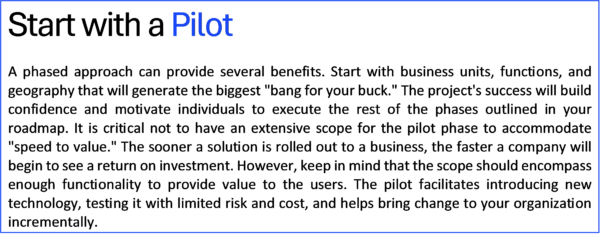
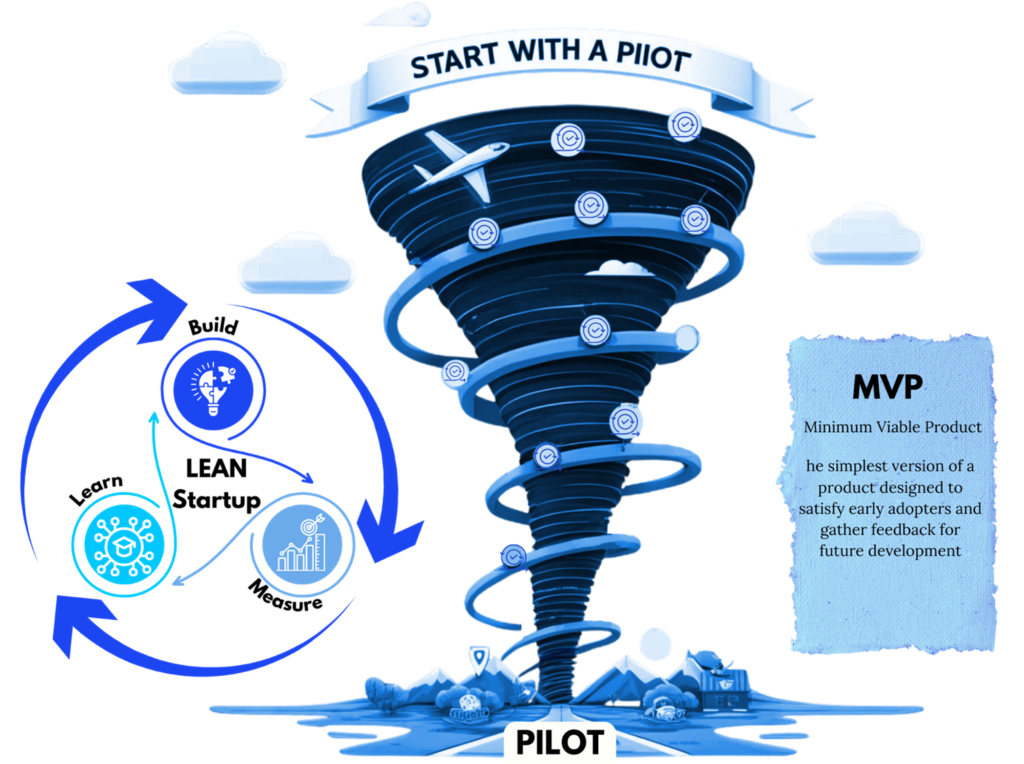

Exercise: NEWco
– Reflect on the entire journey of NEWco, from conceptualization to execution. What key lessons were learned regarding strategic sourcing, and how can these insights be applied to future projects to enhance effectiveness and avoid past pitfalls?
– Are you clear on what you are to do in NEWco?
– How will you organize the program?
– As the program manager, what steps will you take to ensure that the team will collaborate and communicate?
– What tools need to be in place to maximize the effectiveness of your program management and for your sponsors?
Conclusion: Determining Value
Thank you for participating in the first session of our 12-part workshop series on strategic sourcing. This workshop, centered on “Determining Value,” provided an essential framework for identifying, assessing, and enhancing the value your sourcing operations deliver to your organization. Here’s a recap of today’s enriching session:
We began by defining value in the context of strategic sourcing, focusing on its pivotal drivers, such as cost efficiency, quality, and innovation. This discussion helped set the stage for a deeper exploration of how strategic sourcing impacts overall business success.
Today’s workshop introduced various analytical tools and techniques to measure and analyze sourcing value. Participants engaged in hands-on exercises that applied these methodologies to real-world scenarios, illustrating their practical application in everyday business activities.
We delved into a series of case studies showcasing successful sourcing strategies implemented by leading organizations. These examples brought to life the theories and practices discussed, providing a clearer picture of how strategic sourcing can drive significant business outcomes.
To ensure a dynamic and engaging learning experience, the workshop included twelve “challenges” or exercises and decision-making activities. These interactive elements were designed to deepen your understanding of the concepts discussed and enhance your ability to apply them effectively in your contexts.
Today’s insights lay a solid foundation for aligning sourcing strategies with broader business objectives. By integrating strategic sourcing with overall business goals, you are better positioned to enhance your organization’s competitive edge and market position. We hope that the strategies and tools explored today will inspire you to rethink and refine your approach to sourcing, driving more excellent value and efficiency.
Looking Ahead:
We look forward to continuing this journey through the complex landscape of strategic sourcing. Here’s what to expect in the upcoming workshops:
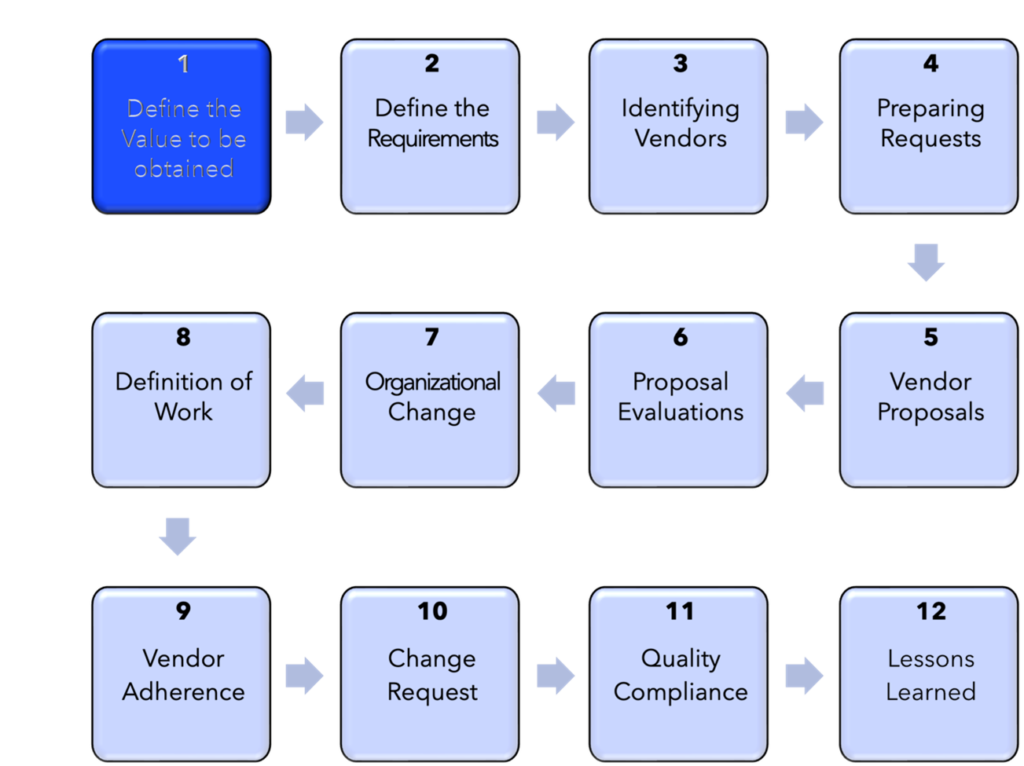
Each session will provide theoretical insights, practical applications, and interactive elements, such as case studies, real-world exercises, and simulations, to reinforce learning. We encourage you to engage deeply with the materials and discussions as each workshop builds on the previous one to create a comprehensive mastery of strategic sourcing.
Thank You
We appreciate your active participation and insights during today’s workshop. Your engagement is crucial as we delve deeper into the intricacies of strategic sourcing. We are excited to see how you apply today’s learnings to develop your skills in the upcoming workshops.
Project Studies
Project Study (Part 1) – Customer Service
The Head of this Department is to provide a detailed report relating to the Obtaining Value process that has been implemented within their department, together with all key stakeholders, as a result of conducting this workshop, incorporating process: planning; development; implementation; management; and review. Your process should feature the following 12 parts:
01. Value Identification and Alignment
02. Innovation
03. Definitions
04. Can We Do This Internally?
05. Let’s Look at External
06. Mission and Objectives
07. Establish Authority to Proceed
08. Talent Management Strategies
09. Technology/Tools to Help
10. Legal & Compliance Considerations
11. Change Management and Stakeholder Communications
12. Scalability and Overview
Please include the results of the initial evaluation and assessment.
Project Study (Part 2) – E-Business
The Head of this Department is to provide a detailed report relating to the Obtaining Value process that has been implemented within their department, together with all key stakeholders, as a result of conducting this workshop, incorporating process: planning; development; implementation; management; and review. Your process should feature the following 12 parts:
01. Value Identification and Alignment
02. Innovation
03. Definitions
04. Can We Do This Internally?
05. Let’s Look at External
06. Mission and Objectives
07. Establish Authority to Proceed
08. Talent Management Strategies
09. Technology/Tools to Help
10. Legal & Compliance Considerations
11. Change Management and Stakeholder Communications
12. Scalability and Overview
Please include the results of the initial evaluation and assessment.
Project Study (Part 3) – Finance
The Head of this Department is to provide a detailed report relating to the Obtaining Value process that has been implemented within their department, together with all key stakeholders, as a result of conducting this workshop, incorporating process: planning; development; implementation; management; and review. Your process should feature the following 12 parts:
01. Value Identification and Alignment
02. Innovation
03. Definitions
04. Can We Do This Internally?
05. Let’s Look at External
06. Mission and Objectives
07. Establish Authority to Proceed
08. Talent Management Strategies
09. Technology/Tools to Help
10. Legal & Compliance Considerations
11. Change Management and Stakeholder Communications
12. Scalability and Overview
Please include the results of the initial evaluation and assessment.
Project Study (Part 4) – Globalization
The Head of this Department is to provide a detailed report relating to the Obtaining Value process that has been implemented within their department, together with all key stakeholders, as a result of conducting this workshop, incorporating process: planning; development; implementation; management; and review. Your process should feature the following 12 parts:
01. Value Identification and Alignment
02. Innovation
03. Definitions
04. Can We Do This Internally?
05. Let’s Look at External
06. Mission and Objectives
07. Establish Authority to Proceed
08. Talent Management Strategies
09. Technology/Tools to Help
10. Legal & Compliance Considerations
11. Change Management and Stakeholder Communications
12. Scalability and Overview
Please include the results of the initial evaluation and assessment.
Project Study (Part 5) – Human Resources
The Head of this Department is to provide a detailed report relating to the Obtaining Value process that has been implemented within their department, together with all key stakeholders, as a result of conducting this workshop, incorporating process: planning; development; implementation; management; and review. Your process should feature the following 12 parts:
01. Value Identification and Alignment
02. Innovation
03. Definitions
04. Can We Do This Internally?
05. Let’s Look at External
06. Mission and Objectives
07. Establish Authority to Proceed
08. Talent Management Strategies
09. Technology/Tools to Help
10. Legal & Compliance Considerations
11. Change Management and Stakeholder Communications
12. Scalability and Overview
Please include the results of the initial evaluation and assessment.
Project Study (Part 6) – Information Technology
The Head of this Department is to provide a detailed report relating to the Obtaining Value process that has been implemented within their department, together with all key stakeholders, as a result of conducting this workshop, incorporating process: planning; development; implementation; management; and review. Your process should feature the following 12 parts:
01. Value Identification and Alignment
02. Innovation
03. Definitions
04. Can We Do This Internally?
05. Let’s Look at External
06. Mission and Objectives
07. Establish Authority to Proceed
08. Talent Management Strategies
09. Technology/Tools to Help
10. Legal & Compliance Considerations
11. Change Management and Stakeholder Communications
12. Scalability and Overview
Please include the results of the initial evaluation and assessment.
Project Study (Part 7) – Legal
The Head of this Department is to provide a detailed report relating to the Obtaining Value process that has been implemented within their department, together with all key stakeholders, as a result of conducting this workshop, incorporating process: planning; development; implementation; management; and review. Your process should feature the following 12 parts:
01. Value Identification and Alignment
02. Innovation
03. Definitions
04. Can We Do This Internally?
05. Let’s Look at External
06. Mission and Objectives
07. Establish Authority to Proceed
08. Talent Management Strategies
09. Technology/Tools to Help
10. Legal & Compliance Considerations
11. Change Management and Stakeholder Communications
12. Scalability and Overview
Please include the results of the initial evaluation and assessment.
Project Study (Part 8) – Management
The Head of this Department is to provide a detailed report relating to the Obtaining Value process that has been implemented within their department, together with all key stakeholders, as a result of conducting this workshop, incorporating process: planning; development; implementation; management; and review. Your process should feature the following 12 parts:
01. Value Identification and Alignment
02. Innovation
03. Definitions
04. Can We Do This Internally?
05. Let’s Look at External
06. Mission and Objectives
07. Establish Authority to Proceed
08. Talent Management Strategies
09. Technology/Tools to Help
10. Legal & Compliance Considerations
11. Change Management and Stakeholder Communications
12. Scalability and Overview
Please include the results of the initial evaluation and assessment.

Project Study (Part 9) – Marketing
The Head of this Department is to provide a detailed report relating to the Obtaining Value process that has been implemented within their department, together with all key stakeholders, as a result of conducting this workshop, incorporating process: planning; development; implementation; management; and review. Your process should feature the following 12 parts:
01. Value Identification and Alignment
02. Innovation
03. Definitions
04. Can We Do This Internally?
05. Let’s Look at External
06. Mission and Objectives
07. Establish Authority to Proceed
08. Talent Management Strategies
09. Technology/Tools to Help
10. Legal & Compliance Considerations
11. Change Management and Stakeholder Communications
12. Scalability and Overview
Please include the results of the initial evaluation and assessment.

Project Study (Part 10) – Production
The Head of this Department is to provide a detailed report relating to the Obtaining Value process that has been implemented within their department, together with all key stakeholders, as a result of conducting this workshop, incorporating process: planning; development; implementation; management; and review. Your process should feature the following 12 parts:
01. Value Identification and Alignment
02. Innovation
03. Definitions
04. Can We Do This Internally?
05. Let’s Look at External
06. Mission and Objectives
07. Establish Authority to Proceed
08. Talent Management Strategies
09. Technology/Tools to Help
10. Legal & Compliance Considerations
11. Change Management and Stakeholder Communications
12. Scalability and Overview
Please include the results of the initial evaluation and assessment.

Project Study (Part 11) – Logistics
The Head of this Department is to provide a detailed report relating to the Obtaining Value process that has been implemented within their department, together with all key stakeholders, as a result of conducting this workshop, incorporating process: planning; development; implementation; management; and review. Your process should feature the following 12 parts:
01. Value Identification and Alignment
02. Innovation
03. Definitions
04. Can We Do This Internally?
05. Let’s Look at External
06. Mission and Objectives
07. Establish Authority to Proceed
08. Talent Management Strategies
09. Technology/Tools to Help
10. Legal & Compliance Considerations
11. Change Management and Stakeholder Communications
12. Scalability and Overview
Please include the results of the initial evaluation and assessment.

Project Study (Part 12) – Education
The Head of this Department is to provide a detailed report relating to the Obtaining Value process that has been implemented within their department, together with all key stakeholders, as a result of conducting this workshop, incorporating process: planning; development; implementation; management; and review. Your process should feature the following 12 parts:
01. Value Identification and Alignment
02. Innovation
03. Definitions
04. Can We Do This Internally?
05. Let’s Look at External
06. Mission and Objectives
07. Establish Authority to Proceed
08. Talent Management Strategies
09. Technology/Tools to Help
10. Legal & Compliance Considerations
11. Change Management and Stakeholder Communications
12. Scalability and Overview
Please include the results of the initial evaluation and assessment.
Program Benefits
Management
- Improved procurement
- Enhanced selections
- Efficient requests
- Effective proposals
- Informed evaluations
- Skilled negotiations
- Strategic KPIs
- Effective reporting
- Improved quality
- Change management
Business Operations
- Procurement techniques
- Requirement elaboration
- Improved communications
- Improved results
- Reduced waste
- Operating efficiencies
- Customer satisfaction
- Improved quality
- Process improvement
- Operational synergy
Human Resources
- Compliance adherence
- Procurement leadership
- Improved alignment
- Team effectiveness
- Less miscommunications
- Performance improvement
- Employee recruitment
- Problem solving
- Improved focus on goals
- Reduced stress
Client Telephone Conference (CTC)
If you have any questions or if you would like to arrange a Client Telephone Conference (CTC) to discuss this particular Unique Consulting Service Proposition (UCSP) in more detail, please CLICK HERE.























